

30 Examples: How to Conclude a Presentation (Effective Closing Techniques)
By Status.net Editorial Team on March 4, 2024 — 9 minutes to read
Ending a presentation on a high note is a skill that can set you apart from the rest. It’s the final chance to leave an impact on your audience, ensuring they walk away with the key messages embedded in their minds. This moment is about driving your points home and making sure they resonate. Crafting a memorable closing isn’t just about summarizing key points, though that’s part of it, but also about providing value that sticks with your listeners long after they’ve left the room.
Crafting Your Core Message
To leave a lasting impression, your presentation’s conclusion should clearly reflect your core message. This is your chance to reinforce the takeaways and leave the audience thinking about your presentation long after it ends.
Identifying Key Points
Start by recognizing what you want your audience to remember. Think about the main ideas that shaped your talk. Make a list like this:
- The problem your presentation addresses.
- The evidence that supports your argument.
- The solution you propose or the action you want the audience to take.
These key points become the pillars of your core message.
Contextualizing the Presentation
Provide context by briefly relating back to the content of the whole presentation. For example:
- Reference a statistic you shared in the opening, and how it ties into the conclusion.
- Mention a case study that underlines the importance of your message.
Connecting these elements gives your message cohesion and makes your conclusion resonate with the framework of your presentation.
30 Example Phrases: How to Conclude a Presentation
- 1. “In summary, let’s revisit the key takeaways from today’s presentation.”
- 2. “Thank you for your attention. Let’s move forward together.”
- 3. “That brings us to the end. I’m open to any questions you may have.”
- 4. “I’ll leave you with this final thought to ponder as we conclude.”
- 5. “Let’s recap the main points before we wrap up.”
- 6. “I appreciate your engagement. Now, let’s turn these ideas into action.”
- 7. “We’ve covered a lot today. To conclude, remember these crucial points.”
- 8. “As we reach the end, I’d like to emphasize our call to action.”
- 9. “Before we close, let’s quickly review what we’ve learned.”
- 10. “Thank you for joining me on this journey. I look forward to our next steps.”
- 11. “In closing, I’d like to thank everyone for their participation.”
- 12. “Let’s conclude with a reminder of the impact we can make together.”
- 13. “To wrap up our session, here’s a brief summary of our discussion.”
- 14. “I’m grateful for the opportunity to present to you. Any final thoughts?”
- 15. “And that’s a wrap. I welcome any final questions or comments.”
- 16. “As we conclude, let’s remember the objectives we’ve set today.”
- 17. “Thank you for your time. Let’s apply these insights to achieve success.”
- 18. “In conclusion, your feedback is valuable, and I’m here to listen.”
- 19. “Before we part, let’s take a moment to reflect on our key messages.”
- 20. “I’ll end with an invitation for all of us to take the next step.”
- 21. “As we close, let’s commit to the goals we’ve outlined today.”
- 22. “Thank you for your attention. Let’s keep the conversation going.”
- 23. “In conclusion, let’s make a difference, starting now.”
- 24. “I’ll leave you with these final words to consider as we end our time together.”
- 25. “Before we conclude, remember that change starts with our actions today.”
- 26. “Thank you for the lively discussion. Let’s continue to build on these ideas.”
- 27. “As we wrap up, I encourage you to reach out with any further questions.”
- 28. “In closing, I’d like to express my gratitude for your valuable input.”
- 29. “Let’s conclude on a high note and take these learnings forward.”
- 30. “Thank you for your time today. Let’s end with a commitment to progress.”
Summarizing the Main Points
When you reach the end of your presentation, summarizing the main points helps your audience retain the important information you’ve shared. Crafting a memorable summary enables your listeners to walk away with a clear understanding of your message.
Effective Methods of Summarization
To effectively summarize your presentation, you need to distill complex information into concise, digestible pieces. Start by revisiting the overarching theme of your talk and then narrow down to the core messages. Use plain language and imagery to make the enduring ideas stick. Here are some examples of how to do this:
- Use analogies that relate to common experiences to recap complex concepts.
- Incorporate visuals or gestures that reinforce your main arguments.
The Rule of Three
The Rule of Three is a classic writing and communication principle. It means presenting ideas in a trio, which is a pattern that’s easy for people to understand and remember. For instance, you might say, “Our plan will save time, cut costs, and improve quality.” This structure has a pleasing rhythm and makes the content more memorable. Some examples include:
- “This software is fast, user-friendly, and secure.”
- Pointing out a product’s “durability, affordability, and eco-friendliness.”
Reiterating the Main Points
Finally, you want to circle back to the key takeaways of your presentation. Rephrase your main points without introducing new information. This reinforcement supports your audience’s memory and understanding of the material. You might summarize key takeaways like this:
- Mention the problem you addressed, the solution you propose, and the benefits of this solution.
- Highlighting the outcomes of adopting your strategy: higher efficiency, greater satisfaction, and increased revenue.
Creating a Strong Conclusion
The final moments of your presentation are your chance to leave your audience with a powerful lasting impression. A strong conclusion is more than just summarizing—it’s your opportunity to invoke thought, inspire action, and make your message memorable.
Incorporating a Call to Action
A call to action is your parting request to your audience. You want to inspire them to take a specific action or think differently as a result of what they’ve heard. To do this effectively:
- Be clear about what you’re asking.
- Explain why their action is needed.
- Make it as simple as possible for them to take the next steps.
Example Phrases:
- “Start making a difference today by…”
- “Join us in this effort by…”
- “Take the leap and commit to…”
Leaving a Lasting Impression
End your presentation with something memorable. This can be a powerful quote, an inspirational statement, or a compelling story that underscores your main points. The goal here is to resonate with your audience on an emotional level so that your message sticks with them long after they leave.
- “In the words of [Influential Person], ‘…'”
- “Imagine a world where…”
- “This is more than just [Topic]; it’s about…”
Enhancing Audience Engagement
To hold your audience’s attention and ensure they leave with a lasting impression of your presentation, fostering interaction is key.
Q&A Sessions
It’s important to integrate a Q&A session because it allows for direct communication between you and your audience. This interactive segment helps clarify any uncertainties and encourages active participation. Plan for this by designating a time slot towards the end of your presentation and invite questions that promote discussion.
- “I’d love to hear your thoughts; what questions do you have?”
- “Let’s dive into any questions you might have. Who would like to start?”
- “Feel free to ask any questions, whether they’re clarifications or deeper inquiries about the topic.”
Encouraging Audience Participation
Getting your audience involved can transform a good presentation into a great one. Use open-ended questions that provoke thought and allow audience members to reflect on how your content relates to them. Additionally, inviting volunteers to participate in a demonstration or share their experiences keeps everyone engaged and adds a personal touch to your talk.
- “Could someone give me an example of how you’ve encountered this in your work?”
- “I’d appreciate a volunteer to help demonstrate this concept. Who’s interested?”
- “How do you see this information impacting your daily tasks? Let’s discuss!”
Delivering a Persuasive Ending
At the end of your presentation, you have the power to leave a lasting impact on your audience. A persuasive ending can drive home your key message and encourage action.
Sales and Persuasion Tactics
When you’re concluding a presentation with the goal of selling a product or idea, employ carefully chosen sales and persuasion tactics. One method is to summarize the key benefits of your offering, reminding your audience why it’s important to act. For example, if you’ve just presented a new software tool, recap how it will save time and increase productivity. Another tactic is the ‘call to action’, which should be clear and direct, such as “Start your free trial today to experience the benefits first-hand!” Furthermore, using a touch of urgency, like “Offer expires soon!”, can nudge your audience to act promptly.
Final Impressions and Professionalism
Your closing statement is a chance to solidify your professional image and leave a positive impression. It’s important to display confidence and poise. Consider thanking your audience for their time and offering to answer any questions. Make sure to end on a high note by summarizing your message in a concise and memorable way. If your topic was on renewable energy, you might conclude by saying, “Let’s take a leap towards a greener future by adopting these solutions today.” This reinforces your main points and encourages your listeners to think or act differently when they leave.
Frequently Asked Questions
What are some creative strategies for ending a presentation memorably.
To end your presentation in a memorable way, consider incorporating a call to action that engages your audience to take the next step. Another strategy is to finish with a thought-provoking question or a surprising fact that resonates with your listeners.
Can you suggest some powerful quotes suitable for concluding a presentation?
Yes, using a quote can be very effective. For example, Maya Angelou’s “People will forget what you said, people will forget what you did, but people will never forget how you made them feel,” can reinforce the emotional impact of your presentation.
What is an effective way to write a conclusion that summarizes a presentation?
An effective conclusion should recap the main points succinctly, highlighting what you want your audience to remember. A good way to conclude is by restating your thesis and then briefly summarizing the supporting points you made.
As a student, how can I leave a strong impression with my presentation’s closing remarks?
To leave a strong impression, consider sharing a personal anecdote related to your topic that demonstrates passion and conviction. This helps humanize your content and makes the message more relatable to your audience.
How can I appropriately thank my audience at the close of my presentation?
A simple and sincere expression of gratitude is always appropriate. You might say, “Thank you for your attention and engagement today,” to convey appreciation while also acknowledging their participation.
What are some examples of a compelling closing sentence in a presentation?
A compelling closing sentence could be something like, “Together, let’s take the leap towards a greener future,” if you’re presenting on sustainability. This sentence is impactful, calls for united action, and leaves your audience with a clear message.
- How to Build Rapport: Effective Techniques
- Active Listening (Techniques, Examples, Tips)
- Effective Nonverbal Communication in the Workplace (Examples)
- What is Problem Solving? (Steps, Techniques, Examples)
- 2 Examples of an Effective and Warm Letter of Welcome
- 8 Examples of Effective Interview Confirmation Emails
10 Powerful Examples of How to End a Presentation
- By Illiya Vjestica
- - January 23, 2023
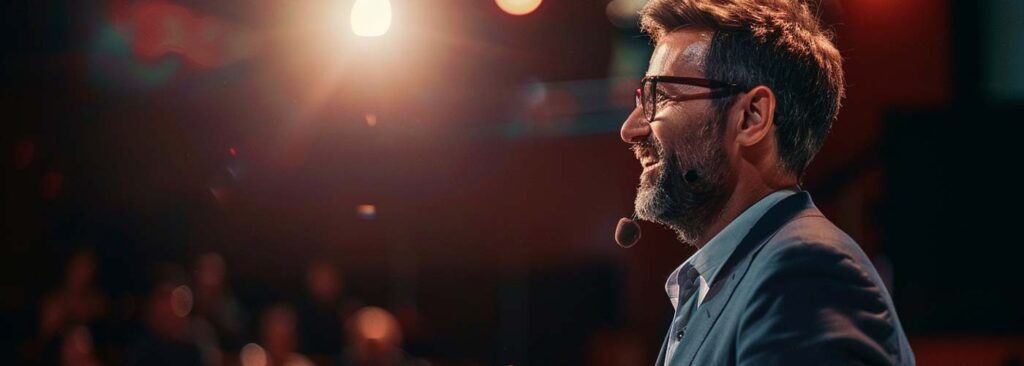
Here are 10 powerful examples of how to end a presentation that does not end with a thank you slide.
How many presentations have you seen that end with “Thank you for listening” or “Any questions?” I bet it’s a lot…
“Thank you for listening.” is the most common example. Unfortunately, when it comes to closing out your slides ending with “thank you” is the norm. We can create a better presentation ending by following these simple examples.
The two most essential slides of your deck are the ending and intro. An excellent presentation ending is critical to helping the audience to the next step or following a specific call to action.
There are many ways you can increase your presentation retention rate . The most critical steps are having a solid call to action at the end of your presentation and a powerful hook that draws your audience in.
What Action do You Want Your Audience to Take?
Before designing your presentation, start with this question – what message or action will you leave your audience with?
Are you looking to persuade, inspire, entertain or inform your audience? You can choose one or multiple words to describe the intent of your presentation.
Think about the action words that best describe your presentation ending – what do you want them to do? Inspire, book, learn, understand, engage, donate, buy, book or schedule. These are a few examples.
If the goal of your presentation is to inspire, why not end with a powerful and inspiring quote ? Let words of wisdom be the spark that ignites an action within your audience.
Here are three ways to end your presentation:
- Call to Action – getting the audience to take a specific action or next step, for example, booking a call, signing up for an event or donating to your cause.
- Persuade – persuading your audience to think differently, try something new, undertake a challenge or join your movement or community.
- Summarise – A summary of the key points and information you want the audience to remember. If you decide to summarise your talk at the end, keep it to no more than three main points.
10 Examples of How to End a Presentation
1. Asking your audience to take action or make a pledge.

Here were asking the audience to take action by using the wording “take action” in our copy. This call to action is a pledge to donate. A clear message like this can be helpful for charities and non-profits looking to raise funding for their campaign or cause.
2. Encourage your audience to take a specific action, e.g. joining your cause or community

Here was are asking the audience to join our community and help solve a problem by becoming part of the solution. It’s a simple call to action. You can pass the touch to your audience and ask them to take the next lead.
3. Highlight the critical points for your audience to remember.

Rember, to summarise your presentation into no more than three key points. This is important because the human brain struggles to remember more than three pieces of information simultaneously. We call this the “Rule of Three”.
4. If you are trying to get more leads or sales end with a call to action to book a demo or schedule a call.

Can you inspire your audience to sign up for a demo or trial of your product? Structure your talk to lead your prospect through a journey of the results you generate for other clients. At the end of your deck, finish with a specific call to action, such as “Want similar results to X?”
Make sure you design a button, or graphic your prospect can click on when you send them the PDF version of the slides.
5. Challenge your audience to think differently or take action, e.g. what impact could they make?

6. Give your audience actions to help share your message.

7. Promote your upcoming events or workshops

8. Asking your audience to become a volunteer.

9. Direct your audience to learn more about your website.

10. If you are a book author, encourage your audience to engage with your book.

6 Questions to Generate an Ending for Your Presentation
You’ve told an engaging story, but why end your presentation without leaving your audience a clear message or call to action?
Here are six great questions you can ask yourself to generate an ending for your presentation or keynote talk.
- What impression would you want to leave your audience with?
- What is the big idea you want to leave them with?
- What action should they take next?
- What key point should you remember 72 hours after your presentation?
- What do you want them to feel?
- What is the key takeaway for them to understand?
What to Say After Ending a Presentation?
When you get to the end of a book, you don’t see the author say, “thank you for reading my last chapter.” Of course, there is no harm in thanking the audience after your presentation ends, but don’t make that the last words you speak.
Think of the ending of the presentation as the final chapter of an epic novel. It’s your chance to leave a lasting impression on the audience. Close with an impactful ending and leave them feeling empowered, invigorated and engaged.
- Leave a lasting impression.
- Think of it as the last chapter of a book.
- Conclude with a thought or question.
- Leave the audience with a specific action or next step.
How to End a Presentation with Style?
There are many great ways you can end your presentation with style. Are you ready to drop the mic?
Ensure your closing slide is punchy, has a clear headline, or uses a thought-provoking image.
You want to capture the audience’s attention before closing the presentation. Make sure the fonts you choose and are clear and easy to read. And What are the Best Colours for Your PowerPoint presentation? Use them wisely.
Do you need to consider adding a link? If you add links to your social media accounts, use icons and buttons to make them easy to see. Add a link to each button or icon. By doing this, if you send the PDF slides to people, they can follow the links to your various accounts.
What Should you Remember?
💡 If you take one thing away from this post, it’s to lose the traditional ending slides. Let’s move on from the “Thank you for your attention.” or “Any questions.” slides.
These don’t help you or the audience. Respect them and think about what they should do next. You may be interested to learn 3 Tactics to Free Your Presentation Style to help you connect to your audience.
Create stunning presentations with our templates, toolkits and guides.
Illiya Vjestica
Share this post:, related posts.
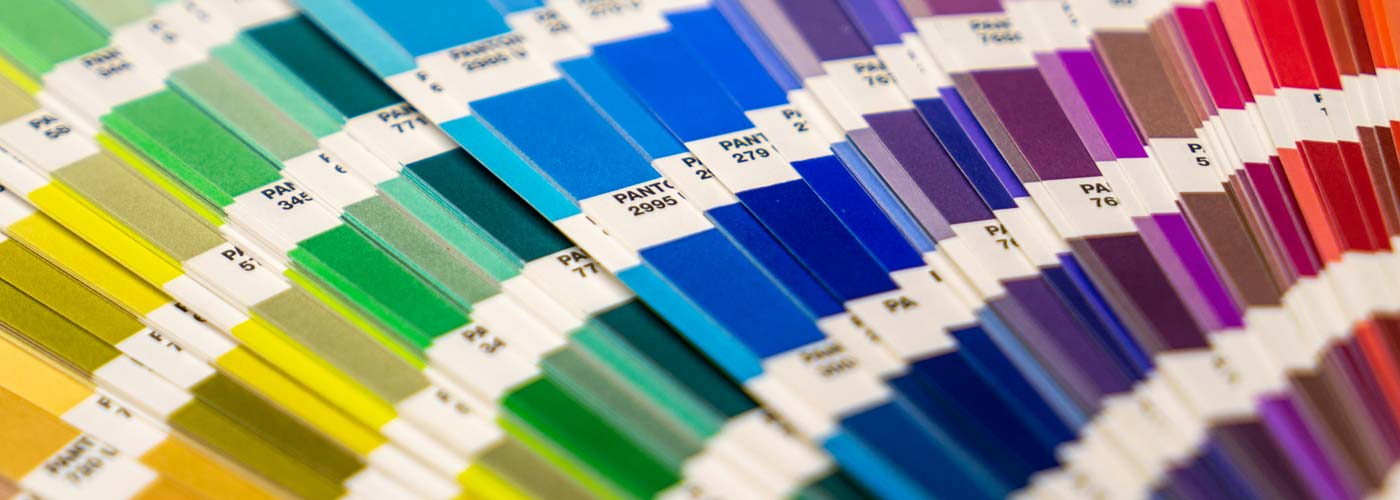
What are the Best Colours for Your PowerPoint presentation?
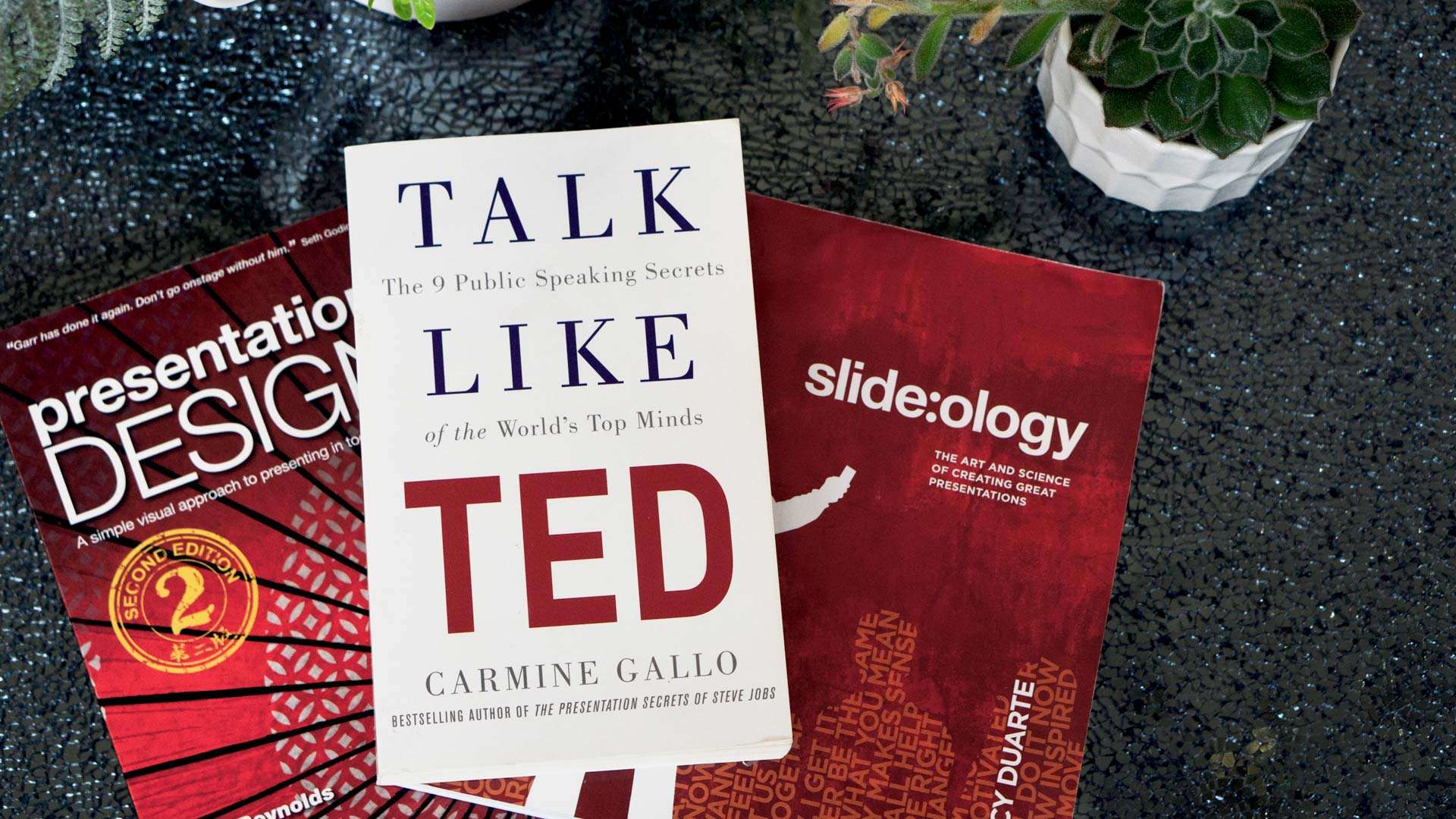
What are the Must-Read Essential Presentation Books?
Leave a comment cancel reply.
Your email address will not be published. Required fields are marked *
We use cookies to enhance your experience. By continuing to visit this site, you agree to our use of cookies
We use essential cookies to make Venngage work. By clicking “Accept All Cookies”, you agree to the storing of cookies on your device to enhance site navigation, analyze site usage, and assist in our marketing efforts.
Manage Cookies
Cookies and similar technologies collect certain information about how you’re using our website. Some of them are essential, and without them you wouldn’t be able to use Venngage. But others are optional, and you get to choose whether we use them or not.
Strictly Necessary Cookies
These cookies are always on, as they’re essential for making Venngage work, and making it safe. Without these cookies, services you’ve asked for can’t be provided.
Show cookie providers
- Google Login
Functionality Cookies
These cookies help us provide enhanced functionality and personalisation, and remember your settings. They may be set by us or by third party providers.
Performance Cookies
These cookies help us analyze how many people are using Venngage, where they come from and how they're using it. If you opt out of these cookies, we can’t get feedback to make Venngage better for you and all our users.
- Google Analytics
Targeting Cookies
These cookies are set by our advertising partners to track your activity and show you relevant Venngage ads on other sites as you browse the internet.
- Google Tag Manager
- Infographics
- Daily Infographics
- Popular Templates
- Accessibility
- Graphic Design
- Graphs and Charts
- Data Visualization
- Human Resources
- Beginner Guides
Blog Marketing How To End A Presentation & Leave A Lasting Impression
How To End A Presentation & Leave A Lasting Impression
Written by: Krystle Wong Aug 09, 2023

So you’ve got an exciting presentation ready to wow your audience and you’re left with the final brushstroke — how to end your presentation with a bang.
Just as a captivating opening draws your audience in, creating a well-crafted presentation closing has the power to leave a profound and lasting impression that resonates long after the lights dim and the audience disperses.
In this article, I’ll walk you through the art of crafting an impactful conclusion that resonates with 10 effective techniques and ideas along with real-life examples to inspire your next presentation. Alternatively, you could always jump right into creating your slides by customizing our professionally designed presentation templates . They’re fully customizable and require no design experience at all!
Click to jump ahead:
Why is it important to have an impactful ending for your presentation?
10 effective presentation closing techniques to leave a lasting impression, 7 things to put on a conclusion slide.
- 5 real-life exceptional examples of how to end a presentation
6 mistakes to avoid in concluding a presentation
Faqs on how to end a presentation, how to create a memorable presentation with venngage.

People tend to remember the beginning and end of a presentation more vividly than the middle, making the final moments your last chance to make a lasting impression.
An ending that leaves a lasting impact doesn’t merely mark the end of a presentation; it opens doors to further exploration. A strong conclusion is vital because it:
- Leaves a lasting impression on the audience.
- Reinforces key points and takeaways.
- Motivates action and implementation of ideas.
- Creates an emotional connection with the audience.
- Fosters engagement, curiosity and reflection.
Just like the final scene of a movie, your presentation’s ending has the potential to linger in your audience’s minds long after they’ve left the room. From summarizing key points to engaging the audience in unexpected ways, make a lasting impression with these 10 ways to end a presentation:
1. The summary
Wrap up your entire presentation with a concise and impactful summary, recapping the key points and main takeaways. By doing so, you reinforce the essential aspects and ensure the audience leaves with a crystal-clear understanding of your core message.

2. The reverse story
Here’s a cool one: start with the end result and then surprise the audience with the journey that led you to where you are. Share the challenges you conquered and the lessons you learned, making it a memorable and unique conclusion that drives home your key takeaways.
Alternatively, customize one of our cool presentation templates to capture the attention of your audience and deliver your message in an engaging and memorable way
3. The metaphorical prop
For an added visual touch, bring a symbolic prop that represents your message. Explain its significance in relation to your content, leaving the audience with a tangible and unforgettable visual representation that reinforces your key concepts.
4. The audience engagement challenge
Get the audience involved by throwing them a challenge related to your informational presentation. Encourage active participation and promise to share the results later, fostering their involvement and motivating them to take action.

5. The memorable statistic showcase
Spice things up with a series of surprising or intriguing statistics, presented with attention-grabbing visual aids. Summarize your main points using these impactful stats to ensure the audience remembers and grasps the significance of your data, especially when delivering a business presentation or pitch deck presentation .
Transform your data-heavy presentations into engaging presentations using data visualization tools. Venngage’s chart and graph tools help you present information in a digestible and visually appealing manner. Infographics and diagrams can simplify complex concepts while images add a relatable dimension to your presentation.

6. The interactive story creation
How about a collaborative story? Work with the audience to create an impromptu tale together. Let them contribute elements and build the story with you. Then, cleverly tie it back to your core message with a creative presentation conclusion.
7. The unexpected guest speaker
Introduce an unexpected guest who shares a unique perspective related to your presentation’s theme. If their story aligns with your message, it’ll surely amp up the audience’s interest and engagement.
8. The thought-provoking prompt
Leave your audience pondering with a thought-provoking question or prompt related to your topic. Encourage reflection and curiosity, sparking a desire to explore the subject further and dig deeper into your message.
9. The empowering call-to-action
Time to inspire action! Craft a powerful call to action that motivates the audience to make a difference. Provide practical steps and resources to support their involvement, empowering them to take part in something meaningful.

10. The heartfelt expression
End on a warm note by expressing genuine gratitude and appreciation for the audience’s time and attention. Acknowledge their presence and thank them sincerely, leaving a lasting impression of professionalism and warmth.
Not sure where to start? These 12 presentation software might come in handy for creating a good presentation that stands out.
Remember, your closing slides for the presentation is your final opportunity to make a strong impact on your audience. However, the question remains — what exactly should be on the last slide of your presentation? Here are 7 conclusion slide examples to conclude with a high note:
1. Key takeaways
Highlight the main points or key takeaways from your presentation. This reinforces the essential information you want the audience to remember, ensuring they leave with a clear understanding of your message with a well summarized and simple presentation .

2. Closing statement
Craft a strong closing statement that summarizes the overall message of your presentation and leaves a positive final impression. This concluding remark should be impactful and memorable.
3. Call-to-action
Don’t forget to include a compelling call to action in your final message that motivates the audience to take specific steps after the presentation. Whether it’s signing up for a newsletter, trying a product or conducting further research, a clear call to action can encourage engagement.

4. Contact information
Provide your contact details, such as email address or social media handles. That way, the audience can easily reach out for further inquiries or discussions. Building connections with your audience enhances engagement and opens doors for future opportunities.

Use impactful visuals or graphics to deliver your presentation effectively and make the conclusion slide visually appealing. Engaging visuals can captivate the audience and help solidify your key points.
Visuals are powerful tools for retention. Use Venngage’s library of icons, images and charts to complement your text. You can easily upload and incorporate your own images or choose from Venngage’s library of stock photos to add depth and relevance to your visuals.
6. Next steps
Outline the recommended next steps for the audience to take after the presentation, guiding them on what actions to pursue. This can be a practical roadmap for implementing your ideas and recommendations.

7. Inspirational quote
To leave a lasting impression, consider including a powerful and relevant quote that resonates with the main message of your presentation. Thoughtful quotes can inspire and reinforce the significance of your key points.

Whether you’re giving an in-person or virtual presentation , a strong wrap-up can boost persuasiveness and ensure that your message resonates and motivates action effectively. Check out our gallery of professional presentation templates to get started.
5 real-life exceptional examples of how to end a presentation
When we talk about crafting an exceptional closing for a presentation, I’m sure you’ll have a million questions — like how do you end a presentation, what do you say at the end of a presentation or even how to say thank you after a presentation.
To get a better idea of how to end a presentation with style — let’s delve into five remarkable real-life examples that offer valuable insights into crafting a conclusion that truly seals the deal:
1. Sheryl Sandberg
In her TED Talk titled “Why We Have Too Few Women Leaders,” Sheryl Sandberg concluded with an impactful call to action, urging men and women to lean in and support gender equality in the workplace. This motivational ending inspired the audience to take action toward a more inclusive world.
2. Elon Musk
Elon Musk often concludes with his vision for the future and how his companies are working towards groundbreaking advancements. His passion and enthusiasm for pushing the boundaries of technology leave the audience inspired and eager to witness the future unfold.
3. Barack Obama
President Obama’s farewell address concluded with an emotional and heartfelt expression of gratitude to the American people. He thanked the audience for their support and encouraged them to stay engaged and uphold the values that define the nation.
4. Brené Brown
In her TED Talk on vulnerability, Brené Brown ended with a powerful quote from Theodore Roosevelt: “It is not the critic who counts… The credit belongs to the man who is actually in the arena.” This quote reinforced her message about the importance of embracing vulnerability and taking risks in life.
5. Malala Yousafzai
In her Nobel Peace Prize acceptance speech, Malala Yousafzai ended with a moving call to action for education and girls’ rights. She inspired the audience to stand up against injustice and to work towards a world where every child has access to education.
For more innovative presentation ideas , turn ordinary slides into captivating experiences with these 15 interactive presentation ideas that will leave your audience begging for more.
So, we talked about how a good presentation usually ends. As you approach the conclusion of your presentation, let’s go through some of the common pitfalls you should avoid that will undermine the impact of your closing:
1. Abrupt endings
To deliver persuasive presentations, don’t leave your audience hanging with an abrupt conclusion. Instead, ensure a smooth transition by providing a clear closing statement or summarizing the key points to leave a lasting impression.
2. New information
You may be wondering — can I introduce new information or ideas in the closing? The answer is no. Resist the urge to introduce new data or facts in the conclusion and stick to reinforcing the main content presented earlier. By introducing new content at the end, you risk overshadowing your main message.
3. Ending with a Q&A session
While Q&A sessions are valuable , don’t conclude your presentation with them. Opt for a strong closing statement or call-to-action instead, leaving the audience with a clear takeaway.
4. Overloading your final slide
Avoid cluttering your final slide with too much information or excessive visuals. Keep it clean, concise and impactful to reinforce your key messages effectively.
5. Forgetting the call-to-action
Most presentations fail to include a compelling call-to-action which can diminish the overall impact of your presentation. To deliver a persuasive presentation, encourage your audience to take specific steps after the talk, driving engagement and follow-through.
6. Ignoring the audience
Make your conclusion audience-centric by connecting with their needs and interests. Avoid making it solely about yourself or your achievements. Instead, focus on how your message benefits the audience.

What should be the last slide of a presentation?
The last slide of a presentation should be a conclusion slide, summarizing key takeaways, delivering a strong closing statement and possibly including a call to action.
How do I begin a presentation?
Grabbing the audience’s attention at the very beginning with a compelling opening such as a relevant story, surprising statistic or thought-provoking question. You can even create a game presentation to boost interactivity with your audience. Check out this blog for more ideas on how to start a presentation .
How can I ensure a smooth transition from the body of the presentation to the closing?
To ensure a smooth transition, summarize key points from the body, use transition phrases like “In conclusion,” and revisit the main message introduced at the beginning. Bridge the content discussed to the themes of the closing and consider adjusting tone and pace to signal the transition.
How long should the conclusion of a presentation be?
The conclusion of a presentation should typically be around 5-10% of the total presentation time, keeping it concise and impactful.
Should you say thank you at the end of a presentation?
Yes, saying thank you at the end of a PowerPoint presentation is a courteous way to show appreciation for the audience’s time and attention.
Should I use presentation slides in the concluding part of my talk?
Yes, using presentation slides in the concluding part of your talk can be effective. Use concise slides to summarize key takeaways, reinforce your main points and deliver a strong closing statement. A final presentation slide can enhance the impact of your conclusion and help the audience remember your message.
Should I include a Q&A session at the end of the presentation?
Avoid Q&A sessions in certain situations to ensure a well-structured and impactful conclusion. It helps prevent potential time constraints and disruptions to your carefully crafted ending, ensuring your core message remains the focus without the risk of unanswered or off-topic questions diluting the presentation’s impact.
Is it appropriate to use humor in the closing of a presentation?
Using humor in the closing of a presentation can be appropriate if it aligns with your content and audience as it can leave a positive and memorable impression. However, it’s essential to use humor carefully and avoid inappropriate or offensive jokes.
How do I manage nervousness during the closing of a presentation?
To manage nervousness during the closing, focus on your key points and the main message you want to convey. Take deep breaths to calm your nerves, maintain eye contact and remind yourself that you’re sharing valuable insights to enhance your presentation skills.

Creating a memorable presentation is a blend of engaging content and visually captivating design. With Venngage, you can transform your ideas into a dynamic and unforgettable presentation in just 5 easy steps:
- Choose a template from Venngage’s library: Pick a visually appealing template that fits your presentation’s theme and audience, making it easy to get started with a professional look.
- Craft a compelling story or outline: Organize your content into a clear and coherent narrative or outline the key points to engage your audience and make the information easy to follow.
- Customize design and visuals: Tailor the template with your brand colors, fonts and captivating visuals like images and icons, enhancing your presentation’s visual appeal and uniqueness. You can also use an eye-catching presentation background to elevate your visual content.
- Incorporate impactful quotes or inspiring elements: Include powerful quotes or elements that resonate with your message, evoking emotions and leaving a lasting impression on your audience members
- Utilize data visualization for clarity: Present data and statistics effectively with Venngage’s charts, graphs and infographics, simplifying complex information for better comprehension.
Additionally, Venngage’s real-time collaboration tools allow you to seamlessly collaborate with team members to elevate your presentation creation process to a whole new level. Use comments and annotations to provide feedback on each other’s work and refine ideas as a group, ensuring a comprehensive and well-rounded presentation.
Well, there you have it—the secrets of how to conclude a presentation. From summarizing your key message to delivering a compelling call to action, you’re now armed with a toolkit of techniques that’ll leave your audience in awe.
Now go ahead, wrap it up like a pro and leave that lasting impression that sets you apart as a presenter who knows how to captivate, inspire and truly make a mark.
Discover popular designs

Infographic maker

Brochure maker

White paper online

Newsletter creator

Flyer maker

Timeline maker

Letterhead maker

Mind map maker

Ebook maker
- Presentations
- Most Recent
- Infographics
- Data Visualizations
- Forms and Surveys
- Video & Animation
- Case Studies
- Design for Business
- Digital Marketing
- Design Inspiration
- Visual Thinking
- Product Updates
- Visme Webinars
- Artificial Intelligence
6 Ways to Close Your Presentation With Style (& Tools to Use)

Written by: Ashish Arora

Picture this: You've just delivered an amazing presentation that had your audience hooked from the start. The excitement in the room is glaring as you reach the final moments of your presentations.
Now, it's time to close with a bang and leave a lasting impression.
The way you conclude your presentation holds immense power. That’s the defining moment that cements your message in the minds of your audience.
So how do you wrap up your presentation in a memorable way and leave your audience feeling inspired? That’s why we created this article to teach you how to end a presentation.
In this article, we're going to explore six awesome ways to close your presentation with style. These techniques will help you leave a lasting impact and make your audience go "Wow!"
Get ready to level up your presentation skills and charm your audience with these proven closing techniques.
We've covered the best closing tactics for your next presentation in this video.
Table of Contents
6 ways to close your presentation with style, tools to help you create a presentation, key phrases to end a presentation.
- How to Start a Presentation
- Top Presentation Mistakes to Avoid
- How you end your presentation can make all the difference in solidifying your message and leaving your audience with a sense of purpose.
- Level up your presentation skills and charm your audience with these proven closing techniques: include a strong call-to-action (CTA), don't end with a question and answer slide, conclude with a memorable quote, tell a story, summarize your main points and thank the audience.
- Here are some ways you can start your presentation on a strong note: make a bold claim, give them the unexpected, pique curiosity, ask questions and tell a story.
- Avoid these top presentation mistakes: lack of adequate presentation, being robotic, avoiding eye contact, starting and ending weak.
- Visme, Prezi, Slidebean and Google Slides are four stand-out tools you can use to create stunning and effective presentations.
- Visme’s presentation software offers a wide range of templates and extensive features to help you create next-level presentations.
There’s no question that grabbing your audience’s attention at the very beginning of your presentation is important. But how you end it can make all the difference in your presentation’s overall impact.
Here are some ways to ensure you end powerfully:
- Way #1: Include a Strong Call-to-Action (CTA)
- Way #2: Don't End With a Q&A
- Way #3: End With a Memorable Quote
- Way #4: Close With a Story
- Way #5: Drive Your Main Points Home
- Way #6: Thank and Acknowledge

Create an infographic of your own! Sign up. It's free.
1. Include a Strong Call-to-Action (CTA)
If you’re a business owner, the primary purpose of your presentation is to inspire the audience to action. Don’t assume they will take it, move them to it.
Use powerful words that are definitive and instructional. Calls-to-action like “Begin the journey” or “Join the fight” are to-the-point and let the audience know what to do.
Create a stunning presentation in less time
- Hundreds of premade slides available
- Add animation and interactivity to your slides
- Choose from various presentation options
Sign up. It’s free.

2. Don’t End with a Q&A
You’ve just spent 20-30 minutes wowing your audience and now you’re going to let your presentation fizzle out with a Q&A? Beyond the fact that you are never in full control of what questions you will be asked, Q&As are just not memorable.
So how do you end a presentation with a bang? It is better to take questions throughout the presentation. This way the questions asked are relevant to the particular information being shared and you can ensure your audience is keeping up with you.
If you have been forced to structure your presentation so that questions are taken at the end, make sure to allow yourself a minute or two after the Q&A. Use this time to close the presentation with your final takeaways and messages of inspiration.
3. End with a Memorable Quote
Sometimes, if you can’t find the perfect words to end with, use someone else’s words.
“Life is 10% what happens to me and 90% of how I react to it.” –Charles Swindoll
“Life is what happens to you while you’re busy making other plans.” –John Lennon
“Your time is limited, so don’t waste it living someone else’s life.” –Steve Jobs
These are pretty powerful words, no? Use quotes like these when you wrap up your presentation, or add them in your final slide to leave a strong impression.
4. Close with a Story
If opening with a compelling story works, there’s a very good chance that closing with one will as well. While a story at the beginning was an effective lead-in to your message, a story at the end can creatively sum up the information you have shared.
A word of caution: don’t end with a case study . Many business owners do this. Case studies are great for the middle of your presentation. But for the conclusion, you want a meaningful story that affects your audience emotionally and causes them to remember your message for a long, long time.
5. Drive Your Main Points Home
Your audience will appreciate some form of summation at the end that will act as a linear representation of what they’ve just heard. There is a simple summary formula that many professional speakers use in the ending slide:
- Tell them what you are going to tell them.
- Then, tell them what you told them.
You can simply say something like, “Before I leave you with my final thoughts about XYZ, let me briefly restate my main takeaways…” Don’t just list your key points but show the audience how each links to the other points.
Giving a successful presentation takes a lot of work and commitment. By creating a powerful opening and closing, you will ensure that your message is not only fully received but impactful as well.
6. Thank and Acknowledge
If you're finding it hard to signal to your audience that your presentation has ended and it's time to applaud, thanking them can be a great way to do so. Including an end slide or thank you slide can make things easier.
At the end of your presentation, you can also acknowledge any companies or people who helped you put together your presentation, such as a website you used as a data source.
Now that you know how to end a presentation effectively, let's find out how you can create one that speaks for itself.
A well-designed slide deck can not only help you better convey your message, but it can also make you feel more confident about your presentation.
Here are four tools you can use to create stunning and effective presentations.

Visme is a robust visual content creation tool and presentation software that transforms how users create and deliver captivating presentations. With a wide range of customizable templates, an extensive asset library and an intuitive drag-and-drop editor, you can level up your presentation and captivate your audience like never before.
Here are some of the standard features of Visme's presentation software.
- Generate a set of branded templates tailored to your brand using Visme's AI-powered brand design tool .
- Easily record projects and presentations for your audience to view on their own time and pace with Visme Presenter studio .
- Create beautiful data visualizations , charts , graphs , and infographics that will effectively communicate your information.
- Transform boring presentation slides into enriching experiences that keep your audience engaged with interactive features using pop ups, hover effects, slide transitions, interactive charts, maps, quizzes and videos.
- Generate high-quality content, proofread or create an outline for your presentation using Visme's AI text generator .
- Take your presentation to a whole new level with our comprehensive library of royalty-free images, icons, illustrations, graphics, and pre-designed content blocks.
- Unleash your creativity with the help of Visme’s AI image generator . All you need to do is input your prompt and you can generate unique photos, paintings, pencil drawings, 3D graphics, icons, abstract art, and more.
- Drive seamless collaboration with Visme's collaborative features make teamwork a breeze. You can collaborate with colleagues and clients in real-time, leave comments, and make edits together, ensuring a smooth and efficient workflow. Say goodbye to email attachments and enjoy seamless collaboration all in one place.
- When you’re sold on your final presentation design , you can download it in multiple formats, including PPTX, PDF, PDF or as a shareable link . You can present directly from Visme, embed your presentation on websites, or download it for offline use.
If you're racing against the clock, use Visme's AI presentation maker to create stunning presentations in seconds. Just explain what you want to create, provide more context, select your preferred designs and watch the tool unleash its magic.

Get started with our Starter plan and enjoy full access to templates and assets. Or upgrade to a Pro plan to access team collaboration and brand management features. Our Visme for Teams plans offer enterprise-level features like custom sub-domains, team collaboration, custom integrations and more.

The master of non-linear presentations, Prezi, lets you create slide decks that are bound to stand out from others.
While the learning curve of Prezi can be steep for some people, it's worth it if you're looking to get creative with your presentations.
3. Slidebean

If the most important thing to you when making a presentation is saving time, Slidebean might be a great fit.
The best thing about this tool is it uses artificial intelligence (AI) to help you create stunning layouts for your content.
Slidebean is ideal if you're not looking for extensive customizability, just ease of use and time-saving features like templates and content blocks.
4. Google Slides

Sometimes, the most basic tools are enough for creating a great presentation, especially if the industry you're operating in requires simplicity and seriousness.
The best part about Google Slides is that you can use it from anywhere and from any device. For example, you can create your entire presentation on your phone using the mobile application.
Presentations made in Google Slides can also be opened with Microsoft PowerPoint and Keynote, which makes it quite a versatile tool.
if you're wondering how to close your presentation, here are some key phrases you can use:
Appreciate your listeners
- Thank you for your time and attention.
- I appreciate your presence here today.
- Thank you for being such an engaged audience.
Express gratitude for the opportunity
- I'm grateful for the chance to share...
- I want to express my gratitude to...
- Thank you once again for the opportunity.
Summarize the main points
- In summary...
- To sum up...
- In conclusion...
Use a call to action
- I encourage each of you to...
- Let's work together to...
- Take the next step by...
Inspire or motivate your audience
- Remember that...
- As we move forward, let's keep in mind...
- Let this be a reminder that..."
Leave your closing thoughts
- In closing...
- As a final thought...
- To wrap things up...
Encourage your audience to ask questions or share their thoughts
- I'm now open to any questions you may have.
- I'd love to hear your thoughts on...
- Feel free to reach out if you have any further questions.
Reiterate the main points
- Just to recap...
- To reiterate the key points...
- In essence, we covered...
Use closing quotes
- To quote [relevant figure]...
- In the words of [author]...
- As [famous person] once said...
Express optimism about the future
- Looking ahead...
- The future holds great opportunities for...
- I'm excited about the possibilities that lie ahead.
Remember, these fun ways to end a presentation aren't one-size-fits-all. You need to tailor these phrases to fit the specific context and tone of your presentation.
Bonus 1: How to Start a Presentation
Now you know how to conclude a presentation. We’ve also discussed what to say at the end of a presentation.
Let’s discuss how to begin a presentation.
According to bestselling author, Malcolm Gladwell, in Blink: The Power of Thinking Without Thinking , "Snap judgments are ... enormously quick: they rely on the thinnest slices of experience."
In other words: first impressions are real, and they happen really quickly. Think about those presentations you have sat in the audience for.
How quickly did you sum a presenter up when they took the stage? Did you judge them on their posture? What they were wearing? How they addressed the audience? What their voice sounded like?
Most likely, you took all of these factors into account and quickly decided whether you were going to give them your full attention or think about what you should make for dinner.
As a presenter, you must understand that your audience members will make a snap decision about you within the first few moments after taking that stage. Your job at the very beginning of your presentation is to grab their attention.
Here are some ways you can start your presentation strong.

1. Make a Bold Claim
Imagine being in the audience when a presenter opens his mouth and the first words out are, “When I’ve finished here today, you will have the knowledge to increase your revenue by 200% this year.” Um… would you sit forward in your chair and listen to every single word? You bet you would!
You have been asked to speak because you are an expert in your field and have valuable information to share. So why be shy about it? Start your presentation with a bold claim, and then overdeliver.
2. Give Them the Unexpected
Another powerful way to grab attention right up top is to contradict audience expectations. Some people refer to this as "applied unpredictability principle."
Giving people what they expect is not very exciting. Imagine a roller coaster that had no sudden drops or turns. It wouldn’t thrill you. Well the same can be said for presentations. The unexpected hooks the audience instantly.
Here’s an example. Pamela Meyer, author of Liespotting , starts off her presentation by scanning the audience and then saying, “Okay, I don’t want to alarm anybody in this room, but it’s just come to my attention that the person to your right is a liar! Also the person to your left is a liar.”
Well, the audience laughs, getting her intended joke, but you can tell that this unexpected statement has hooked them, and they are ready to give their full attention.
3. Pique Curiosity
Humans like to have their curiosity piqued. We love the feeling of being presented with information that makes us curious and wonder about something. Research actually shows that curiosity prepares our brain to learn something new. How does it do this?
Well, when we are curious about something, we give that something our full attention. We look for clues and assess situations. This is how we operate and it’s how our ancestors stayed alive.
If you want to grab the audience’s attention right off the bat, ask a question or pose an idea that piques their curiosity. You’ll see many Ted Talk presenters do this by “confessing” they have to share a secret or an apology.
Speaker Dan Pink does this in his famous T e d Talk when he says:
“I need to make a confession, at the outset here. A little over 20 years ago, I did something that I regret. Something that I am not particularly proud of. Something that in many ways I wished no one would ever know, but that here I feel kind of obliged to reveal. In the late 1980s, in a moment of youthful indiscretion, I went to law school.”
The minute someone says they have something to confess, we HAVE to know what it is, and so we are forced to pay attention.
RELATED: 29 Killer Presentation Tips to Wow Your Audience
4. Ask Questions
This technique is an oldie but a goodie. By posing a thoughtful question to your audience, their brain is forced to THINK about the answer. You have engaged them from second one. The key is to make the question one that cannot be answered with a simple yes or no, but rather one that plants the seed of an idea.
“What scares you the most?”
“How do human beings constantly reach goals we all believe can never be reached?”
“When was the last time you allowed yourself to feel powerful?”
5. Tell a Story
“When I was nine, I met a homeless man who said he could see my entire future. He told me that when I turned 12, I would die. And I did.”
Okay, I am FULLY listening.
Stories are powerful. The human brain seems to have been wired to listen to stories. No matter how old we get, when someone starts to tell us a story, we instantly become 5-years-old, wide-eyed, ready to go on an adventure.
The story you tell can be personal or professional, just make sure it ties into your overall message.
Bonus 2: Top Presentation Mistakes to Avoid
If we’re going to discuss a presentation success formula, we’ve got to first tackle some of the biggest public speaking mistakes that guarantee your presentation is unsuccessful. Are you guilty of any of these?

1. Not Being Prepared
We’ve all seen those presenters who make it look so effortless. Steve Jobs was like that. He seemed to glide onto the stage, open his mouth and instantly captivate everyone.
But the truth is, even Steve Jobs had to prepare.
Thoughtful preparation is essential for any level of public speaking. Doing the work ahead of time will not only help you feel and sound more confident, it will ensure you deliver the right message to the right audience.
2. Being Robotic
Beyond being comfortable with your material, you must be comfortable in your own body. Have you seen presenters who just stand in one spot and barely move at all? While they’re not very good at exciting their audience, they do have a keen knack for lulling listeners to sleep.
Granted, there may be those rare situations where, because of a lack of robust technology, you have no choice but to stand behind a podium. But even then, be sure to use gestures to punctuate your message. Gestures communicate on a level that words don’t. Don’t be flamboyant but try and use natural gestures as much as you can – you’ll seem human instead of machine-like.
And, when technology does allow you free movement, by all means, move around that stage. Steve Jobs was great at using movement purposefully during his presentations.
If you have a presentation coming up and want to avoid sounding robotic, this video explains 8 ways to memorize your presentation.

3. Avoiding Eye Contact
We can’t talk about body language and not mention one of the biggest mistakes that many speakers make, and that is avoiding eye contact. How many presentations have you seen where the speaker spent the entire time staring at her notes or PowerPoint presentation? How did you feel? Perhaps invisible?
Meeting a person’s gaze establishes a real connection and keeps listeners engaged. If your audience is small enough, try to make eye contact with everyone at least once. If the audience is too large, do your best to scan each section of the audience, landing on a few people. This will give everyone a general impression that you are doing your best to connect.
4. Starting and Ending Weak
If there is one no-no a presenter can make, this is it.
You should think of your presentation as a delicious meal you have painstakingly prepared for your guests. What do you remember most about a great meal? If you’re like most people, you remember the appetizers and the dessert – everything in between is kind of a good-tasting blur.
When you begin and end your presentation strong, you gain the audience’s attention quickly and leave a positive and lasting impression. These are two skills that cannot be emphasized enough.
Let’s look at some of the ways you can ensure you start your presentation strong:
Ready to Level-Up Your Presentation?
Whether it's a business presentation or a motivational speech, knowing how to give a closing statement and ending your talk on a high note is important.
The last thing you say in front of a crowd can help you leave a memorable impression, whether it's a recap of your presentation content or a rhetorical question.
If you're ready to take your presentations to the next level, use Visme's presentation software to put together engaging and interactive slides.
Create stunning presentations faster with Visme

Trusted by leading brands
Recommended content for you:

Create Stunning Content!
Design visual brand experiences for your business whether you are a seasoned designer or a total novice.
About the Author
Ashish Arora is the Co-Founder of SketchBubble.com , a leading provider of result-driven, professionally built presentation templates. Travelling the world to gather new creative ideas, he has been working in the digital marketing space since 2007 and has a passion for designing presentations. You can also find him on Twitter or LinkedIn .

SpeakUp resources
How to end a presentation in english: methods and examples.
- By Matthew Jones
Naturally, the way you end a presentation will depend on the setting and subject matter. Are you pitching an idea to your boss? Are you participating in a group presentation at school? Or are you presenting a business idea to potential investors? No matter the context, you’ll want to have a stellar ending that satisfies your audience and reinforces your goals.
So, do you want to learn how to end a presentation with style? Wondering how to end an informative speech? Or do you want to know how to conclude a Powerpoint presentation with impact? We’re here to help you learn how to end a presentation and make a great impression!
How to End a Presentation: 3 Effective Methods
Every presentation needs a great beginning, middle, and end. In this guide, we will focus on crafting the perfect conclusion. However, if you’d like to make sure that your presentation sounds good from start to finish, you should also check out our guide on starting a presentation in English .
Though there are many ways to end a presentation, the most effective strategies focus on making a lasting impression on your audience and reinforcing your goals. So, let’s take a look at three effective ways to end a presentation:
1. Summarize the Key Takeaways
Most presenters either make an argument (i.e. they want to convince their audience to adopt their view) or present new or interesting information (i.e. they want to educate their audience). In either case, the presentation will likely consist of important facts and figures. The conclusion gives you the opportunity to reiterate the most important information to your audience.
This doesn’t mean that you should simply restate everything from your presentation a second time. Instead, you should identify the most important parts of your presentation and briefly summarize them.
This is similar to what you might find in the last paragraph of an academic essay. For example, if you’re presenting a business proposal to potential investors, you might conclude with a summary of your business and the reasons why your audience should invest in your idea.
2. End with a CTA (Call-To-Action)
Ending with a Call-To-Action is one of the best ways to increase audience engagement (participation) with your presentation. A CTA is simply a request or invitation to perform a specific action. This technique is frequently used in sales or marketing presentations, though it can be used in many different situations.
For example, let’s say that you’re giving an informational presentation about the importance of hygiene in the workplace. Since your goal is to educate your audience, you may think that there’s no place for a CTA.
On the contrary, informational presentations are perfect for CTA’s. Rather than simply ending your presentation, you can direct your audience to seek out more information on the subject from authorities. In this case, you might encourage listeners to learn more from an authoritative medical organization, like the World Health Organization (WHO).
3. Use a Relevant Quote
It may sound cliche, but using quotes in your closing speech is both memorable and effective. However, not just any quote will do. You should always make sure that your quote is relevant to the topic. If you’re making an argument, you might want to include a quote that either directly or indirectly reinforces your main point.
Let’s say that you’re conducting a presentation about your company’s mission statement. You might present the information with a Powerpoint presentation, in which case your last slide could include an inspirational quote. The quote can either refer to the mission statement or somehow reinforce the ideas covered in the presentation.
Formatting Your Conclusion
While these 3 strategies should give you some inspiration, they won’t help you format your conclusion. You might know that you want to end your presentation with a Call-To-Action, but how should you “start” your conclusion? How long should you make your conclusion? Finally, what are some good phrases to use for ending a presentation?<br>
Examples of a Good Conclusion
In conclusion, I believe that we can increase our annual revenue this year. We can do this with a combination of increased efficiency in our production process and a more dynamic approach to lead generation. If we implement these changes, I estimate that annual revenue will increase by as much as 15%.
The example above shows a good conclusion for a business presentation. However, some people believe that the term in conclusion is overused. Here’s how to end a presentation using transition words similar to in conclusion .
Transition words help your audience know that your presentation is ending. Try starting your conclusion with one of these phrases:
- To summarize
However, transition words aren’t always necessary. Here are a few good ways to end a presentation using a different approach.
- Summarize Key Takeaways : There are two things that I’d like you to remember from today’s presentation. First, we are a company that consults startups for a fraction of the cost of other consultation services. And second, we have a perfect record of successfully growing startups in a wide variety of industries. If anything was unclear, I’d be happy to open the floor to questions.
- Make a Call-To-Action : I am very passionate about climate change. The future of the planet rests on our shoulders and we are quickly running out of time to take action. That said, I do believe that we can effect real change for future generations. I challenge you to take up the fight for our children and our children’s children.
- Use a Relevant Quote: I’d like to end my presentation with one of my favorite quotes: “Ask not what your country can do for you — ask what you can do for your country.”
As you can see, your conclusion does not need to be very long. In fact, a conclusion should be short and to the point. This way, you can effectively end your presentation without rambling or adding extraneous (irrelevant) information.
How to End a Presentation in English with Common Phrases
Finally, there are a few generic phrases that people frequently use to wrap up presentations. While we encourage you to think about how to end a presentation using a unique final statement, there’s nothing wrong with using these common closing phrases:
- Thank you for your time.
- I appreciate the opportunity to speak with you today.
- I’ll now answer any questions you have about (topic).
- If you need any further information, feel free to contact me at (contact information).
We hope this guide helps you better understand how to end a presentation ! If you’d like to find out more about how to end a presentation in English effectively, visit Magoosh Speaking today!
Matthew Jones

Free practice (Facebook group)
Phone: +1 (510) 560-7571
Terms of Use
Privacy Policy
Company Home
- Alternatives
How to End A Presentation in 2024 | Tips and Examples
Astrid Tran • 08 April, 2024 • 8 min read
How to end a presentation successfully ? First impression matters all the time, and the ending is no exception. Many presentations make mistakes in putting a lot of effort into designing a great opening but forget the closing.
With that in mind, the article aims to equip you with useful ways to have a complete presentation, especially on having an impressive and engaging ending. So let's dive in!
Learn to create better presentation
- Bad presentation at work
- How to Overcome Stage Fright
- Measure your presentation better with rating scale or Likert scale
Table of Contents
- The Importance of Presentation Ending
Recapping Key Points
Incorporating a call to action, ending with a powerful quote, asking a thought-provoking question, avoiding new information, when to end the presentation perfectly, final thoughts, frequently asked questions.

Get your Students Engaged
Start meaningful discussion, get useful feedback and educate your audience. Sign up to take free AhaSlides template
The Importance of Presentation Ending?
Why care about your presentation's conclusion? It's not just a formality; it's critical. The conclusion is where you make a lasting impression, reinforce key points for better retention, motivate action, and ensure your audience remembers your message.
Plus, a strong conclusion reflects your professionalism and shows you've thoughtfully considered how to leave a lasting impact. In essence, it's your final opportunity to effectively engage, inform, and persuade, ensuring your presentation achieves its objectives and is remembered for the right reasons.
How to End A Presentation Successfully: A Complete Guide with Examples
Effectively ending a presentation is essential to leave a lasting impression on your audience and drive your message home. Here's a step-by-step guide on how to effectively end a presentation
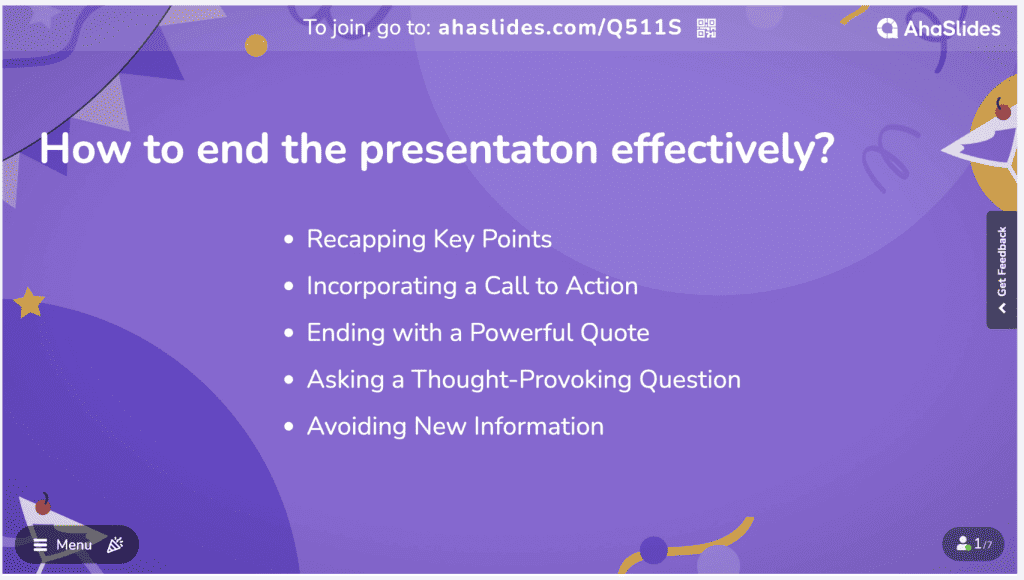
One of the primary functions of a conclusion is to summarize the main points you've covered in your presentation. This recap serves as a memory aid, reinforcing the key takeaways for your audience. It's essential to do this succinctly and clearly, ensuring that the audience can easily recall the core ideas. For example:
- "We've delved into the factors that drive motivation - setting meaningful goals, overcoming obstacles, and fostering a positive mindset. These are the building blocks of a motivated life."
- "Before we conclude, let's come back to our core theme today - the incredible power of motivation. Our journey through the elements of inspiration and self-drive has been both enlightening and empowering."
* This step also is a great place for leaving a vision . A phrase that is commonly used is: "Visualize a world where people are empowered, pursuing their passions, and breaking barriers. It's a world where motivation fuels progress and dreams become reality. This vision is within reach for all of us."
How to write the end of the presentation? A powerful conclusion that motivates your audience to take action can be an excellent idea. Depending on the nature of your presentation, this could involve encouraging them to make a purchase, support a cause, or implement the ideas you've presented. Be specific in your call to action, and make it compelling and achievable. An example of a CTA ending can be:
- "Now, it's time for action. I encourage each of you to identify your goals, create a plan, and take the first step toward realizing your dreams. Remember, motivation without action is just a daydream."
How to end a presentation impressively? "As the great Maya Angelou once said, 'You may not control all the events that happen to you, but you can decide not to be reduced by them.' Let's remember that we have the power to rise above challenges." Conclude with a relevant and impactful quote that relates to your topic. A well-chosen quote can leave a lasting impression and inspire reflection. For example, Julius Caesar utilized this technique when he said, "I came, I saw, I conquered." Some best phrases to use on your ending are:
- Feel free to reach out if you have any questions.”
- “For more information, head to the link on the screen.”
- “Thank you for your time/attention.”
- “I hope you found this presentation informative/useful/insightful.”
How to end a presentation without using the Thankyou slide? Pose a question that encourages your audience to think or reflect on the material you've presented. This can engage the audience and stimulate discussion.
For instance: You can start a statement like: "I'm here to address any questions or listen to your thoughts. Do you have any questions, stories, or ideas you'd like to share? Your voice is important, and your experiences can inspire us all."
💡Using live Q&A features from interactive presentation tools like AhaSlides to increase your audience engagement. This tool is integrated into PowerPoint and Google Slides so you can show it to your audience instantly and update the response in real-time.
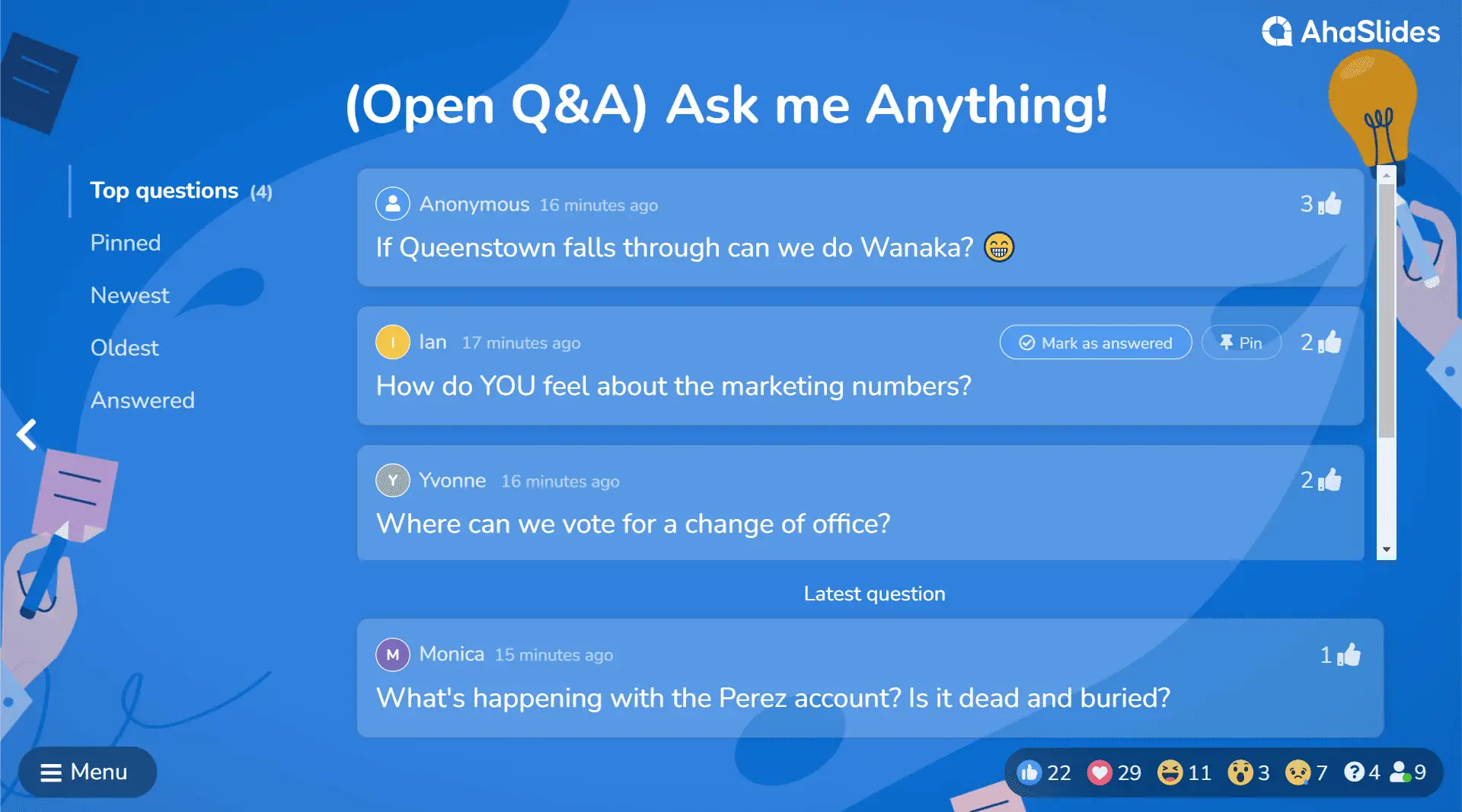
The conclusion is not the place to introduce new information or ideas. Doing so can confuse your audience and dilute the impact of your core message. Stick to what you've already covered and use the conclusion to reinforce and emphasize the existing content.
💡Check out Thank You Slide For PPT | Create a Beautifully One in 2024 to learn about creating innovative and appealing Thank-You Slides to end any type of presentation, whether it is for academic or business purposes.
In summary, an effective conclusion serves as a concise recap of your presentation, encourages your audience to take action, and refrains from introducing new information. By accomplishing these three objectives, you'll create a conclusion that reinforces your message and inspires your audience to respond positively.
The timing for concluding a presentation depends on various factors, including the nature of your content, your audience, and any time constraints. Here are some general guidelines to help you determine when to conclude your presentation:
- Avoid Rushing : Avoid rushing through your conclusion due to time constraints. Ensure that you have allocated sufficient time for the conclusion so that it doesn't feel abrupt or hurried.
- Check Time Limits : If you have a specific time limit for your presentation, keep a close eye on the time as you approach the conclusion. Be prepared to adjust the pace of your presentation to ensure you have ample time for the conclusion.
- Consider Audience Expectations : Consider the expectations of your audience. If they anticipate a specific duration for your presentation, try to align your conclusion with their expectations.
- Wrap Up Naturally : Aim to conclude your presentation in a way that feels natural and not abrupt. Provide a clear signal that you're moving into the conclusion to prepare your audience for the end.
How to end a presentation? The key is to balance the need to convey your message effectively with the available time. Effective time management and a well-planned conclusion will help you wrap up your presentation smoothly and leave a positive impression on your audience.
🎊 Learn: Best Q&A Apps to Engage With Your Audience | 5+ Platforms For Free in 2024
How to end a presentation impressively in your opinion? As mentioned, there are many ways to engage your audience until the last minute, from a strong CTA, a captivating ending slide, thoughtful Q&A session. Don't force yourself to make an ending that you might not be comfortable with, act as naturally as possible.
💡Want more inspiration? Check out AhaSlides right away to explore more innovative methods to enhance audience engagement and collaboration!
What do you say at the end of a presentation?
At the end of a presentation, you typically say a few key things:
- Summarize your main points or key takeaways to reinforce the message.
- Provide a clear call to action, motivating your audience to take specific steps.
- Express gratitude and thank your audience for their time and attention.
- Optionally, open the floor for questions or comments, inviting audience engagement.
How do you end a fun presentation?
To conclude a fun presentation, you can share a light-hearted, relevant joke or humorous anecdote, encourage the audience to share their own fun or memorable experiences related to the topic, end with a playful or uplifting quote, and express your excitement and appreciation for the enjoyable presentation experience.
Should you say thank you at the end of a presentation?
Yes, saying thank you at the end of a presentation is a courteous and appreciative gesture. It acknowledges your audience's time and attention and adds a personal touch to your conclusion. It can be especially important in thank-you presentations and is generally a polite way to wrap up any type of presentation.
Ref: Pumple

Astrid Tran
I've got my rhythm with words
Tips to Engage with Polls & Trivia
More from AhaSlides
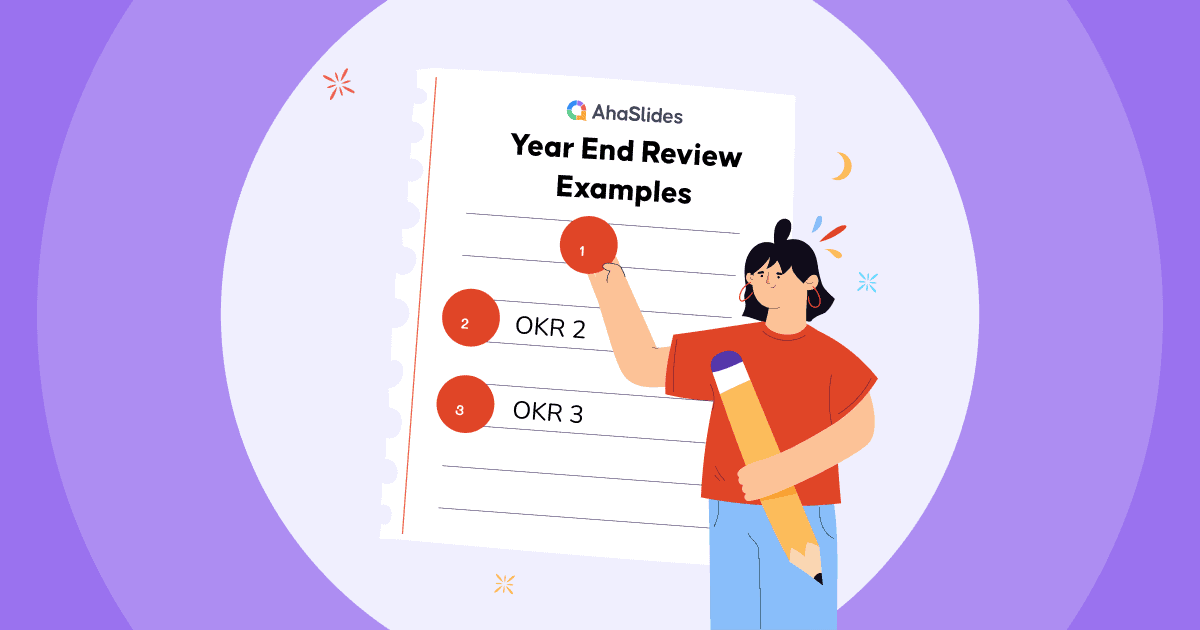

- Video Marketing
- Case Studies
- Create a video

How to End a Presentation? [Top 8 Strategies with Examples]
Guru - May 9, 2023 - Leave your thoughts. 9 min read
animaker deck , presentation , presentation ideas , Presentation Software , presentation tips
How you end a presentation is just as crucial as its opening. It can make or break the impression that you leave on your audience.
A strong conclusion can reinforce your key message and ensure that your audience remembers it even after the presentation is over.
A well-concluded presentation can leave your audience impressed, energized, and motivated to take action.
So now, are you wondering what’s the best way to conclude your presentation? Don’t worry! You have come to the right place!
To help you make a powerful ending to your presentation, we have compiled a list of 8 different strategies in this blog post.
Each of these strategies is designed to help you create a memorable and impactful conclusion to your presentation.
By choosing the most appropriate one for your presentation, you can ensure that your audience remembers your key message and feels motivated to take action.
Let’s jump right in,
1. Emphasize the core message 2. Mirror your opening statement 3. Pose an open-ended question 4. End with a Call to action 5. Thank the audience 6. End with a powerful quote 7. Acknowledge your contributors 8. Ask for feedback
1. Emphasize the core message:
One of the most important aspects of any presentation is ensuring your audience understands your core message.
Reiterating your main points and summarizing your message at the end of your presentation can reinforce this and leave a lasting impression.
It helps to ensure that your audience understands the purpose of your presentation and has a clear takeaway from the information you have provided.
In this video, the speaker restates her topic to conclude her speech firmly and gives a pause, resulting in tremendous applause from the audience.
Similarly, by restating your core message, you can also create a sense of cohesion and give your presentation a firm closure.
This can be particularly important if you want to motivate your audience to take action or influence their behavior in some way.
However, it's important not to repeat EVERYTHING you have said. Instead, focus on the most crucial elements and highlight them in a concise and clear manner.
2. Mirror your opening statement:
A great way to end your presentation is by mirroring your opening statement in your conclusion.
Highlighting your presentation's key message at the end and emphasizing the central idea you aimed to communicate will help your audience to retain it in their memory.
During the conclusion of the presentation, the speaker effectively utilized the technique of mirroring the opening example she had presented - ordering a pizza on the phone by herself.
The speaker demonstrated the remarkable transformation she had undergone in terms of personal growth and confidence, which strongly reinforced her message to the audience.
By mirroring her opening example, she created a sense of familiarity and connection with her audience while simultaneously driving home the key message of her presentation.
This technique allowed the audience to understand better and relate to the speaker's personal journey and the message she was conveying.
Similarly, you can also use this strategy to conclude your presentation. This can be particularly effective if you are trying to reinforce a specific theme or idea throughout your presentation.
3. Pose an open-ended question:
One of the best ways to conclude your presentation is to elicit a response from your audience using an open-ended question that can effectively engage them and make your presentation more memorable.
Look at how the speaker concludes her speech with an open-ended question in this video.
Similarly, you can also raise open-ended questions to help your audience look from a different perspective and encourage them to investigate more thoroughly on the information presented.
Most importantly, ensuring that your question is relevant to your presentation and doesn't detract from your overall message is essential when eliciting a response.
So make sure that you kindle your audiences’ thoughts and ideas with the open-ended question at the end. This helps create a good long-lasting impression of your presentation.
4. End with a Call to action:
One of the best ways to end your presentation is by concluding with a call to action slide.
Incorporating a call to action into your presentation can be a powerful way to encourage your audience to take the next step.
Whether it's signing up for a program, making a purchase, or supporting a cause, a clear call to action is essential to achieving your desired outcome.
Similarly, according to your type of presentation, you can include a relevant call to action.
For example, this might involve providing specific instructions or offering an incentive for taking action, such as a discount or free trial.
It's essential that you understand their pain points and make your call to action compelling. Ensure that your core message and the needs of your audience are aligned so that they are motivated enough to act.
5. Thank the audience:
At the end of your presentation, it's essential to recognize that your audience has taken time out of their busy schedules to attend and listen to your message.
Thanking your audience for their time and attention can create a positive impression and make them feel appreciated.
It's essential to make your gratitude genuine and sincere rather than a superficial gesture. For example, consider expressing your gratitude with a personal anecdote or acknowledging specific individuals in the audience.
This simple act of gratitude can also create a sense of personal connection and signal to your audience that the presentation has reached its conclusion, paving the way for future interactions with them.
6. End with a powerful quote:
One effective strategy to end your presentation on a high note is by leaving the audience with a powerful quote.
However, it's crucial to choose a quote that is not only impactful but also unique and relevant to your topic.
Using a commonly known quote may come across as unoriginal and irrelevant, losing the attention and interest of your audience in most cases.
In this presentation, Steve Jobs concludes his speech with an inspiring and powerful message, “Stay Hungry! Stay Foolish”. Thereby emphasizing that you should never stop learning, pursue more goals, and never stop being satisfied.
Similarly, in your conclusion, consider using a relevant quote to make an impact.
7. Acknowledge your contributors:
Another best way to conclude your presentation is by showing gratitude to your contributors.
For example, if you deliver a business presentation on behalf of a team or a department, it's essential to recognize the collective effort that went into creating the presentation.
The concluding moments of your speech are the perfect opportunity to acknowledge your team members' hard work and dedication.
You can express gratitude to your team as a whole, thanking them for their contribution to the presentation.
However, if you want to ensure that the individual efforts of team members are recognized, highlighting specific contributions may be a better approach.
Some examples include:
"Join me in giving a round of applause to my incredible team, who played a significant role in arranging this pitch deck."
"Finally, I would like to mention that my tech team experts provided me with insight into the technical nuances, and without their contribution, this presentation would not have been as informative as it is now."
"As I conclude, I want to express my gratitude to Mark and Serene from the Marketing team, whose assistance in gathering the data and designing the slides was invaluable."
By acknowledging individual team members, you are demonstrating your appreciation for their work and giving them the recognition they deserve.
This will not only make them feel valued but also motivate them to continue contributing to the success of future presentations.
So be sure to end your presentation with the required acknowledgment for all the contributions.
8. Ask for feedback:
You can conclude your presentation seamlessly by thanking the audience and asking for feedback from them.
Encouraging feedback from your audience can greatly benefit your future presentations. It allows you to understand how your message was received and how you can improve for the next time.
So, how can you gather feedback effectively?
Firstly, ask attendees to share their thoughts on your presentation after you finish speaking. This can be done by initiating a Q&A session or by approaching individuals directly.
Another option is to set up a QR code near the exit and ask people to scan and jot down their thoughts on the online form as they leave. This allows attendees to provide their feedback in a confidential and hassle-free manner.
Also, consider having a suggestion box for handwritten feedback notes or creating an anonymous online survey that links to your presentation slides. This method is beneficial if you want to gather feedback from a large audience or if you prefer to have quantitative data.
By actively seeking feedback, you show your audience that you value their input and are committed to improving your presentation skills.
However, this strategy does not apply to all the general presentations. So use this way of concluding your presentation where it makes more sense to you and the audience.
In summary, an impactful conclusion is vital to wrap up your presentation successfully.
Each of these strategies serves a unique purpose, and by combining them, you can create a conclusion that is both engaging and impactful.
By incorporating the 8 critical strategies mentioned in this guide, you can leave a lasting impression on your audience, ensuring that your message stays with them even after the presentation has ended.
Now that you have learned the pro strategies of how to end a presentation, take a look at this guide on “How to start a presentation” as well and nail your presentation from start to end!
If you are still uncertain about how to make a presentation from the ground up, we suggest checking out Animaker Deck - the world's first avatar-driven presentation software.
With over 40 distinct and creatively designed templates at your disposal, we are confident you will find it worth trying!
We hope this article was helpful. Do let us know your thoughts on which strategy worked best for you, and also suggest your own ways of ending a presentation.
Related Posts

How to Embed a Video in Powerpoint? [Supercharge your PPTs Now]

Top 10 Presentation Software for 2023

25 Best Presentation Templates for the Perfect Pitch [For 2023]
Subscribe to get awesome DIY tips that could break the boundaries of other DIY tools.
Create Engaging Animated Videos On Your Own
Our drag-and-drop builder makes it easy for anyone to create pro-level animated videos using pre-made templates and ready-to-go assets with zero technical skills.
PHILADELPHIA SEPTEMBER 12-13 PUBLIC SPEAKING CLASS IS ALMOST FULL! RESERVE YOUR SPOT NOW

- Public Speaking Classes
- Corporate Presentation Training
- Online Public Speaking Course
- Northeast Region
- Midwest Region
- Southeast Region
- Central Region
- Western Region
- Presentation Skills
- 101 Public Speaking Tips
- Fear of Public Speaking
How to End Your Presentation with a Bang

So you’ve spent days (maybe weeks) putting together a killer presentation. Now, you stand up with confidence, present every bullet point with poise, and then you get all the way to the end… and the presentation just fizzles.
It’s like a marathon runner who trains for months (maybe years), then just a half mile before the finish line, starts to cramps and can’t finish the race.
The last thing that you tell your audience will most likely be what they remember. So, you want to end your presentation with a bang!
In this post, we will cover three things that you should absolutely avoid when you close your presentation. In addition, we will also cover 6 killer ways to end on a positive note.
Want to beat stage fright, articulate with poise, and land your dream job? Take the 2-minute public speaking assessment and get the Fearless Presenter’s Playbook for FREE!
Eliminate these “Show Stoppers” from Your Presentation Conclusion

Avoid Ending Your Presentation with a Question & Answer Period.
One of the things that drives me up the wall is ending a fantastic presentation with a Q & A session that has a high propensity to just flop.
It reminds me of some sage advice from my jr high school football coach. He was an old-school running game type of coach. He’d say,
“In football, when you pass the ball, only three things can happen and two of them are bad.”
I kind of feel the same way about Question & Answer periods. There are only three ways that Q & A sessions can end, and two of them are bad .
Yes, If your audience asks you great questions, you can end your presentation on a high note. However, if your audience asks you odd questions or uninteresting questions, you can end on a low note. Even worse than getting crappy questions, though is getting no questions. Now, the ending will just seem odd.
When I present, I encourage people to ask questions DURING my presentation . That way, I can use a more dynamic way to end my presentation with a bang.
Don’t End by Thanking the Audience for Their Time.
When you stand up to speak, you should have the attitude that your audience is there to hear from you because you have important information that they need. When you thank your audience for their time, you are conceding that their time is more important than your time.
Also Avoid an Abrupt Ending with No Conclusion.
This happened to me early in my career. The first time that I really bombed a speech, I made two really big mistakes. The first was that I sped through the information so quickly that I finished in less than half of the allotted time. Then, I just ran out of things to say, so I sat down. The people in the audience were confused. I had more time and the ending was so abrupt, that they weren’t sure if I was finished.
So, spend time preparing your conclusion. Practice it a few times, and you will end on a high note.
Bonus Tip: Warn Your Audience Ahead of Time that Your Speech is Coming to a Close.
Our brains are wired to look for structure in things. That’s why people get frustrated with cliffhangers in movies. Only in movies, there’s a sequel. In speeches and presentations, the end is the end.
Give a hint that you are nearing a close a couple of slides or paragraphs before you actually do. Saying something like, “So let’s review what we’ve discussed so far”, “As I wrap up this presentation” or “In conclusion”.
Signaling the close prepares your audience for the ending. Ironically, it also makes the ending more memorable.
Secrets to a Powerful Presentation Ending – 6 Ways to End Your Presentation with a Bang
Not that we have covered what NOT to do, let’s focus on a few, turnkey ways to end your presentation with a bang.
(1) End Your Presentation with a Brief Summary You Key Points.

This technique works really well because it allows you to repeat your key points a few times. This repetition helps your audience remember the content better.
An Example of Using a Summary to End Your Presentation with a Bang!
A couple of months ago, I had a class member that used this technique really well. She worked for a local TV station that was trying to attract new viewers. Here is the presentation outline that she created:
We Can Increase the Number of Young Viewers by Focusing More on Our Social Media Platforms Teens get most news from social media. Increase coverage w/ teens increases interest in station. Making social media selective will make us stand out against competition.
[Introduction] “My topic today is about how we can increase the number of young viewers by focusing more on social media. The things that we are going to cover are, how teens get most of their news from social media, that if we increase our coverage with teens there will also be a corresponding increase in interest in our TV station, and how making our social media selective will allow us to stand out from the competition.”
After the introduction, the speaker would then cover the “meat” of the presentation by going through each point with specific examples and evidence about how each of those points is true.
At the conclusion, the speaker could just recap by saying, “So in conclusion, since teens get most of their news via social media, if we increase our coverage with teens, we will also increase interest in our station, and if we make our social media selective we will stand out from the crowd, I believe that we can increase the number of young viewers by focusing more on social media.”
The summary technique is a very easy way to conclude your speech, and it will also increase the retention of your audience.
For additional examples, see How to Write a Speech in Just a few Steps .
(2) End with an Example, Story, or Anecdote.

I spoke for another 45 minutes, and then I finished the presentation by describing the success story of one of my class members. He had implemented the very content that I had just delivered to that breakout session group. However, he was delivering a very data-intense presentation for the Center for Disease Control. (So his content was even more boring than the type of content the audience had to deliver.) The story showed the group how a speaker can take even boring, data-filled material and deliver it well.
Those contrasting stories — the one at the start of my presentation, and the one at the end, work really well together. They bookend the entire presentation.
An Easy Way to Find a Funny Anecdote to End Your Presentation.
Sometimes a good anecdote or funny story can be a good way to end on a positive as well. A good place to get funny anecdotes is from Reader’s Digest . (RD has a great book published that has just funny work-related stories. You can purchase it here: Laughter the Best Medicine @ Work: America’s Funniest Jokes, Quotes, and Cartoons )
This is kind of an embarrassing incident, but it shows that if you get a little creative, any type of story can be a great ending.
I was training an instructor years ago, and I had her just pick a random funny anecdote from Reader’s Digest. I told her that, no matter what the story was about, I’d find some way to insert the funny story into our class. Here is the story that she picked…
A woman went to her boss saying that she was going to go home early because she was feeling sick. The boss, having just gotten over a cold said that he hoped it wasn’t something that he had given to her. A coworker overhearing the conversation said, ‘I hope not. She has morning sickness.'”
(Obviously, this instructor-in-training also had a sense of humor, as well.) I thought about it a while, and I just ended the session with, “So, in summary, one of the most important parts of the presentation design process is knowing your audience. In fact, that reminds me of a story…” I then just added the anecdote word-for-word, and I got a big laugh.
I created a whole series of posts on storytelling starting with Storytelling in Public Speaking .
(3) Finish Your Speech by Telling the End of an Earlier Story.

Then, I finished the presentation by telling how, just a year later, after a little outside training, I had to stand in front of over 400 people to give an acceptance speech for an award. This time, I was calm, and I used my humor to win over the audience, and I killed it. By continuing the story and providing a positive result at the end, it makes for a pretty nice presentation ending.
So start with a story where you had a challenge and end with a success story about how you overcame that challenge.
(4) End Your Presentation with an Open-Ended Question.

That’s why people are drawn to thought-provoking questions. So a great way to end your speech is with a well-designed, thought-provoking question.
When I teach a class, I use this technique before almost every break. For instance, if I teach an hour-long session, it will be easy for the audience to forget a lot of the content if it isn’t reinforced right away. So, by asking a thought-provoking question about the content, it stimulates the content in the minds of the audience.
When you ask questions, though, avoid easy questions where the answer is an obvious “yes” or “no.” Instead, ask open-ended questions. The easiest way to do this is to ask for the audience members’ opinions.
For instance, if my title is “Starting with a 3-Point Outline Will Help You Save Time When You Design Presentations,” I could end the speech with a question like, “Based on what we’ve talked about today, how can you see starting with a three-point outline helping you save time?”
Any answers that the audience provides will help me prove my point. The more the better.
(5) Give the Audience a Call-to-Action at the End of Your Speech.

Just as an FYI, here, though, if you ask them to do a single thing, they are more likely to do it. If you ask them to do a second thing, they are more likely to do neither. Sp, to prevent that and to inspire your audience, challenge them to do one specific thing from your speech.
If your presentation is about why your company should invest in advertising, make your call to action very specific. “So, my suggestion is that we increase our advertising budget by 10% and use that budget for additional re-targeting ads.”
The thing to keep in mind here is that the more calls to action that you have, the less likely they will do anything. So, make your call to action just a single item. And make the item easy to implement.

(6) The Echo Close Is an Inspirational Way to End Your Speech with a Bang.

A wise man once said, “The mind is not a vessel to be filled, but a fire to be kindled.” So, when you present, kindle the fire of knowledge. Kindle the fire of enthusiasm. Kindle the fire of humor. Kindle the fire of empathy. And you will kindle the fire of learning from your audience.
Another example might be.
So, in conclusion, brevity in public speaking is pretty important. In fact, George Orwell once said, “If it is possible to cut a word out of your speech, always cut it out.” So, when you create a presentation, cut the fluff. Cut the repetitive bullets. Cut the platitudes. And when you do, you will cut the confusion from your audience.
It is an easy technique if you prepare the ending and practice it a few times.
So that concludes the six ways that you can end your presentation with a bang. However… There is…
“One More Thing”
Steve Jobs was famous for concluding his keynotes with “One more thing…” then following it up with a surprising fact, feature, or innovation.
Why is this effective? Because it leaves people talking.

Regardless of how you choose to end your presentation, spend a little time on the ending. Make it flawless, and you will leave your audience wanting more! If you do, you will end your presentation with a bang!
Choose the Best Presentation Ending for Your Presentation Purpose
With all of the great choices, how do we know which presentation ending to use? Luckily, we have created a free handout to help you pick the best presentation ending. Although many of the tips above will work in many different types of speeches, the handout will help you identify which ending will accomplish specific purposes for your specific presentation.
For instance, if your goal is to help your audience retain the content, then summarizing your key points is a great choice. If your purpose is to inspire the audience, you might try the Call to Action or Echo technique instead. Just complete the form below for instant access!
Download the Free “How to End Your Presentation” Handout!

Podcasts , presentation skills
View More Posts By Category: Free Public Speaking Tips | leadership tips | Online Courses | Past Fearless Presentations ® Classes | Podcasts | presentation skills | Uncategorized
- Microsoft Teams
- Cisco Webex
- Rocket.Chat
- Accessability
- Release Notes
- Public Roadmap
- Brainstorming
- Mindmapping
- Decision Making & Strategy
- Public Sector
- Coaching / Training
- Open Telekom Cloud
- Azure Switzerland
- On-Premises
- Confidential Cloud
- Online Help
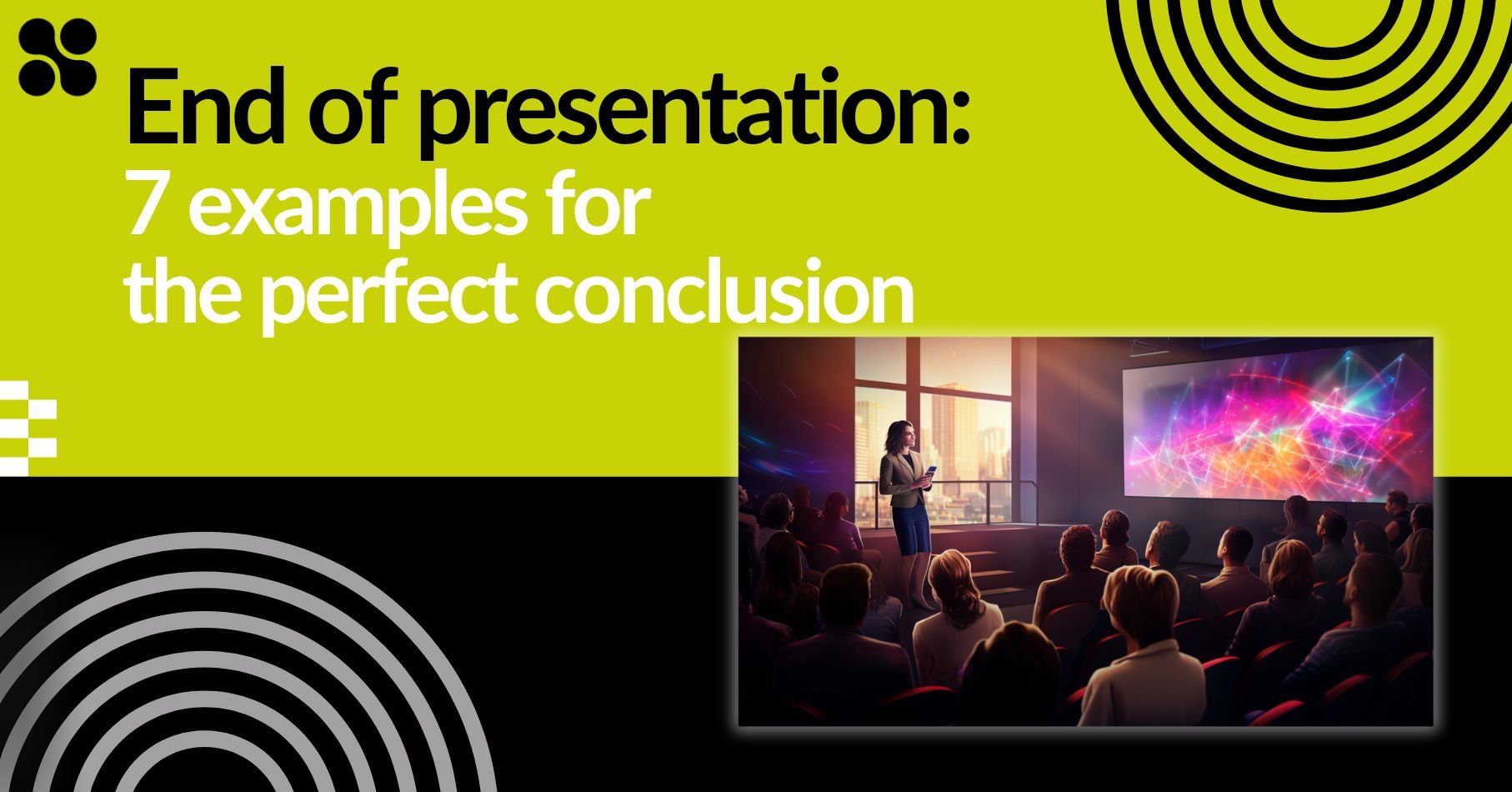
End of presentation: 7 examples for the perfect conclusion
Ending a presentation is like adding the last stroke of a painter's brush - it rounds off the overall picture and creates a lasting impression. But how do you create a powerful end to a presentation that the audience will remember? Let's discover the secret together in this article.
What do you say at the end of a presentation?
You have given a convincing presentation, addressed everything important and got your message across effectively. Now you are faced with the challenge of finding a successful conclusion. This is where the right words matter. A simple "That's it" or "Thank you for your attention" will probably not be remembered by your audience. Instead, you can use a summary of your main points, a call-to-action or a catchy conclusion to leave a strong impression.
Why the end of your presentation is so important?
The end of a presentation is your last chance to leave a lasting impression. It gives you the opportunity to reinforce your message and inspire your audience, or spur them into action. It's not just about wrapping up your presentation, it's about ending it with a bang. Use this opportunity to reiterate your core message and make a strong emotional connection with your audience.
The principle of the recency effect
The recency effect states that people remember best what they heard last. This underlines why the end of your presentation is so important. If you design the end of your presentation effectively, your audience is more likely to remember it. Use this psychological phenomenon to your advantage and ensure that your conclusions and calls to action are remembered.
Presentation end: 7 examples to leave a lasting impression
- Summarize the main points: Repeat the main points of your presentation to reinforce them.
- Call-to-action: Ask your audience to perform a specific action or take a next step.
- Quote: A relevant and powerful quote can leave a lasting impression.
- Story or anecdote: A short, relevant story or anecdote can create an emotional connection and stick in the audience's mind.
- Questions: Ask a rhetorical or open-ended question that is thought-provoking.
- Surprising statistic or fact: An impressive statistic or fact can make a strong impression.
- Humorous remark: A funny remark or joke can lighten the mood and ensure a positive ending.
How to formulate a strong presentation ending
Formulating a strong presentation ending requires practice and creativity. Try to convey your core message in a way that suits your audience and your topic. Remember that your goal is to leave a lasting impression. Be clear, concise and engaging. Use metaphors or stories to illustrate your points and use rhetorical devices such as repetition and triples to reinforce your message. Here are some examples of how you can conclude your presentation:
- Summary and outlook: "Today we discussed the challenges and solutions for our product development. By implementing these solutions, our company will be even more innovative and efficient in the future."
- Call to action: "Now you know the advantages of our product. Let's exploit the opportunities that arise from this together. Let's start implementing it today!"
- Interaction question: "What do you think of these suggestions? Which measures do you see as a priority to achieve our goals?"
- Inspirational quote: "As Albert Einstein said: 'Life is like riding a bicycle. To keep your balance, you have to keep moving'. So let's keep moving and pursue our goals together."
- Positive outlook: "I am confident that with these strategies we can achieve our goals and continue our success."
Each of these closing formulations has its strengths. Choose the one that best suits your style, your audience and your topic. Find out here how you can structure your presentation to create the perfect ending.
Presentation end - Rhetorical questions as a tool
The dos and don'ts for a successful end to a presentation.
It is crucial to design this finale in such a way that it is effective and memorable. To help you do this, here's a clear list of dos and don'ts to keep in mind at the end of your presentation. These tips will give you guidance to captivate your audience until the curtain falls.
| Be clear and precise in your message. | Avoid giving too much information. |
| Keep up the interest until the end. | Do not end abruptly without a summary. |
| Use visual elements to inspire. | Do not use confusing or irrelevant graphics. |
| Involve the audience, e.g. by asking questions. | Don't ignore the feedback and reactions of the audience. |
| Ending with a strong, memorable point. | Avoid repeating important points or messages. |
How long should the end of a presentation last?
Make the end of the presentation fun.
Humor can be a great way to end your presentation in a light and enjoyable way. A joke or funny anecdote can lighten the mood and make your audience laugh. However, make sure the humor is appropriate and relevant to your topic.
What comes at the end of the presentation?
The closing slide of your presentation is your last chance to make a lasting impression. It should summarize your main points and include a call-to-action. You can also include your contact details or links to further resources. Make the closing slide engaging and easy to read to reinforce your message.
Take your presentations to the next level with Collaboard
End of presentation: the art of making a lasting impression.
The end of your presentation is more than just a conclusion. It's your chance to leave a lasting impression, reinforce your message and inspire your audience to take action. Take advantage of this opportunity and use techniques such as repeating your main points, asking rhetorical questions or adding humor to end your presentation effectively. Remember the principle of the recency effect and design your presentation to be memorable. No matter which method you choose, be authentic and stay true to yourself. Your audience will thank you for it.
Checklist: Effective end of presentation
This checklist will help you evaluate the effectiveness of your presentation ending and make sure you've covered all the important aspects. From the clarity of your message to the emotional resonance, these points are crucial to captivating your audience and leaving a lasting impression.
- Clarity of message: Has the main message of your presentation been clearly communicated?
- Answering audience questions: Were relevant questions from the audience addressed during or at the end of your presentation
- Visual impact: Was a strong, powerful image or graphic used effectively to reinforce the message?
- Audience engagement: Were techniques such as direct questions, interactive elements or calls to action used to actively engage the audience?
- Emotional resonance: Did the end of your presentation evoke an emotional response, be it inspiration, thoughtfulness or joy?
- Summary of content: Were the main points of your presentation summarized clearly and concisely?
- Lasting impression: Does the end of your presentation leave a strong, lasting image in the minds of your audience?
Case study: Impressive presentation endings
There are presentations that continue to occupy and inspire us long after they have finished. It's often the ending that leaves a lasting impression. To understand how to design a professional presentation ending, let's take a look at two case studies.
Steve Jobs at Apple product launches
Jobs' famous "One More Thing..." technique was a masterstroke in the art of presentation. After introducing a series of products or features during the presentation, it seemed as if he had reached the end. But then came the moment everyone was waiting for: Jobs returned to the stage, often with the words "There's one more thing...". These words caused great anticipation and excitement in the audience. This approach was more than just a clever finish. It became a trademark of Apple events and a synonym for innovation and surprise. The "One More Thing..." moments were often the introduction of groundbreaking products or features that would shape the technology world. This technique not only enhanced the impact of the presentation, but also left a sense of awe and curiosity.
The power of storytelling in TED Talks
TED Talks have established themselves worldwide as a platform for some of the most inspiring and influential presentations. A key element that sets TED presentations apart is the way speakers end their talks - often with a personal story or transformative experience. These stories are not only poignant, but also a powerful tool to reinforce the message of the presentation.
Presentation end - Frequently asked questions & answers
How do you end a presentation appropriately.
A good ending to a presentation includes a summary of the main points, a convincing conclusion, words of thanks and a willingness to answer questions.
What phrases are suitable for closing a presentation?
Possible phrases could be: "To conclude...", "To summarize...", "In conclusion, I would like to say...", "This brings me to the end of my presentation...".
Should you ask questions at the end of the presentation?
Yes, it is common and recommended to open a Q&A session at the end of the presentation to clear up any ambiguities and encourage dialog.
How should you respond to questions that you cannot answer?
It is important to be honest and admit if you cannot answer a question. You can offer to provide the answer later or ask the audience if someone else can answer the question.
What should you do if no questions are asked?
If no questions are asked, you can ask some prepared questions to stimulate discussion or highlight other aspects of the topic.
How do you thank the audience at the end of a presentation?
A simple "Thank you for your attention" or "Thank you for taking the time to listen to my presentation" is an appropriate way to say thank you.
Recent Posts from Blog
Lessons learned | methode mit collaboard.
Hast Du jemals erlebt, dass sich in unterschiedlichen Projekten dieselben Probleme wiederholen? Trotz aller Bemühungen scheinen...
Miro-Alternatives | Best free Tools 2024
Create a storyboard | guide, tips & tools 2024.
Creating a storyboard may seem complex at first glance, but with the right tools and methods, this process can be simplified...
11 Powerful Brainstorming Tips [MUST READ]
Are you struggling to generate fresh ideas? Brainstorming is a powerful technique to help you generate innovative solutions and...
Stay up to date with the latest collaboration tips and news.
- Student Login:

How to Close Your Presentation in English Powerfully [+ FREE Presentation Checklist]
May 9, 2018 | Business Professional English , Free Resource , Public Speaking & Presentations
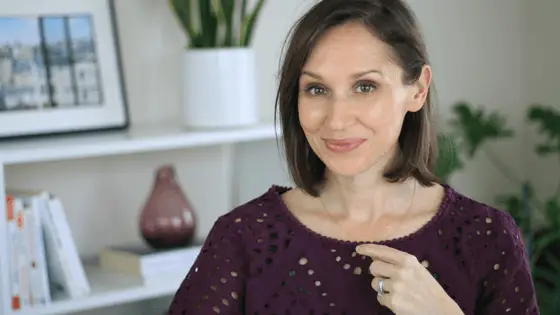
This lesson has been updated from its original posting in 2016.
You’re giving your presentation in English. You have just two minutes left. And it’s time for the conclusion …
Did you know most people only remember the first and last things you tell them? It’s true.
If you are giving a presentation in English, then you definitely want people to remember what you say at the end. And this means your closing must be powerful!
You’ve worked hard on your presentation. You searched for information online. You couldn’t sleep at night. You felt nervous about making mistakes. You spent hours preparing. You reviewed the grammar and vocabulary. You worried about someone asking a question. You practiced and practiced and practiced.
And now it’s the last two minutes. This is the last opportunity for your audience to hear your key points. It is the last chance you have to help your audience remember your comments.
A closing in a presentation should be short and clear. It should summarize your key points. And, most importantly, it should be powerful.
In today’s lesson, you’re going to learn about 3 ways to make your closing more powerful. Plus you’ll learn useful key expressions you can use in your presentation.
3 steps to a powerful closing in your presentation.
Lesson by Annemarie
3 Strategies to Close Your Presentation Powerfully
Use these 3 strategies in your conclusion to:
- recapture your audience’s attention
- get your audience to focus and remember your key points
- help your audience connect with you and your topic
- end your presentation powerfully
One: Include a Call to Action (CTA)
Is there something you want your audience to do or think after your presentation. Do you want them to take action? Tell your audience exactly what you want them to do with a Call to Action.
Here’s my example:
“ After you finish today’s lesson, please take 2 minutes to leave a comment about your experience with presentations. You can share your thoughts or ask questions in the comments section at the bottom of this lesson – it’s the perfect place to join a discussion on this topic.”
A couple useful expressions to help you introduce your CTA is:
- To close, I’d like to ask you to do this one thing…
- And finally, before you leave the conference today, please take two minutes to…
Two: End with a Powerful/Inspirational Quote
Is there one thing you really want your audience to remember? Or is there a specific feeling you want your audience to have after your presentation?
Using a powerful quote can help you do that. You could introduce a great quote or interesting statistic with:
- I’d like to finish with this powerful/interesting/wonderful/inspiring/ quote from …
- And finally, let’s finish up today’s discussion with this surprising/useful/shocking/hopeful statistic …
Here are some example quotes that might help people be prepared to take action or to think differently. But remember! Always match the quote or statistic to your topic:
“In the end, we will remember not the words of our enemies, but the silence of our friends.” – Martin Luther King, Jr. “Sometimes we stare so long at a door that is closing that we see too late the one that is open.” – Alexander Graham Bell
Three: Add a Surprising Fact or Statistic
Is there something you’d love for your audience to think about after your presentation? Is there a statistic or fact that will help someone remember your key points?
A surprising fact can also help re-engage your audience, it will snap their attention back to you.
For example:
Did you know that the human brain’s capacity is limitless – that’s great new right? BUT … did you also know that a person is likely to remember only 25% of a presentation after 24 hours?
Uh oh. That is why it’s SO important to have a powerful ending! Remember: the key is to find a statistic or fact that connects directly to your topic.
Useful Language to Close Your Presentation
Summarize Your Key Points & Close Your Presentation
- That brings us to the end of the presentation. I’d like to summarize by saying …
- That concludes my presentation. However, I’d like to quickly summarize the main points or takeaways.
- And on that final note, that concludes my presentation.
- To quickly recap, I’d like you to remember these key points …
- To summarize …
- In conclusion …
- I’d like to bring this presentation to a close with …
- I’d like to close this talk with …
- So, this concludes the focus of discussion today. To end, I’d like to highlight …
- This concludes [name/title of the section] so let’s move on to the final comments.
Thank Your Audience
- I sincerely appreciate your attention today/this evening/this morning.
- And that brings us to the end. I’d like to thank you for your time and attention today.
- Thank you so much for your interest and attention.
- At this time, I’d like to have my colleague speak so I’ll finish up by saying thank you for your attention.
- I can see that our time is just about up so to finish I’d like to say thank you.
- I sincerely appreciate that I’ve had this opportunity to present to you.
- If there is one thing I would like you to remember from today’s presentation it’s …
Take Questions
- If anyone has any questions, I’d be happy to open up the discussion.
- If anyone has any questions, please feel free to ask now and I’ll do my best to answer.
- Would anyone like to ask any questions?
- I would now be interested to hear from you with your thoughts or questions.
- Now let’s move on to some Q&A. (Q&A = Questions and Answers)
Provide Next Steps or Contact Information
- If you would like more information, here is a list of useful resources/websites.
- If anyone who like more information or has questions, please feel free to contact me at: [include contact info]
- Here is a list for further reading on this topic. (Include the list of books or websites.)
Get the complete Presentations in English Series:
Part 1: How to Prepare for Your Presentation in English
Part 2: How to Start with a Great Introduction in Your Presentation
Part 3: How to Organize Your Presentation in English
Part 4: How to End Your Presentation Powerfully
After you’ve watched the video and reviewed the lesson, I’d love to hear from you!
Tell me about the best presentation you ever heard. Who gave the presentation? And why do you remember it? Share what you remember in the comments section below.
And for the bonus question!! Have you given a presentation in English? What tips or advice would you like to share with others? You can add your advice in the comments section.
Thank you so much for joining me!
~ Annemarie
Get the Confidence to Say What You Want in English
Follow my 3-step solution to speak English with clarity, fluency, and freedom so you can say what you want with confidence.
You'll also get my Confident English lessons delivered by email every Wednesday and occasional information about available courses. You can unsubscribe any time.
More Like This
![how to write conclusion presentation #318: Collocations with Situation | Advanced Vocabulary [+ Free Worksheet]](https://www.speakconfidentenglish.com/wp-content/uploads/2024/08/Collocations-with-Situation-400x250.webp)
#318: Collocations with Situation | Advanced Vocabulary [+ Free Worksheet]
Searching for a smart method to build up vocabulary in English? In this lesson, you’ll discover how to master English collocations—a key strategy to make your English sound more natural and fluent.

#317: When to Use Rather Than and Instead Of | Accurate English Grammar
Confused about when to use “rather than” and “instead of”? 😕 These two phrases might seem similar, but they have distinct meanings and usages that can make a big difference in your English communication.

#316: Alternatives to ‘I Understand’ for Daily Conversations | Upgrade Your English
Using alternatives to ‘I understand’ enhances your vocabulary for daily conversations and helps you communicate more effectively and confidently.

#315: Think in English and Speak Faster in Conversations (How to Stop Translating in Your Head)
If you’ve ever struggled to translate your thoughts quickly, learn to transform how you think in English so you can speak faster in conversations.

#314: Master English Networking: How to Network with Coffee Chats
English speakers love creating new words, and we do it regularly with word blends such as glamping, hangry, bromance, and more. Discover current popular word blends in English.

#313: How to Understand English TV Without Subtitles
© Copyright 2014-2024 Speak Confident English | Privacy Policy | Terms & Disclaimer | Online Class Policies
I’m glad to hear it was helpful!
This was very helpful
Thanks, Ma’am/Sir. This helped me a lot…
Same here ma’am
This is so helpful. Thank you so much
This helped a lot. Thank you so much <3
I accidentally found your page while working on my English video presentation. It’s really helpful. Thanks soooo much 🙂
I’m very glad to know it was helpful!
Hi! I found your page very insightful. Thank you very much!
I’m glad to hear it!
great video series. thank you so much. you mentioned that you had a downloadable checklist in the final video. where could I find this thanks?
Hi Ellie, I’m glad the series was helpful.
When you visit the lesson, there should be an image that pops up with an opportunity to get the download. If you don’t see it, please let me know so I can fix it.
Helped a lot! Thank you very much <33
thank you so much
I love your method
Hello, I have a 5 minute oral presentation of a fictional book, w/the main focus on the leadership traits of the characters. I enjoyed the book, and suspect others might, so to that end, is it OK to NOT share the ending? Thank you
Thanks for your help 🙂
Great website. I found a typo in on the presentation closings page “Useful Langauge to Close Your Presentation”.
Good eyes! Thanks so much for the note. We’ve fixed the typo.
Dear Annemarie, thank you so much for sharing.
Dear Annemarie, thank you so much for sharing. I learned so much from your 4 videos and I will work on improving my presentation skills. Love your spirit of excellence. For me as a presenter, its important i am passionate about the topic i share and audience will be able to apply some of the learnings in their life. Thank you Annemarie. I love your voice too. Stay blessed.
I watch continuously watched ur 4 videos and U r a great teacher.Thanks for making such purposeful videos.
I am so happy , I have more form you thank you very much
You are absolutely wonderful and your website is extremely useful and also quit impressive i habe my english A-levels in December i copied this text i sinisterly appreciate that i have had this opportunity to present to you and i also add something * it was a honor for me so thank you ☺️
Thanks, Jasmin! I’m so glad to know my lessons are helpful to you.
hey Annemarie could you help me in ending my presentation on mental health. it is a school presentation for MUN
If you’d like editing help, please see our options for 1:1 classes .
You are my favorite speaker. ☺
Hi Anna, that’s so kind of you. Thank you. 🙂
It’s so useful to us…… I’m so happy by this
I’m glad it was helpful to you, Kalpana.
I was holistically stuck about how to give my first ever presentation, but this gave me an impetus and confidence. Thanks a lot for this exquisite info
Awesome. I’m glad this helped you to move forward.
Thank YOU for tour tips. They are really inspiring. I Will try to put them into practise.
Hi Nancy, Wonderful! I’m glad they’re helpful to you!
It’s so useful to us…… I’m so happy by this
do you have Presentation course
Hi Hammad, I don’t at this time but it’s definitely something I’m thinking about.
Join Annemarie for an English Fluency Breakthrough starting September 2.
Pin It on Pinterest

7 Powerful Ways To End a Presentation
by Janice Tomich
- Presentation Planning & Public Speaking Skills
Have you ever attended a presentation or speech and didn’t know when it was over? Maybe you were even unsure if it was time to clap or get up and leave?
Your audience not knowing when a presentation has finished is a clear sign that you need to work on your conclusion. If you ending isn’t clear the closing statements sputter. Don’t let your words fizzle out.
People attend your presentation or speech to learn from you. Your passion for what you’ll be sharing started long ago. Keep that passion clear from your personal introduction right through your conclusion if you want the impact of your words to continue well past the time you step off the stage.
It’s crucial you get both the open and close of your speech right.
The conclusion is especially pivotal, because if you’ve thoughtfully structured your presentation at the end you will influence your audience to be inspired to do what you had planned with the information you’ve shared.
There are many different ways to close a presentation effectively.
If you’re lost and unsure about how to make your presentation compelling, I can help.
I’ll start with explaining 7 powerful ways I’ve seen my public speaking coaching clients end their speeches, and then give you my advice about two common ways to close a presentation which you should avoid.
Table of Contents
7 Techniques for Ending Your Presentation Powerfully
1. end with a overt call to action.
The most overt type of close is the Call To Action or CTA. A call to action is a clear, direct statement to your audience of what you want them to do next. Use this type of presentation conclusion when you want to be perfectly clear about your message.

This closing technique transparently encourages your audience to do something as concrete as “buy my book” or “sign my petition” or “take on a challenge.”
I once had the privilege of seeing Dr Hans Rosling deliver a TED Talk . He is an excellent presenter and a master of the close. Based on his research, he clearly challenges his audience to take his data to make decisions about resources needed for population growth. The talk is worth watching if you’re planning out a closing statement, because it’s a brilliant example of a strong close.
2. End with a a Soft and Subtle Call To Action
Have you ever left a presentation inspired to do something differently, even if you were not specifically directed to take action? The closing technique you witnessed was probably a subtler version of a CTA.
For a masterful example of this closing technique, watch the end of Tim Urban’s TED Talk on procrastination. Notice that he never specifically tells you to take action – to stop procrastinating. Instead, he gets you onboard in a soft way, slowly building up his argument via a number of examples of his own experience with procrastination.
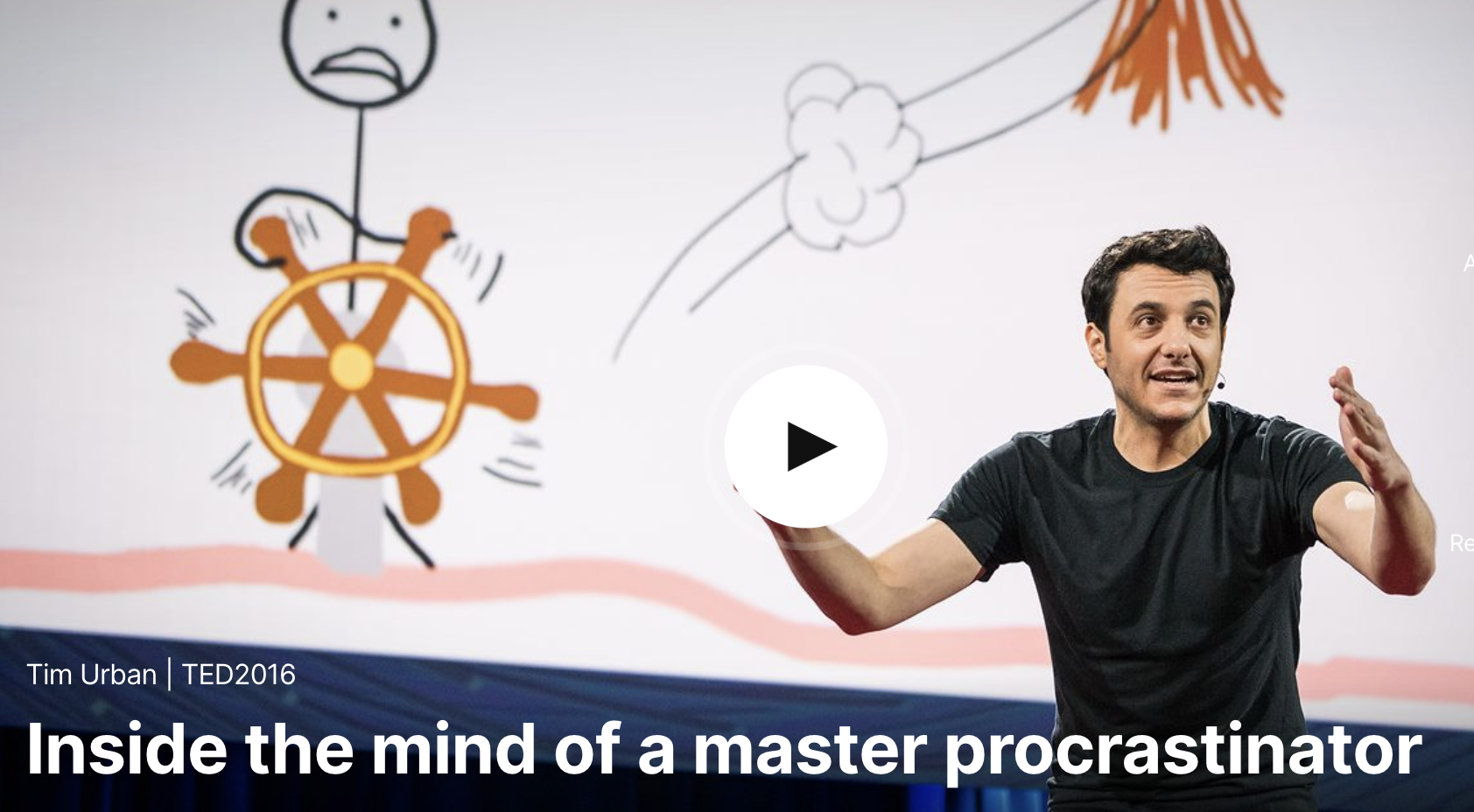
Then, close to the end, he shows a visual which leaves you reassessing your life and what you will do with the remainder of it.
Tim’s masterful presentation conclusion has prompted many people to take action and change their habits, but it’s subtle and leaves you thinking as if the conclusions you come to are you own idea, not his.
3. Use a Quote to End Your Presentation
Using a quote for your final words can be an effective way to end your presentation. Choose your quote carefully, however—the quote needs to align with your message and clearly communicate your key point. Never use an obscure or confusing quotation. Don’t make your audience work too hard to understand the relationship between the quote on your final slide and your overall message.
One of the most touching quotes I heard used to conclude an inspirational speech was the last lines of the Mary Oliver poem “Summer’s Day”: “Tell me, what is it you will do – With your one wild and precious life?”
It kept me thinking about the preciousness of the days, how I had permission to push limits, and what those limits might be.
4. Finish Your Presentation By Closing The Loop
Create intrigue with a story which takes your audience on a journey. Using storytelling in business presentations or in a speech, threading it throughout, is not only a good way to grab the audience’s attention and enhance engagement. It’s also a powerful way to come to a conclusion when you finish your story.
Dr. Amy Cuddy’s TED Talk uses the “close the loop” technique brilliantly. She begins her presentation telling us about an accident she had that impacted her ability to thrive in university. She worked hard to make progress. Under the mentorship of a professor she thrived.
Dr. Cuddy goes on to talk about her research into how we can build confidence through body language techniques. She winds her talk up by speaking about a student of hers that she mentored through a lack of confidence…and very craftily closes the loop.
5. End Your Speech Using the Rule of Three
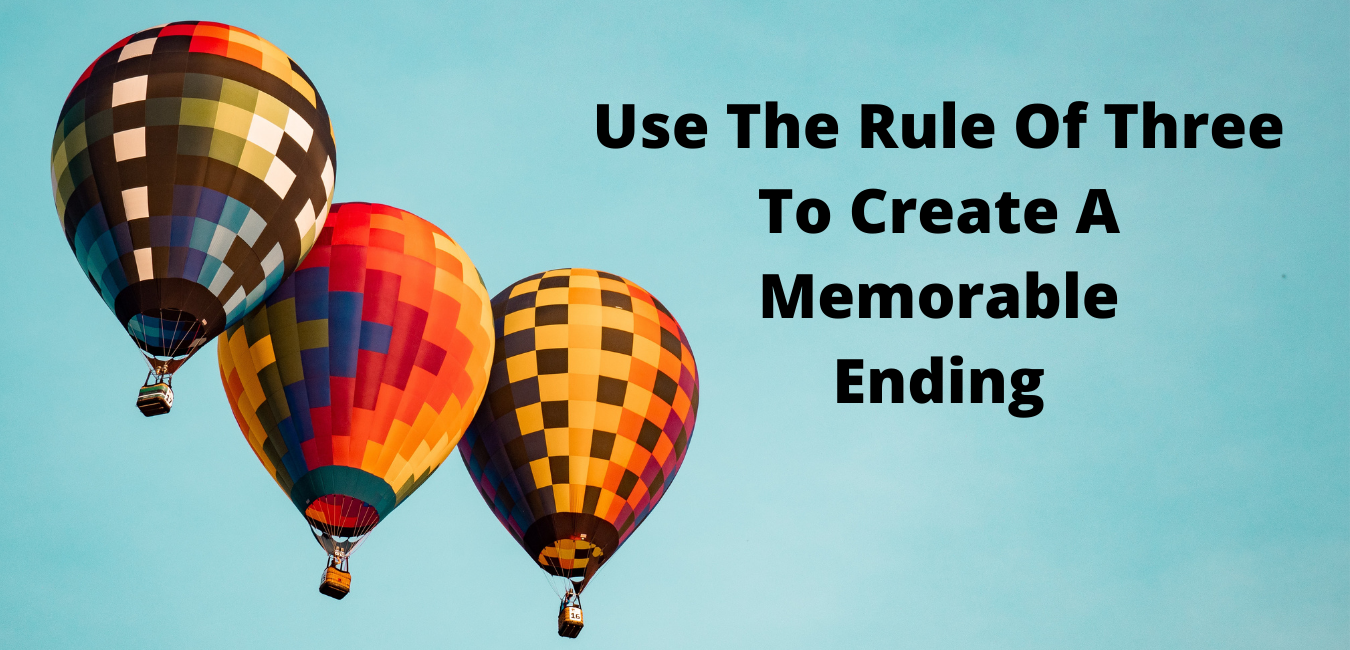
A communication technique called the Rule of Three is a powerful way to end your speech. Using this technique to end your presentation will make your key message stick.
An example of the Rule of Three is this Winston Churchill quote, “This is not the end. It is not even the beginning of the end. But it is, perhaps, the end of the beginning”.
Using three concepts triggers your brain to recognize a pattern, which humans are wired to do. Pattern recognition is how we make sense of things, it’s how we connect the dots and make meaning from the message.
Use the Rule of Three if you want your closing remarks to be remembered long after your audience leaves their seats.

Sucheta Misra Associate VP Inclusion & Diversity and Social Impact Leader
6. Finish with a Thought Provoking Question
There is value in having your audience walk away thinking about the questions you asked in your conclusion—and their personal responses to them. We humans are natural problem solvers. A question is a sticky way to create a memorable ending.
In his TED Talk, What Baby Boomers Can Learn From Millennials & Vice-Versa , Chip Conley provides food for thought about how we can all be contributors in the workplace by creating generational bridges. He asks, “Personally, who can you reach out to to create a mutual mentorship relationship? And organizationally, how can you create the conditions to foster an intergenerational flow of wisdom?” It’s not a rhetorical question, it’s a call to action. Chip finishes his presentation by telling us that bridges are the true sharing economy.
7. Deliver a Summary to Close Your Presentation
Delivering a summary of your core message can be an effective way to conclude, but be careful. Using a summary to finish your presentation sometimes risks losing your audience’s attention. If you name the main message(s) by rote, as if you’re rattling off a series of bullet points, the conclusion is likely to flop. Instead, use your summary slide to close your speech inspirationally, reviewing the key message and critically “the why.” Without the why, your summary will be forgotten in minutes.
2 Things to Avoid in Your Conclusion
Preparing, writing, and delivering a powerful speech is difficult, and some speakers are unprepared when they approach their closing remarks. Here are two things to avoid:
1. Running Out of Time
A poorly thought out and only minimally practiced presentation usually results in you having to cram your final remarks into the last few minutes of your allotted time. Your audience won’t be able to digest your final concepts if your words come at double-speed.
When you rush to the finish line not only will you feel stressed, your audience will too. This can seriously mar your reputation as a polished and professional public speaker.
2. Finish with a Question and Answer Session
You’re the speaker. You’ve been invited to take the stage and the audience is there to hear your ideas. The impact of too many otherwise excellent presentations are dulled in the last minutes, when a presenter opens the floor to questions, which are sometimes commandeered by someone in the room whose motivations might not align with your own. Your audience will remember your response to the last question. End with a question and answer session and you’ve essentially let someone else write your conclusion for you.
Question and answer sections aren’t a bad thing, but don’t end with them. Finish up your presentation by having all eyes on you. Close on your own terms.
The final (and best) tip I can give you is no matter the closing technique you choose to end your presentation or keynote address , is to practice it until it is firmly embedded into your memory. You want to know it inside out (and upside down) with absolute full confidence so you won’t have to scramble to come to a full stop.
You don’t have to prepare a presentation alone. If you’re feeling stuck or uninspired by your presentation’s conclusion, I invite you to book a 1-hour presentation strategy session . I’ll help you create a powerful ending that will have your audience leaving inspired.
If you’d like help with the entire presentation, I do that too. We can work together, one on one, to develop and create your next presentation or speech so you can deliver it with confidence and ease -> Prepare For Your Upcoming Presentation, Speech, or Talk .
Share this post:
Related Posts
How Much Should I Charge to Give a Keynote Speech?
Someone has just asked you how much you charge to give a keynote speech. What should you answer? It depends. I’m a public speaking coach. That gives me an insider’s view of keynote speaking costs
7 Public Speaking Books Actually Worth Your Time
Most people dislike public speaking. In fact, the stats say 73% of people fear delivering presentations or talks. If you are one of the 73%, you don’t have to be. There is an abundance of standout books
Yes, Anyone Can Become a Charismatic Speaker. Here’s how.
Is it possible to become a charismatic speaker if you weren’t born with the talent? Someone asked me that question at one of the first workshops I delivered as a public speaking coach. And it
Janice Tomich Site Map
Testimonials
Social Media
© 2023 Janice Tomich. All Rights Reserved. Privacy Policy | Terms of Use

Give the keynote. Without the nerves.
Newly Launched - AI Presentation Maker

Researched by Consultants from Top-Tier Management Companies

AI PPT Maker
Powerpoint Templates
Icon Bundle
Kpi Dashboard
Professional
Business Plans
Swot Analysis
Gantt Chart
Business Proposal
Marketing Plan
Project Management
Business Case
Business Model
Cyber Security
Business PPT
Digital Marketing
Digital Transformation
Human Resources
Product Management
Artificial Intelligence
Company Profile
Acknowledgement PPT
PPT Presentation
Reports Brochures
One Page Pitch
Interview PPT
All Categories
Top 10 Conclusion Slide Templates with Examples and Samples
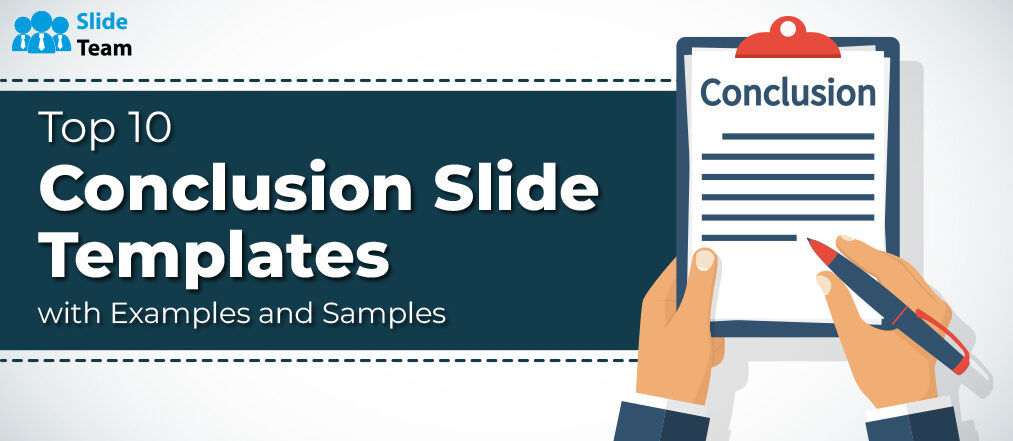
Siranjeev Santhanam
The concluding moments of a presentation hold a unique power. They are the crescendo, the final brushstroke on the canvas, and the lingering resonance that shapes perceptions. Within the theatre of boardrooms and conference halls, creating impactful presentations with good and meaningful conclusions is not just a formality but a strategic necessity. These pivotal moments are what ultimately sway minds within boardrooms, leaving an indelible mark on the minds of the major decision-makers in business.
Are you having a hard time with SMS marketing? We’ve got something tailor made for you. Click here to check out our other blog on SMS marketing slides now.
The Role of Presentation Conclusions
When a presentation draws to a close, the audience is most vulnerable to lasting impressions. The conclusion of a discussion is the critical juncture where the narrative converges, and the concepts and ideas crystallize into a final robust takeaway. A well-crafted conclusion can help a professional to etch his or her message into the collective minds of the audience. Whether it be unveiling a bold new venture, outlining crucial plans, or dissecting complicated data, the conclusion gives a presentation enough reason, and ripe ground, to take mundane information and transform it into insight.
In this blog, we’re going to be taking a look at ten conclusion slides. These templates, like all others in SlideTeam’s curation, come with the distinct advantage of being easy to access and easy to customize, giving users optimal flexibility and convenience when deploying them.
Let’s begin.
Business is all about knowing your competition, and then working to get ahead of them. Click here and check out our other blog on competitor analysis slides to excel at this art
Template 1 Project Conclusion PPT Presentation Slides
The slides of this vibrant PPT can be configured to serve as the concluding piece in any large-scale presentation within the corporate medium. There are 30 slides in this deck, with headlines ranging from performance analysis and budget/cost analysis to open issues, project health card, project dashboard, and more. Take control of the narrative by synthesizing a cogent and impactful conclusion, all with the aid of this presentation deck that can assist you in this and more.
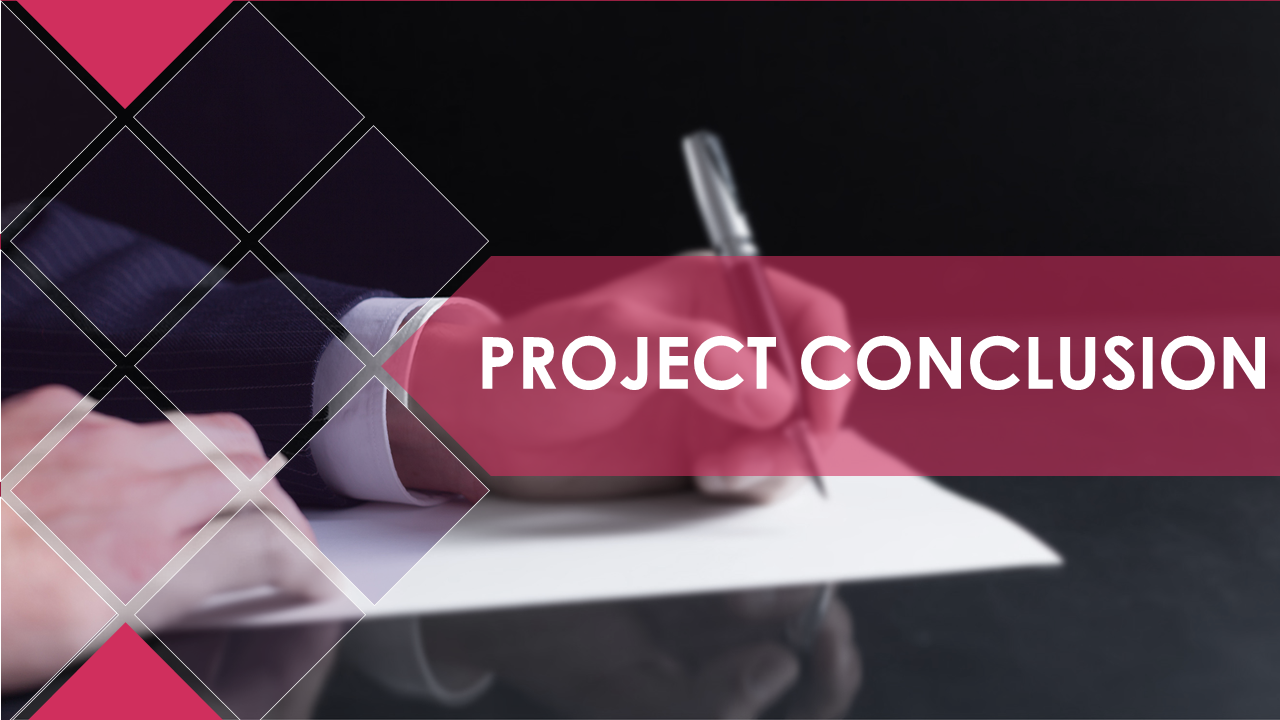
Download now
Template 2 Conclusions Findings PPT Slides Rules
Unlock the true potential of your presentations with a concise and influential conclusion slide that can embolden the storytelling prowess of the medium. Do this and more with the aid of one-page conclusion slide, made to reflect professionalism and excellence. The slide gives you space for a set of subheadings with smaller content brackets where you can lay out the inherent content of your findings or conclusions in a structured and organized manner.
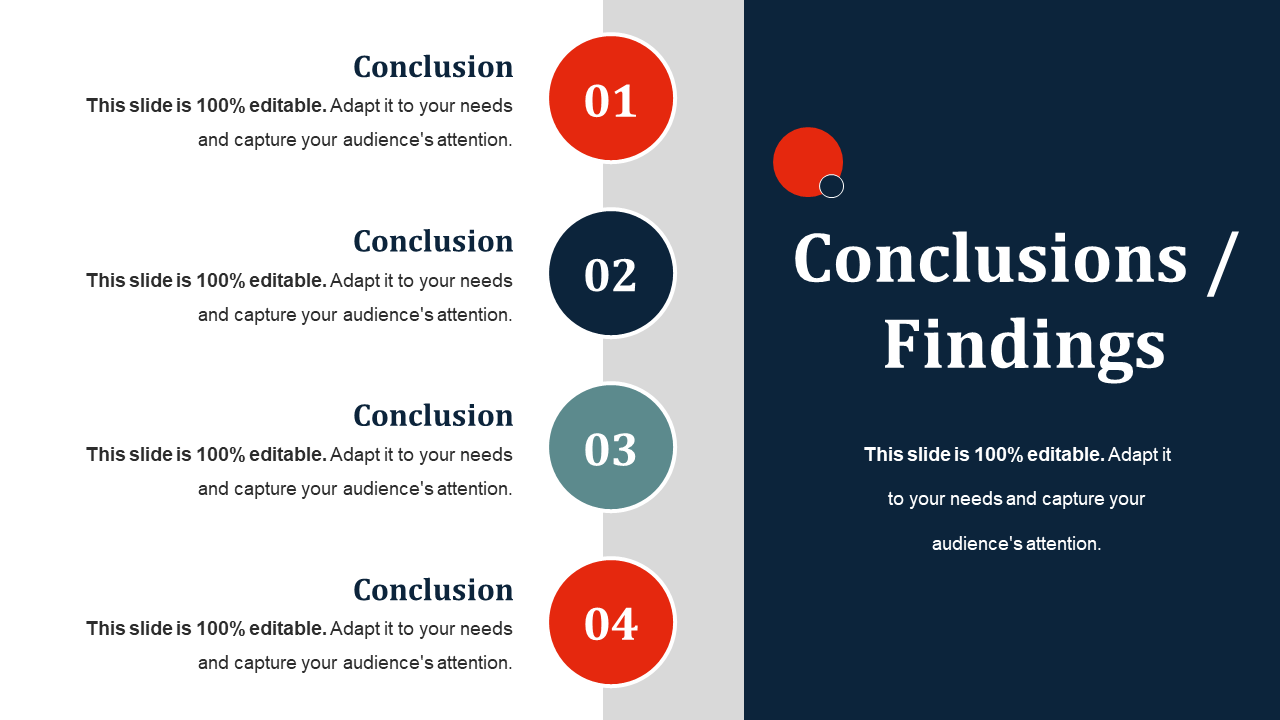
Template 3 Conclusion Slides Shown by Gears and Bulb connected
This animated slide is made to represent the creative process in its most age-old form, with a light bulb and gears depicted as an illustration of ideas and innovation. Integrated alongside this is a great breadth of space where you can summarize the main points of your presentation in a series of points with subheadings and smaller explanations alongside it. Use this one-page PPT as a canvas for your business insights, providing a holistic view of the crucial information you seek to present.
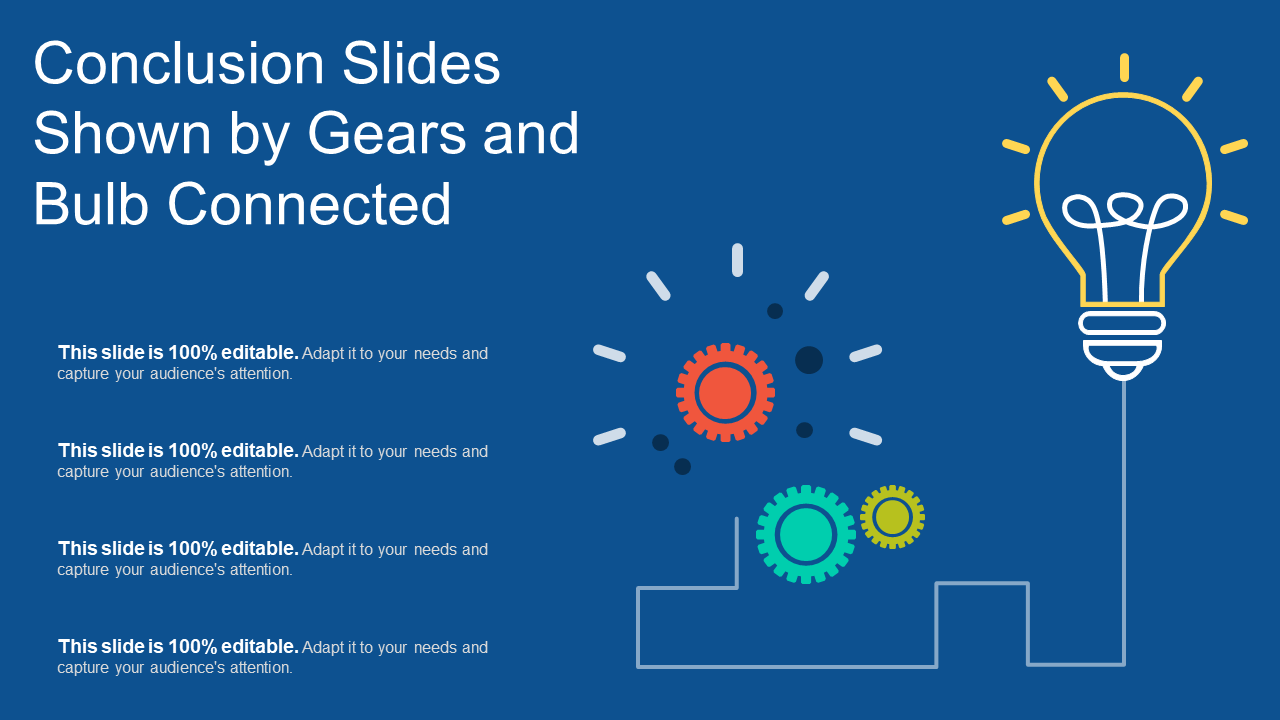
Template 4 - Conclusion slides future scope with human image and protruded arrows
Take your presentations to new heights with the aid of this one-page conclusion slide tailored to serve the corporate arena. Seamlessly weave together critical components of the presentation with this one slide, creating a memorable and impactful conclusion to the broader discussion. The slide has a clear white background and an array of smaller bullet points where you can list the major summarized points with ease.
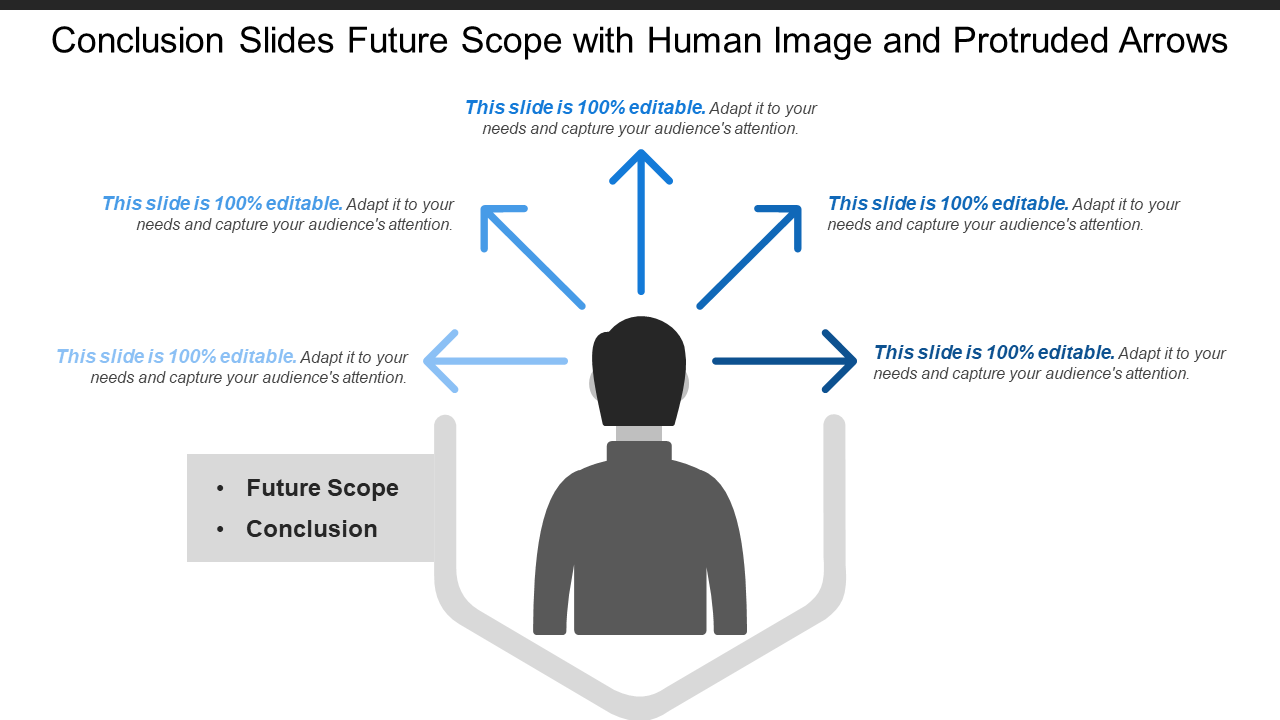
Template 5 Closing slide image with conclusion
This colorfully-rendered slide is sure to get audience’s attention, helping to cap off a complex and rewarding discussion staged during corporate hours. Use this one-page theme to empower your audiences, breaking down and conveying crucial complex data with a sense of cohesion and clarity. Seize control of the narrative and make a bolder impact with this one-page conclusion PPT Template. Get it now.
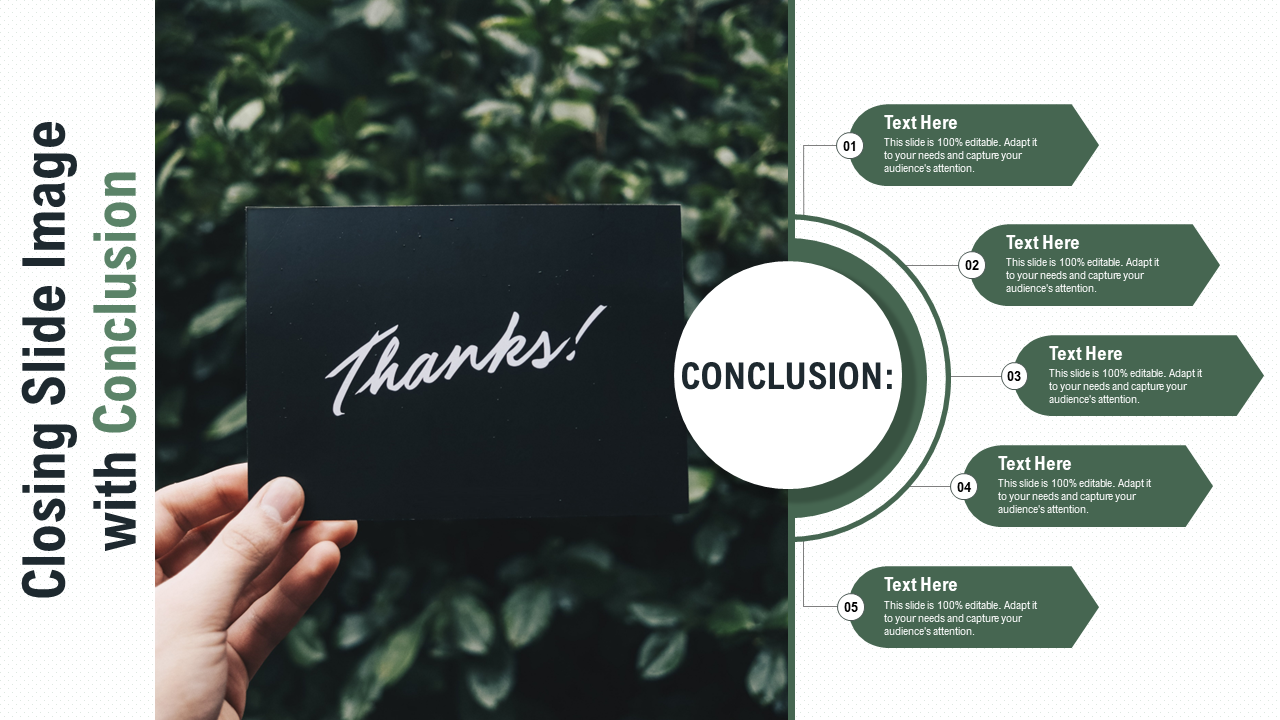
Template 6 Conclusion Slides Image with Magnifying Glass and Document
Crafting a meaningful and impactful conclusion becomes more effortless with the aid of a simple, elegant slide such as this one. Use this one-page theme as a business asset, giving you the capacity to assemble and synthesize key data points as you want to create a lasting impression on your audience. The slide is suited for business related situations, and comes with the added benefit of being easy to modify to fit any necessary circumstance as well. Get it now.
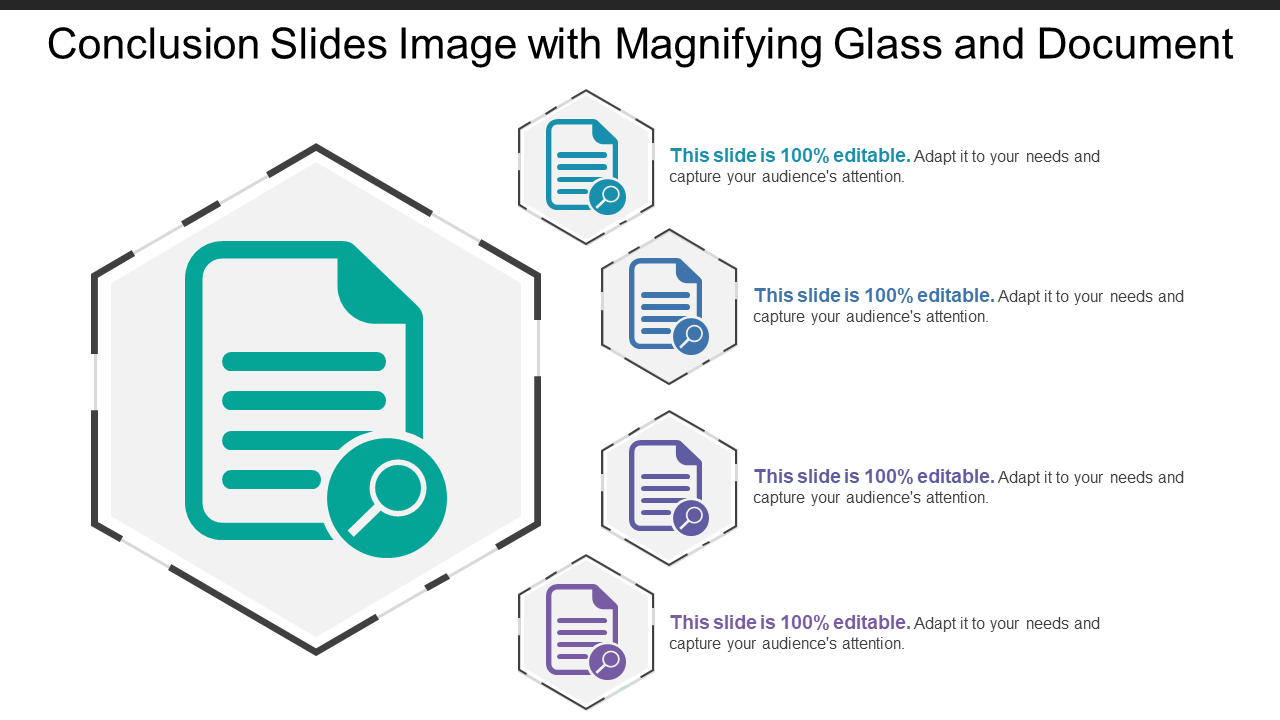
Template 7 Conclusion Slides Reliability Efficiency Cost Size Usability Market
Introducing this slide, which is crafted to serve a forward-thinking professional. This one-page PowerPoint piece can help satiate the needs of any business meeting, caging your audience's attention at the conclusion of a meeting. The all-white color palette and intuitive design can help to amplify the message, giving you the tools to streamline complex data through visually cohesive narratives.
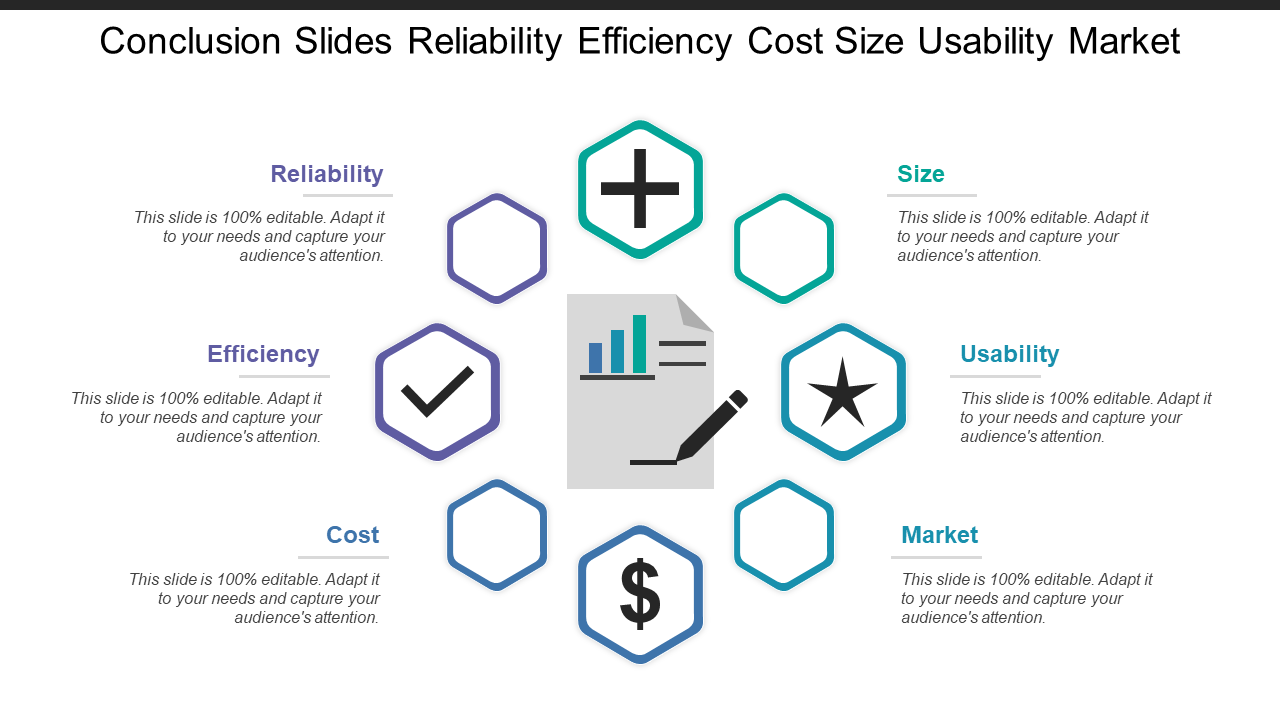
Template 8 - Conclusion and recommendations communication PPT Presentation Slides
Incorporate this conclusion slide into your presentation to transform the experience, ensuring that your audience is captivated by the unfolding discussion and the strategic journey that is being uncovered. It is divided into two segments - conclusion and recommendations. Both come with content brackets for additional information that you can insert at your own discretion. Get this slide now and nurture an optimistic, creative environment within your business spaces.
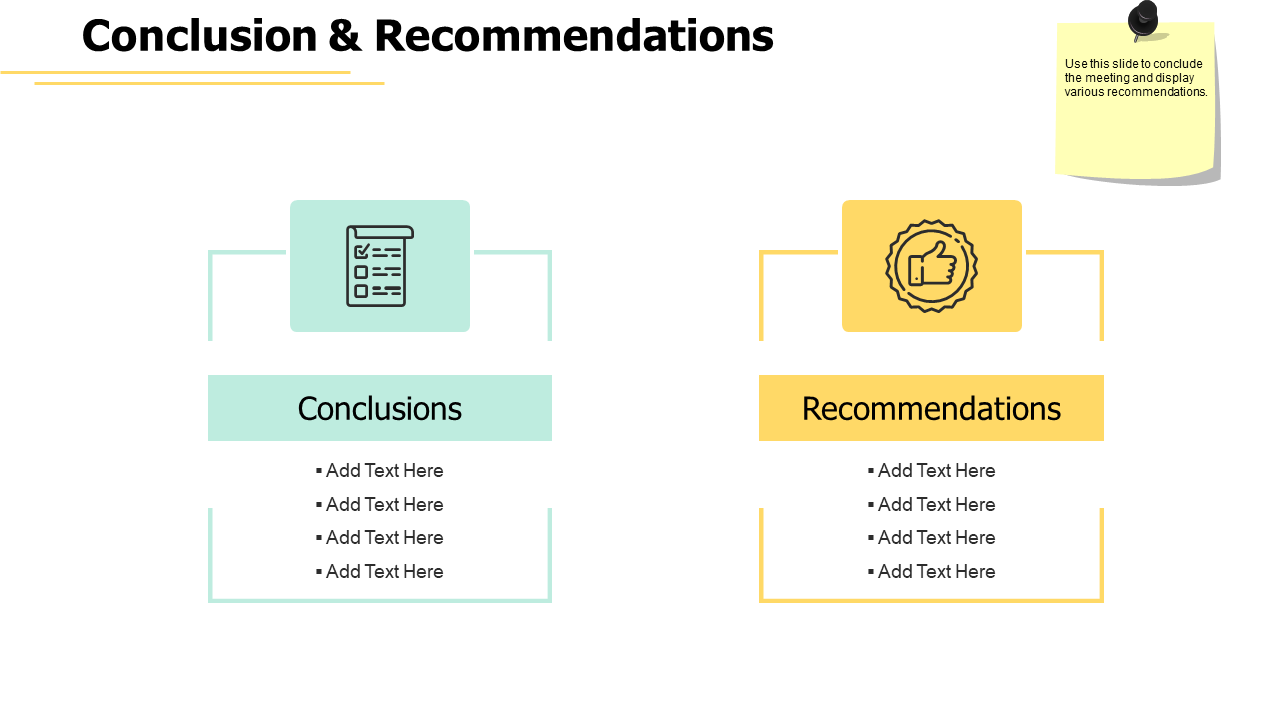
Template 9 Conclusion PPT Slide Influencers
Don't let crucial discussions in the business medium become background noise featured as part of mundane presentations. Carve your mark with a more rousing conclusion, implemented with the aid of this one-page PPT. It features two separate segments within a broader canvas, allowing you to pose questions and to leave room for answers, as part of the conclusion of the presentation. Get it now and morph your presentation into a more fruitful experience.

Template 10 Conclusion Slides Pen Image with Case Study Project Plan and Solutions
This one-page theme has been infused with a dynamic design and helps you illustrate critical data at the end of a discussion. Dissect the intricate details of your discussion with refined precision, all with the aid of this slide. It comes with a group of pre-loaded subheadings and space for additional information beneath all of them. Immerse your audience in a narrative that captivates as it informs, cementing your message in their consciousness, so that you are able to use it desired.
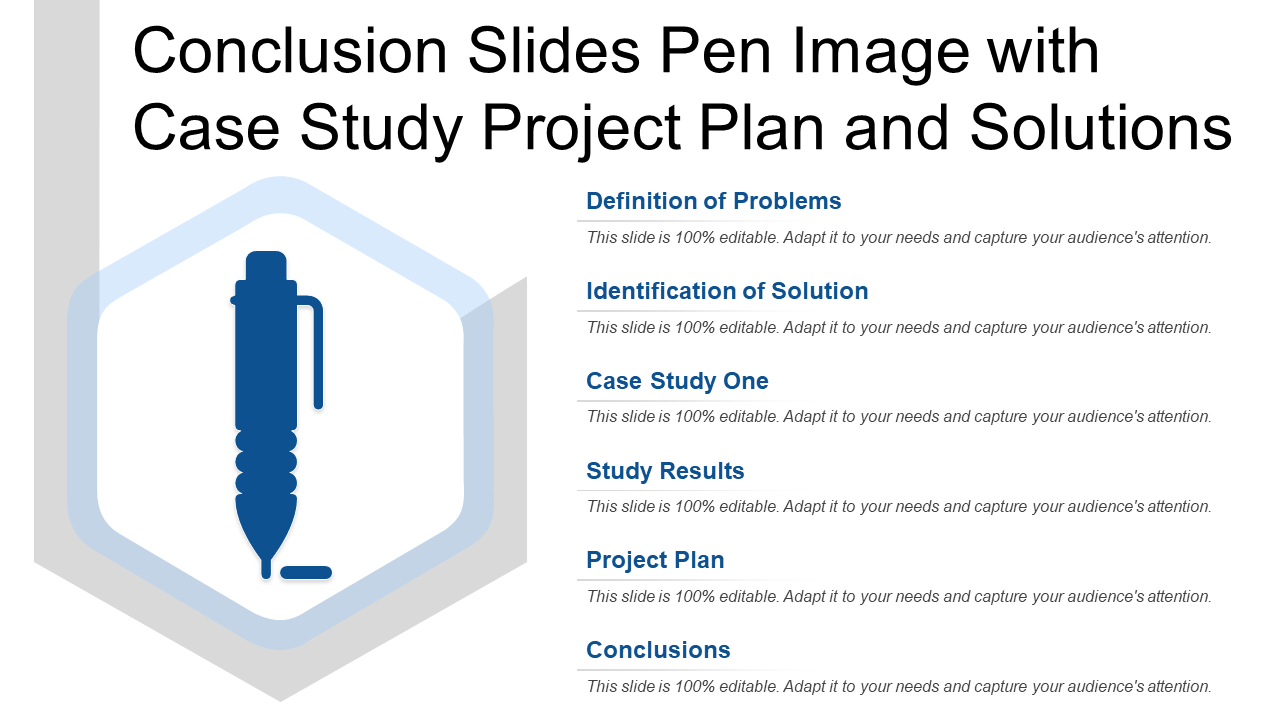
THE END-GAME IS USUALLY FINE
In a broader discussion within the business sphere, the conclusion is the ripe moment to evoke emotional resonance from the audience. It’s the moment where you transcend the charts, graphs and data and instead bridge a deeper connection with the audience. A well-crafted conclusion can help synthesize vital data, while also giving the audience the tools to mould the insights into personal initiatives. It can empower your team members to take the next step, aligning their actions with the presented vision.
PS Don’t click away just yet, we’ve got more for you. Click here to read our other blog that delves into company profile templates now.
Related posts:
- How to Design the Perfect Service Launch Presentation [Custom Launch Deck Included]
- Quarterly Business Review Presentation: All the Essential Slides You Need in Your Deck
- [Updated 2023] How to Design The Perfect Product Launch Presentation [Best Templates Included]
- 99% of the Pitches Fail! Find Out What Makes Any Startup a Success
Liked this blog? Please recommend us

Top 10 Attrition Dashboard Templates with Examples and Samples
Top 10 Demographics Icon PowerPoint Templates with Samples and Examples
This form is protected by reCAPTCHA - the Google Privacy Policy and Terms of Service apply.

--> Digital revolution powerpoint presentation slides

--> Sales funnel results presentation layouts
--> 3d men joinning circular jigsaw puzzles ppt graphics icons

--> Business Strategic Planning Template For Organizations Powerpoint Presentation Slides

--> Future plan powerpoint template slide

--> Project Management Team Powerpoint Presentation Slides

--> Brand marketing powerpoint presentation slides

--> Launching a new service powerpoint presentation with slides go to market

--> Agenda powerpoint slide show

--> Four key metrics donut chart with percentage

--> Engineering and technology ppt inspiration example introduction continuous process improvement

--> Meet our team representing in circular format

Contact Brian
Brian Krogh
How to Write a Great Conclusion for Your Next Presentation

Imagine you are at the end of a long flight.
Your pilot signals her initial descent, lowers the landing gear, and nears the runway. You squirm in your seat, and think about how you cannot wait to get off the plane. As you longingly peer out the window you see the white stripes on the runway streaking past you. Surprisingly, just before the wheels touch down, the pilot revs the engines and quickly ascends into the clouds.
You immediately wonder what is wrong. The pilot, however, comes over the speakers and says, "hi folks, don't worry, nothing is wrong, I just felt like flying a little more today."
Now imagine the pilot does this four or five more times. How frustrated are you?
Presentations and flights have something in common - the best ones conclude well. As an audience member it can be frustrating when a speaker struggles to land the plane at the end of an otherwise effective presentation.
Have you ever sat in a meeting and heard the presenter say "in conclusion" only to keep rambling for fifteen more minutes? How about the speaker who says "let me finish with this" six times before they stop talking?
Phrases like these indicate a speaker has not properly planned their landing and the audience, who is ready to leave, quickly grows frustrated.
Perhaps even more ineffective, is a conclusion that is little more than a slide that says, "Thank You." That is like cutting power to the engines right before the wheels touch down and letting the wheels slam violently onto the runway.
It leaves the audience wondering, "what was that all about?"
A conclusion is your lasting impression on your audience. If your presentation is to be memorable, your conclusion must be designed and executed well.
An effective conclusion will do three things.
- Offer a clear ACTION STEP
- Sum up the presentation with one BIG IDEA
- CEMENT the idea with a compelling story or data point.
It's as simple as ABC: Action step, Big Idea, Cement with a story.
How you end will determine if your audience leaves feeling inspired or indignant.
As a presenter it is tempting to focus on your introduction and the body of your presentation and overlook the conclusion. If you are to inspire others to action you need to write out your conclusion every time you speak and you need to leave time to deliver a conclusion without going over your allotted time limit. It's that important.
When you speak, land the plane smoothly and you will be amazed at the results.
Not sure how to talk to your team about presenting your company's most important information?
I would love to meet you and provide you with some value whether or not we work together long term. Let’s put something on the calendar.
Book a Free Call
Say it Better
© 2023, Brian Krogh

Presentation 101: How to Conclude Your Presentation with a Strong End
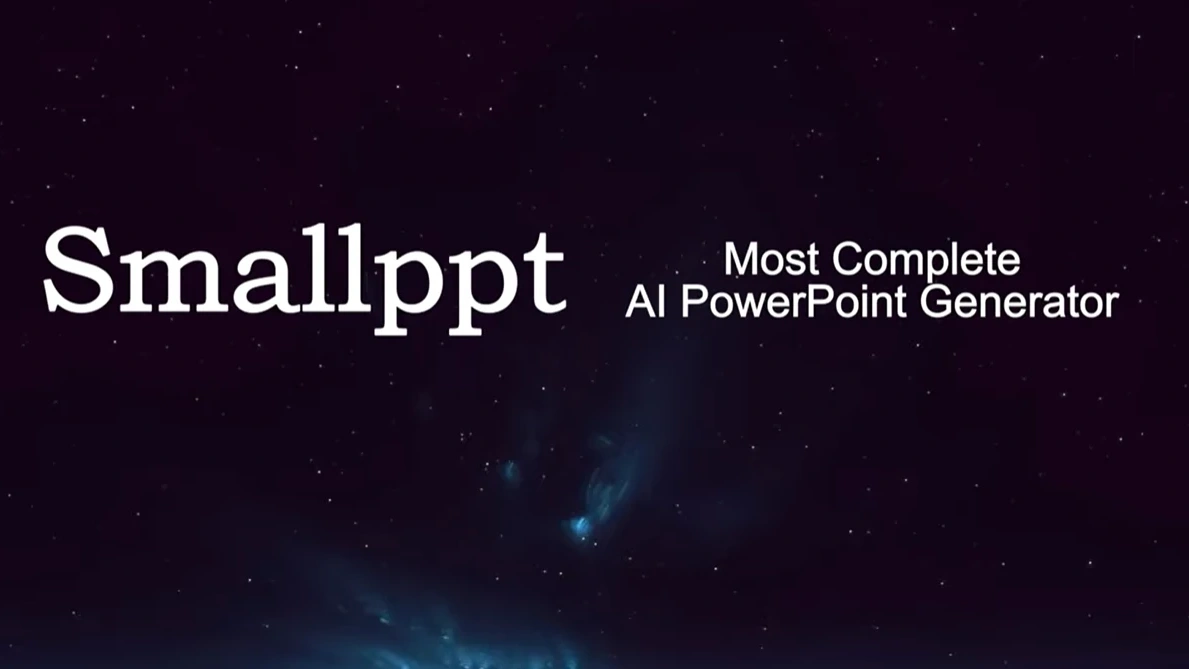
What do you do when you're ready to close a presentation? Maybe you'll just summarize the main points to end the topic, or make a call to launch an initiative, or play a video related to the topic, and so on. Typically, there are many methods to have a strong ending in presentation. Different presenters can have different methods. Overall, presenters should end their presentation with a strong end to motivate their audience. In this blog post, we’ll dive into the benefits of a strong end in presentation and the methods to conclude a presentation well.
What are the benefits of a good ending in presentation?
1.Leave a deep impression on the audience. At the end of the presentation, we can summarize the content of the presentation, emphasize the key points, or use a vivid metaphor to summarize the whole text, so that the audience has a clear impression of the content of the presentation, which can make the audience remember our presentation more deeply.
2.Enhance the persuasive power of the presentation. At the end of the speech, we can re-emphasize our own position and point of view, or use some thought-provoking words to impress the audience, so that they will resonate with our point of view, to enhance the persuasive power of the presentation.
3.Leave the audience with good feelings. At the end of the presentation, we can use some warm words to thank the audience for listening and support, or to express our good wishes for the future, so that the audience will still be immersed in a good emotion when they leave the presentation.
4.Add a sense of completeness to the presentation. At the end of the presentation, we can summarize the whole presentation, review the key content of the presentation, so that the whole presentation presents a complete structure, so that the audience feels that the content of the presentation is clear and logical, so as to increase the attractiveness of the presentation.
5.Provide a strong call to action: A well-crafted ending can prompt your audience to take action, whether it's to implement your suggestions, support your cause, or purchase your product or service
Seven Tips for have a strong end in your presentation:
1.Call to Action. At the end of the speech, he used his profound understanding and unique insights to offer hope and appeal to the audience. This kind of ending can inspire the audience's enthusiasm and make the audience take action.
E.g. "Now that we've discussed the importance of saving water resource, I urge each of you to commit to one small change in your daily lives to reduce water pollution. Whether repeatedly use water or reduce bath time, every action counts towards a more sustainable future."
2.Reiteration of Key Points. This is the most common way to end. Generally speaking, restating a point can help the audience review the speech and deepen their memory and understanding.
E.g. "In conclusion, our three main strategies for improving customer satisfaction are proactive communication, personalized service, and swift issue resolution. By implementing these strategies consistently, we can strengthen our relationships with customers and drive long-term loyalty."
3.Quotations or Anecdotes. This method uses a poem or a famous quote to summarize the key points. It not only makes the speech dramatic but also better conveys the speaker's emotions.
E.g. "As Lao Tzu said, ‘The journey of a thousand miles begins with one step.’ Let's remember these words as we are going to implement our plan.”
4.Visuals or Demonstrations. Using tools such as video at the end of a speech can better capture the audience's attention, increase the visual impact of the speech, and convey the message more vividly.
E.g. "Before we conclude, let me show you a brief video showcasing the impact of protect the marine environment. the beautiful sight of the sea serves as a powerful reminder of why our work is so important."
5.Open-Ended Questions. By using open-ended questions to elicit responses from your audience, you can effectively engage your audience and make your presentation more memorable.
E.g. "Finally, I'd like to leave you with a question: What role can each of us play in promoting diversity and inclusion within our organization? I encourage you to reflect on this question and share your thoughts with your colleagues."
6.Give a Storytelling. Sharing a story at the end is equivalent to responding to the speech with an example. This not only attracts the audience's interest, but also emphasizes the content of the speech.
E.g. "Let me share a story with you. Years ago, a small team of passionate individuals set out to change the world with nothing but an idea and a relentless drive to succeed. Today, that idea has transformed into a global movement, touching the lives of millions. Remember, it all started with a vision and the courage to pursue it."
7.Inspiring or Motivational Statements. This method can directly express the speaker's ideas. Give the audience a powerful attraction.
E.g. "As we conclude today's presentation, I want to leave you with this thought: No matter how daunting the challenges may seem, never underestimate the power of perseverance and innovation. Together, we have the ability to overcome any obstacle and create a brighter future for generations to come."
Generate you PowerPoint Presentation with Smallppt
Smallppt's AI PowerPoint is a game-changer in the realm of PowerPoint presentations. Its innovative features, collaborative capabilities, and focus on aesthetics redefine the standards of presentation creation. Professionals can now achieve excellence effortlessly with this advanced ai presentation tool.
It transforms the dull task of presentation creation into a seamless and delightful process. With a focus on design, content, and collaboration, Smallppt ensures that professionals can effortlessly craft presentations that leave a lasting impression. Elevate your presentations, captivate your audience, and redefine your professional narrative with the power of AI.
Enjoy your AI making PowerPoint in Smallppt!

- EXPLORE Random Article
- Happiness Hub
Best Ways to Conclude a Presentation
Last Updated: October 4, 2023 Fact Checked
Strategies for Wrapping up a Presentation
Other best practice presentation tips, public speaking advice, how should you end a presentation.
This article was co-authored by Patrick Muñoz and by wikiHow staff writer, Ali Garbacz, B.A. . Patrick is an internationally recognized Voice & Speech Coach, focusing on public speaking, vocal power, accent and dialects, accent reduction, voiceover, acting and speech therapy. He has worked with clients such as Penelope Cruz, Eva Longoria, and Roselyn Sanchez. He was voted LA's Favorite Voice and Dialect Coach by BACKSTAGE, is the voice and speech coach for Disney and Turner Classic Movies, and is a member of Voice and Speech Trainers Association. There are 7 references cited in this article, which can be found at the bottom of the page. This article has been fact-checked, ensuring the accuracy of any cited facts and confirming the authority of its sources. This article has been viewed 6,366 times.
You’ve just spent the last hour or so preparing a super thorough and detailed presentation. Now it’s time to add the finishing touches and come up with an attention-grabbing and memorable closer. What strategies can you use to make sure that people really remember what you've said? Keep reading to learn all the most effective methods you can use to conclude your presentation in a way that’ll really stick with your audience. We'll cover different strategies you can mix and match to end your presentation with a bang, then follow up with public speaking tips. Let's dive in!
Things You Should Know
- Bring your presentation to a close by first giving a clear indication that you’ll be wrapping up, followed by a short summary of your main ideas.
- Grab your audience’s attention with a strong call to action and an explanation of what good things will happen when they listen to your message.
- Make your presentation memorable by embellishing it with a powerful quote, a story, or a surprising statistic or fact.
- Get your audience involved by running a poll or survey at the end of your presentation.

- “In conclusion…”
- “In summary…”
- “As I conclude my presentation, let me ask you a question.”
- “This brings me to the end of my presentation today.”
- “In respect of time, allow me to wrap up my last comments.”

- “That brings me to the conclusion of my presentation. If you’re to take anything away from my presentation today, let it be the three Cs of credit that we talked about: character, capacity, and capital.”
- "Above all else, remember the acronym RAM: redesign, application, and management."

- “When you volunteer for this program, you will build your skills and gain valuable experiences.”
- “You will participate in the increased profitability of our company by joining this new program.”
- “Make this company a more inclusive and healthy place to work by taking just a few minutes out of your day to do these small actions.”

- “As the Greek historian Plutarch once said, ‘The mind is not a vessel to be filled, but a fire to be kindled.’ Let’s kindle the fire within our minds and make the changes we want to see.”
- “I’ll leave you today with a quote from Theodore Roosevelt: ‘Far and away the best prize that life offers is the chance to work hard at work worth doing.’”
- “Work hard to inspire not only those around you, but yourself as well.”

- Pair this statistic or fact with a memorable visual, such as an illustrated graph, a video, or a picture. The more visual your presentation is, the more memorable it will be to your audience.

- Another way to go about telling a story is to start it in your presentation’s intro and end it during the conclusion. Your audience will be curious to know how the story ends.

- “What do you think the word ‘success’ means?”
- “How can we make an impact every day through the work we do?”
- “Why do you think people are so afraid of change and questioning the way things have always been done?”
- Asking a question at the beginning of your presentation and answering it during the conclusion is another strategy to consider. Just be sure that you don’t forget to answer this question and accidentally leave your audience hanging.

- “What’s your usual mood during the workday?”
- “Have you ever presented your supervisor with a new idea or suggestion?”
- “Do you see yourself participating in this new program?”

- What they liked and disliked about the presentation
- What improvements could be made
- One memorable thing they took away from your presentation

- Before your presentation, go and talk with some of the audience members. This will give them a chance to warm up to you and can help you feel more relaxed once you get up and start presenting.

- Using hand gestures also shows the audience that you’re in control of the space around you, and makes you appear much more confident and at ease.

Expert Q&A
- Keep in mind that your presentation gives you the chance to be a messenger. Give your audience something meaningful to walk with at the end of your speech. Thanks Helpful 0 Not Helpful 0
You Might Also Like

- ↑ https://www.businessinsider.com/worst-ways-to-end-a-presentation-2014-7
- ↑ https://www.washington.edu/doit/presentation-tips-0
- ↑ https://www.wilmu.edu/edtech/documents/the-science-of-effective-presenations---prezi-vs-powerpoint.pdf
- ↑ https://www.mentimeter.com/blog/awesome-presentations/ways-to-end-a-presentation-and-tools
- ↑ https://www.niu.edu/presentations/organize/index.shtml
- ↑ https://www.forbes.com/sites/forbescoachescouncil/2017/11/02/15-methods-of-every-effective-public-speaker/?sh=3a911bdd3047
- ↑ https://youtu.be/VRJzvJ5XPQI?t=11
About this article

Did this article help you?

- About wikiHow
- Terms of Use
- Privacy Policy
- Do Not Sell or Share My Info
- Not Selling Info

How to Write a Conclusion for PowerPoint Presentation

How to Write an Anecdotal Essay
Saying goodbye isn't easy; ending a PowerPoint presentation requires the right conclusion too. Leaving your audience with a compelling conclusion of the presentation is crucial. This culmination of a PowerPoint presentation to rally your listeners' attention and help them focus on your final statements and overall presentation. Crafting a solid conclusion to summarize your main points and ideas provides a way for your audience to research the topic further or contact you to get more information.
Summary of Major Points
Provide a brief, condensed summary of your major ideas, viewpoints or persuasive arguments. The goal is to use your conclusion to stress the most relevant facts and opinions that you presented. This is the information you want your listeners to remember. Use only one "conclusion" slide, and make sure it's the last one of your entire presentation. To avoid weakening your conclusion, do not put other slides after that final slide. To avoid lengthy, cumbersome sentences, list the main ideas using bullet points.
Final Conclusions and Interpretations
Explain in a short concluding statement how you came to your final conclusions or assessments and why your viewpoints matter. For example, if your PowerPoint presentation discusses dangers associated with distracted driving, you might write "Distracted driving, such as texting, talking on a cell phone, eating, drinking and attending to young children, contributes to car accidents. I have argued that driver training courses must stress the importance of avoiding these temptations and laws should reflect non-distracted driving requirements."
Discussion Question or Analogy
Include a final question for discussion on your "conclusion" slide if you plan to end your presentation with audience involvement, such as a question-and-answer session. Otherwise, you might conclude with a lighthearted joke. Choose a joke, memorable analogy or experience that's appropriate for your audience and fits the tone and mood of your presentation. For example, if your PowerPoint presentation is about investing in stocks and other securities for the long haul, you might use Aesop's fable about the tortoise and the hare to send your audience one final message.
Contact Information
List your contact information, such as your business email address, so your audience can contact you with questions or comments about your PowerPoint presentation. If your presentation is for a high-school or college class, you might provide your personal email address and cell phone number, if you feel comfortable doing so. If you have remaining room on your concluding slide, provide a list of websites or resources your viewers might consult in reference to your topic.
Related Articles

How to Summarize a Presentation

How to Write an Introduction to a Reflective Essay

How to Evaluate an Oral Presentation

How to Create a PowerPoint Presentation for College Class

How to Do a Paper Review Presentation
How to structure a presentation.

Tips on Writing a Welcome Address at a High School Graduation

How to Write a Short Essay Describing Your Background
- The Writing Center: Writing a PowerPoint Presentation
- NCSL: Tips for Making Effective Powerpoint Presentations
As curriculum developer and educator, Kristine Tucker has enjoyed the plethora of English assignments she's read (and graded!) over the years. Her experiences as vice-president of an energy consulting firm have given her the opportunity to explore business writing and HR. Tucker has a BA and holds Ohio teaching credentials.
Home Blog Presentation Ideas How to Write a Presentation Script
How to Write a Presentation Script
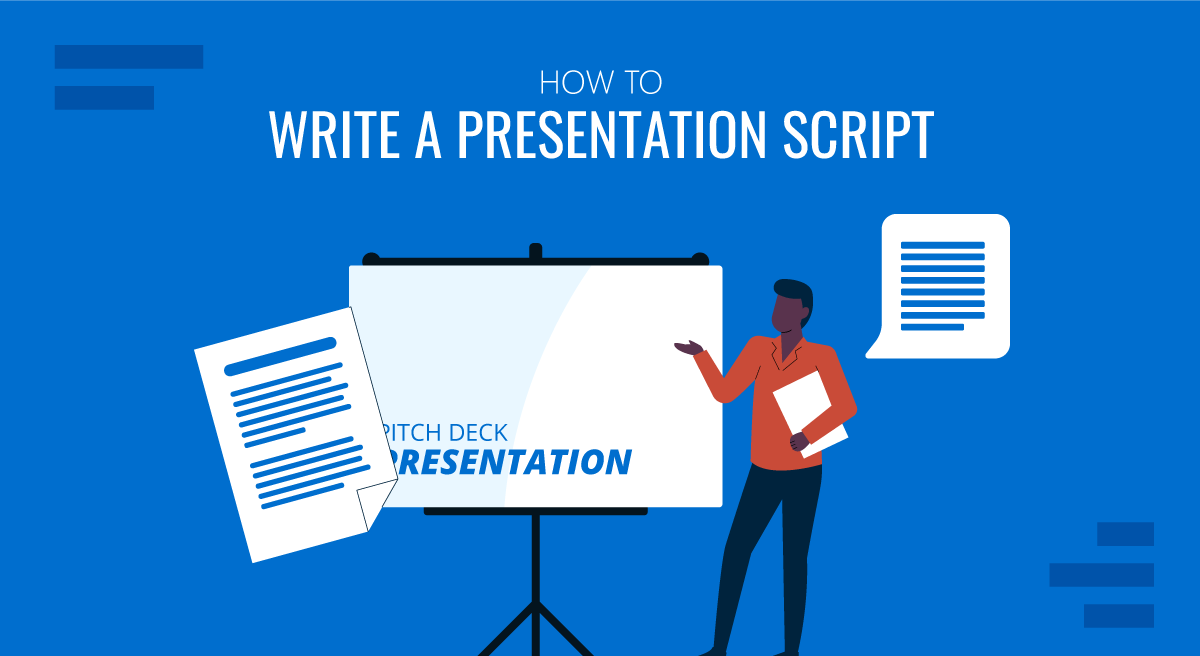
Delivering a successful presentation is a combination of a confident speech and professional-quality graphics. The first element is sometimes neglected, as presenters rely mostly on the slides and add an improvisation element to the speech. Truth is, if you aim to hone your presentation skills, you need to work on the speech. And for that to be a powerful asset, the answer is to learn how to write an effective presentation script.
This article will detail how to create a presentation script, which elements it should contain, how to relate the script to the presenter’s notes, and much more.
Table of Contents
What is a Presentation Script
How do you start a presentation script, how do you write a presentation script, how to connect a presentation script with presenter notes, recommended ppt templates to write a presentation script, final words.
A presentation script is a written guide that outlines what a speaker will say during a presentation. It includes the key points, transitions, and supporting details needed to communicate the message clearly and effectively. The script helps the speaker stay on track, ensuring the presentation is organized, concise, and delivered within the allotted time. It often integrates cues for visual aids and other presentation elements.
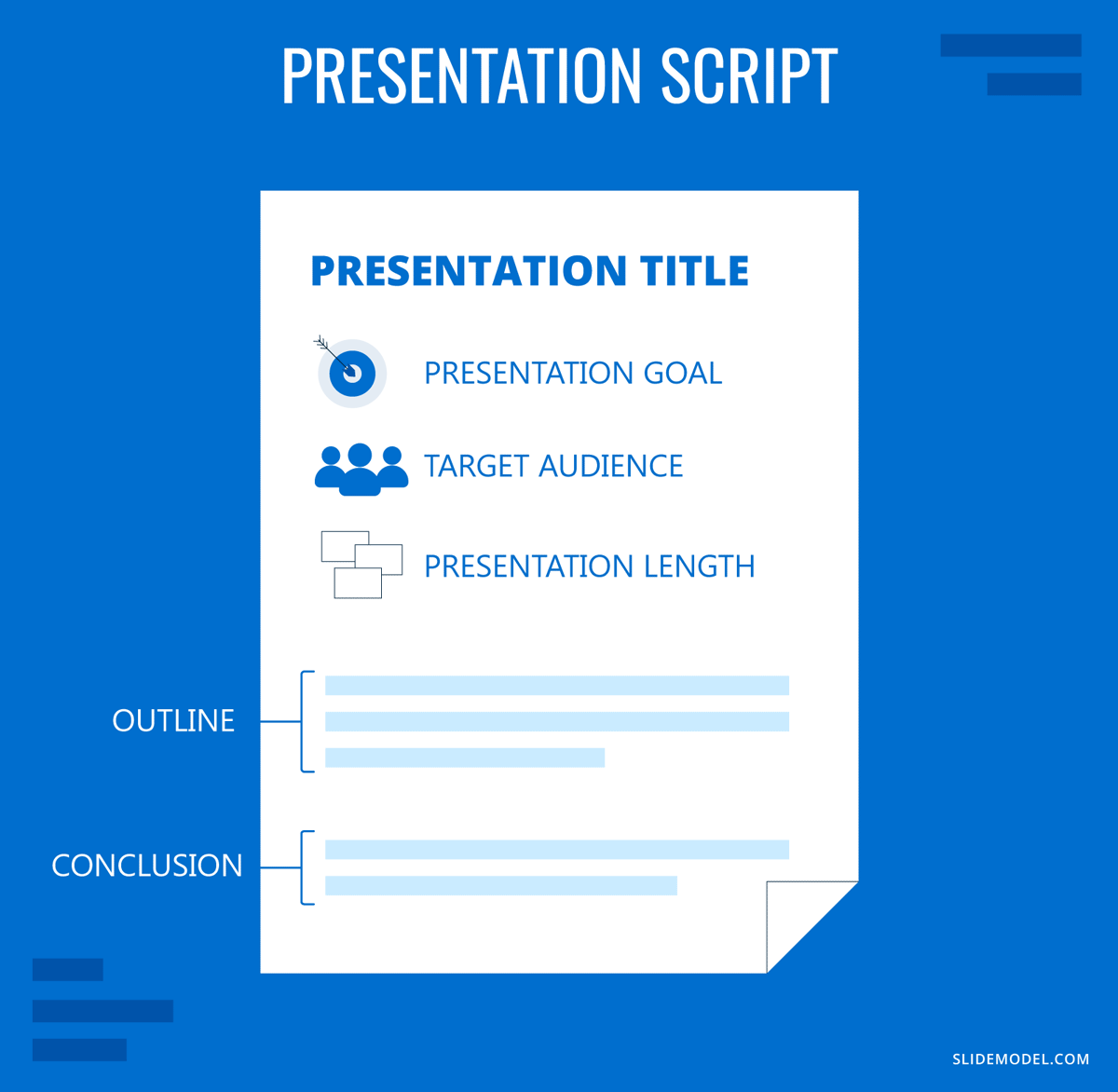
Defining the Purpose and Objective
Every effective presentation script starts with clearly understanding its purpose and objectives. Defining these elements early ensures your script remains focused, relevant, and aligned with your desired outcomes.
Your core message is the central idea you want your audience to take away from your presentation. It should be clear, concise, and memorable. To define your core message, ask yourself:
- What is the one thing I want my audience to remember?
- Why is this message important?
- How does this message benefit my audience?
Once you have a clear core message, everything in your script for a speech should support and reinforce it. This focus will help you avoid straying into irrelevant topics and ensure your presentation remains cohesive.
Next, the presenter should establish clear objectives for the talk. Objectives must be specific, measurable outcomes you want to achieve with your presentation. They give you a clear direction and help you measure the success of your presentation. Objectives can be:
- Informational: Educate the audience on a particular topic.
- Persuasive: Convince the audience to adopt a viewpoint or take a specific action.
- Motivational: Inspire the audience to feel or act in a certain way.
- Instructional: Teach the audience how to do something.
For example, suppose your core message is about the importance of cybersecurity. In that case, your objectives might include informing the audience about common threats, persuading them to adopt better security practices, and instructing them on implementing them.
Check our article on SMART goal setting for a practical approach to defining measurable goals.
Aligning the Script with Desired Outcomes
Once you’ve defined your core message and objectives, your script should be structured to achieve these outcomes. This involves:
- Prioritizing content: Focus on the information and arguments directly contributing to your objectives.
- Building logical flow: Ensure that each section of your presentation leads naturally to the next, creating a narrative that reinforces your core message.
- Incorporating calls to action: If your objective is to persuade or motivate, include clear, actionable steps your audience can take after the presentation.
By defining the purpose and objectives of your presentation script, you set the stage for a focused, effective, and impactful delivery.
In this section, we’ll explore section by section how to write a presentation script. The following image is a guideline of presentation script examples on how to create icebreakers for each section
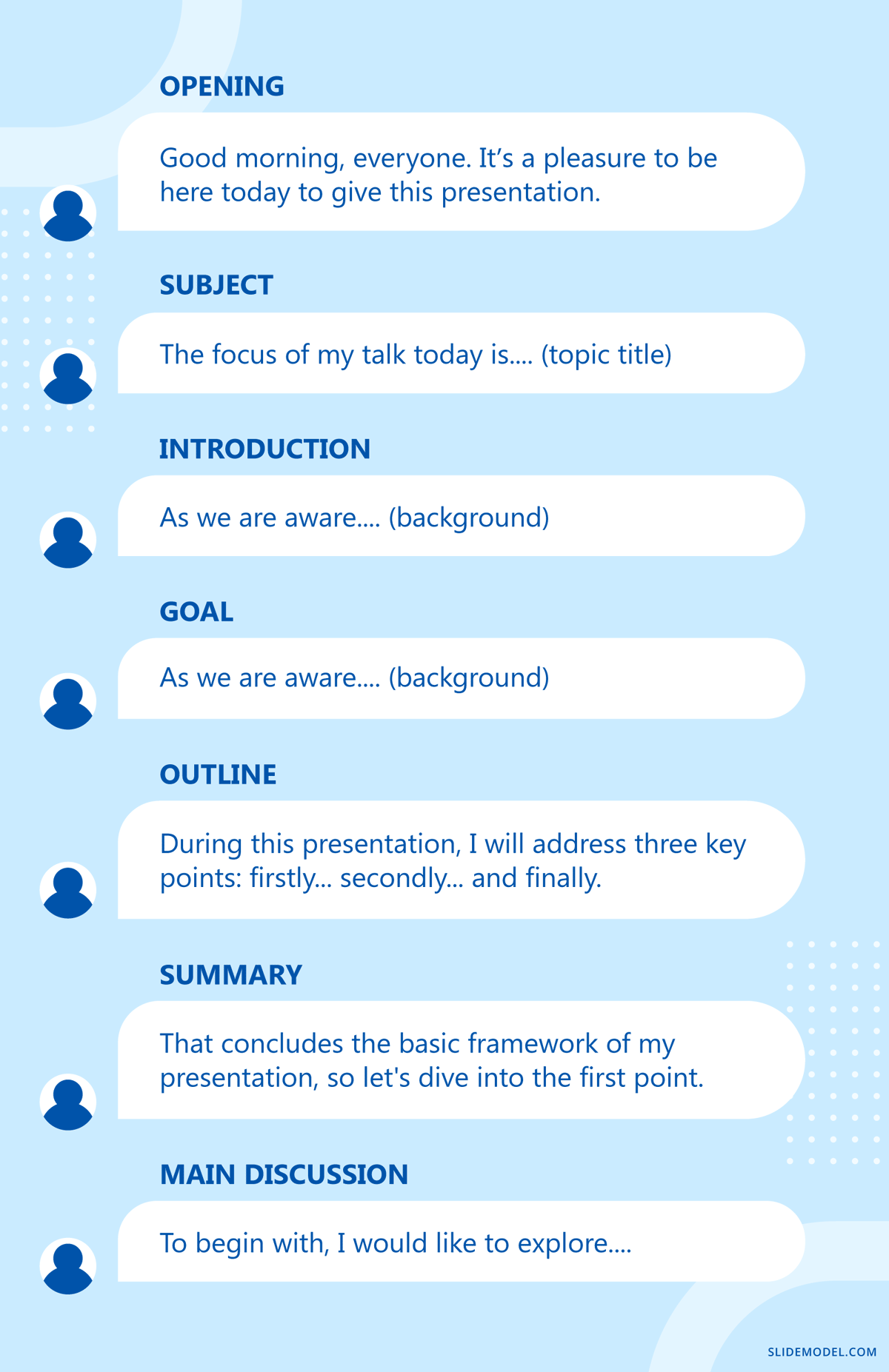
Crafting a Compelling Introduction
The introduction is your opportunity to capture the audience’s attention and set the tone for the rest of the presentation. It should be engaging and clearly overview what the audience can expect.
If you are wondering how to start a presentation , key elements of a strong introduction include:
- Opening hook: Start with a statement, question, or anecdote that grabs the audience’s attention. This could be a surprising statistic, a relevant quote, or a provocative question.
- Purpose statement: Clearly state the purpose of your presentation and what you hope to achieve. This helps the audience understand why they should care about your words.
- Agenda overview: Briefly outline the main points you will cover. This will give the audience a roadmap of what to expect and help them follow along.
Let’s say your presentation is about digital marketing trends. In that case, you might start with a surprising statistic about the growth of AI technology usage, followed by a statement about the importance of staying ahead of digital trends, and then outline the specific trends you will discuss in an upcoming slide.

Organizing the Body of the Script
The body of your script is where you present your main content. It should be organized logically, with each section building on the previous one to reinforce your core message.
Break down your content into clear, manageable sections. Each section should cover a specific point or idea. Smooth transitions between sections help maintain the flow of your presentation and keep the audience engaged . Phrases like “building on that idea,” “another important factor,” or “let’s now shift our focus to” can help guide the audience through your presentation.
Use data, examples, case studies , and visuals to support your points. This will strengthen your argument and make your presentation more engaging.
For instance, in a presentation about social media’s impact on consumer behavior, you might organize the body into sections on social media usage trends, the psychology of social media influence, and case studies of successful social media campaigns.

Engaging the Audience with Stories and Examples
One of the most effective ways to make your presentation engaging and relatable is by incorporating stories and examples. These elements help illustrate your points, making them more memorable and impactful.
Consider the following strategies:
- Use personal anecdotes: Sharing personal experiences related to your topic can help establish a connection with the audience and make your presentation more relatable.
- Include case studies: Real-world examples or case studies can help illustrate how the concepts you’re discussing apply in practice. This is especially effective when presenting to a business or professional audience.
- Tell a story: Structure part of your presentation as a narrative, with a clear beginning, middle, and end. Stories are inherently engaging and can make complex information more digestible.
You can learn more about this technique with our article on storytelling for presentations .
Developing a Memorable Conclusion
The conclusion is your final opportunity to reinforce your core message and leave a lasting impression on your audience.
A strong conclusion should:
- Summarize key points: Recap the main points of your presentation to reinforce them in the audience’s mind.
- Reiterate the core message: Restate your core message in a way that resonates with the audience and underscores its importance.
- End with impact: Conclude with a powerful statement, call to action, or thought-provoking question that leaves the audience with something to think about or do.
If your presentation was about the importance of innovation in business, you might conclude by summarizing its key benefits, restating that innovation is crucial for long-term success, and ending with a call to action for the audience to start thinking about how they can innovate in their roles.
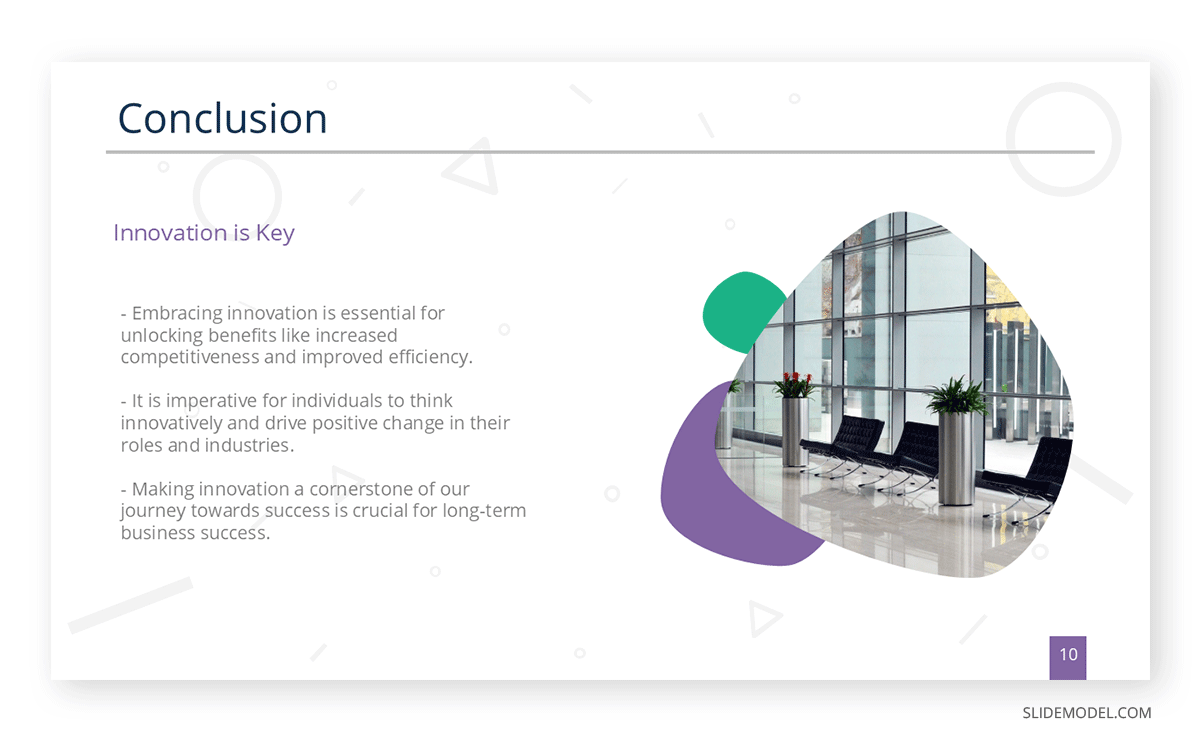
Get more insights on how to end a presentation with our article.
Although the presentation script is a fantastic resource for preparing your presentation and also for rehearsal, presenters cannot bring lengthy text pages with them and start reading if they feel lost. This is where presenter notes come in handy, and in this section, we’ll learn how to turn the presentation script into presenter notes.
The first step in this process is to go through the detailed script a couple of times, highlighting the main ideas, data, and messages to convey to the audience. You can follow the process as with meeting notes and apply the strategies explained in that article.
Now, we need to condense the information into simpler sentences, direct phrases, or keywords that trigger memory recall. These phrases will be added to the slides in the format of speaker notes linked to each slide. It’s crucial to mark the transitions from one topic to another in the presentation so we can articulate the speech or remember to emphasize a point.
Remember, if we suddenly need to include last-minute details, we can use visual cues or a printed version of our slides with extra handwritten notes.
Before we conclude this article, we want to recommend some PowerPoint templates that can help the presentation script creation process, especially for team collaboration, where the presentation goes through multiple iterations. Remember these designs also serve as Google Slides templates .
1. 6 Step Creative Timeline Diagram for Presentation Scripts
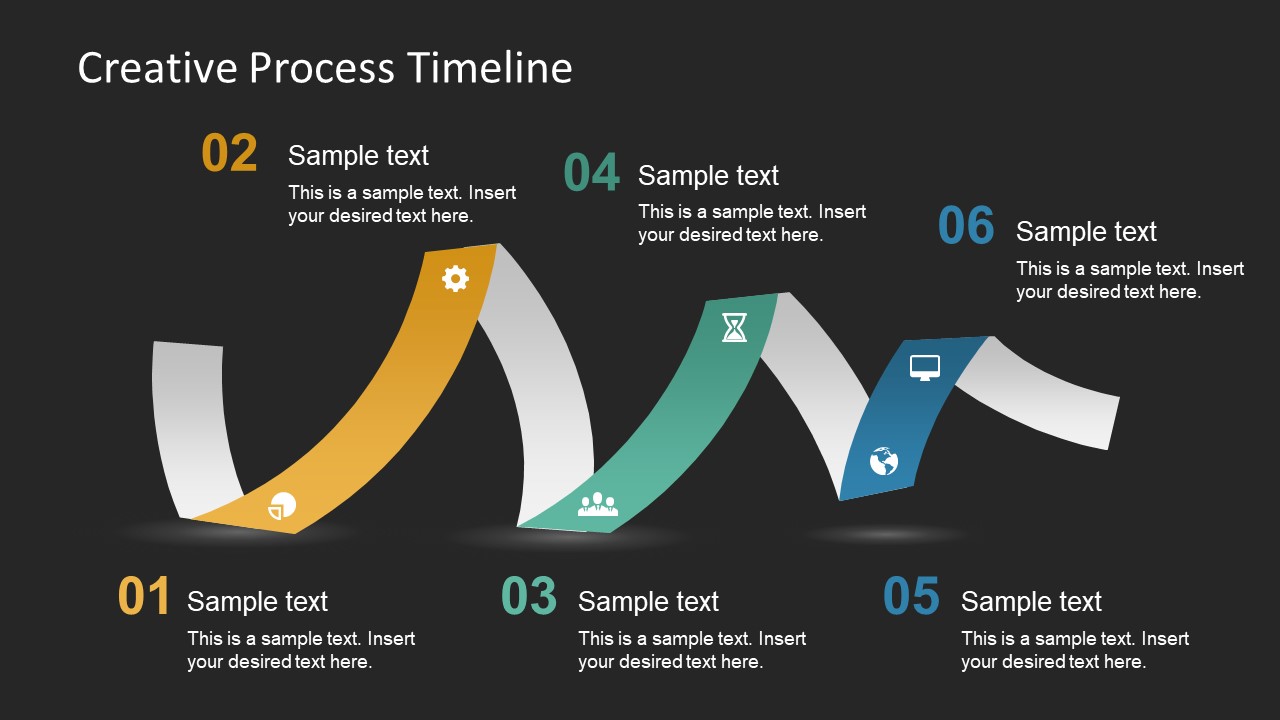
Say you need to create a sample script for a presentation or work with your team for a department presentation: this is where this best PPT template is beneficial. We can summarize processes or points that we intend the presentation to cover into six actionable steps that can be discussed within the team. The icons included help us to connect concepts with the steps we’re describing.
Use This Template
2. Product Timeline Script of Speech PPT Template

In sales and product presentations, we need to contextualize the dates on which we expect things to happen. By using this timeline PPT template as a visual aid, presenters can carry a printed version or digital version on another device to remind themselves of the milestones that a product or service is due in the near future.
3. The Presentation Experience Script PowerPoint Template
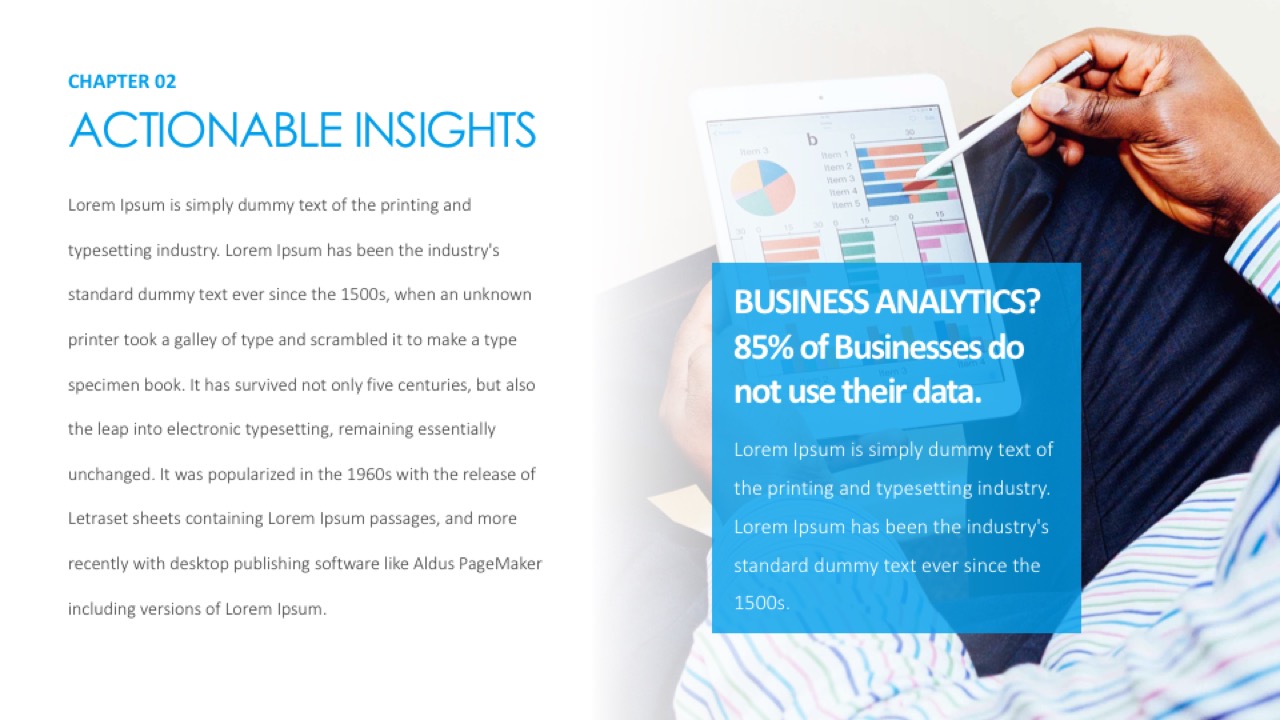
Although this template is tailored to sales presentations, this slide deck is ideal for writing a recap of the presentation script. You can add facts, questions, numeric data, and more.
4. Steps & Stairs Diagram Presentation Script Google Slides Template

This diagram template for PowerPoint and Google Slides is a highly visual 3D aid intended for defining the steps to write the script or to present processes. Use this staircase design template to summarize key information about your presentation speech.
Creating a detailed, professional presentation script doesn’t have to be a daunting process. As long as we understand the basis of how to structure what we intend to say, questions and answers about which content to include shall arise.
Follow the steps shown in this article and you will master the process to create your own presentation scripts in no time.
Like this article? Please share
Presentation Skills, Speech Filed under Presentation Ideas
Related Articles
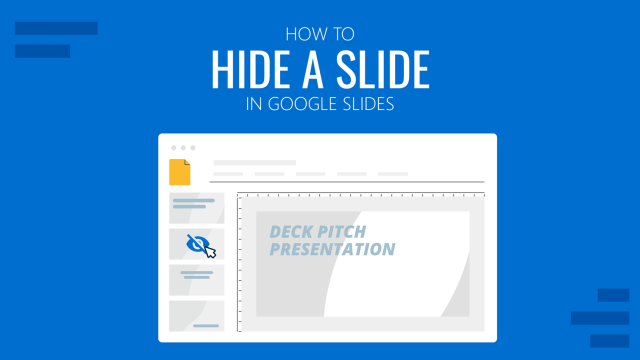
Filed under Google Slides Tutorials • July 25th, 2024
How to Hide a Slide in Google Slides
Hiding a slide in Google Slides is a task that takes less than a minute. Learn how to quickly implement this tool for your presentations in this article.
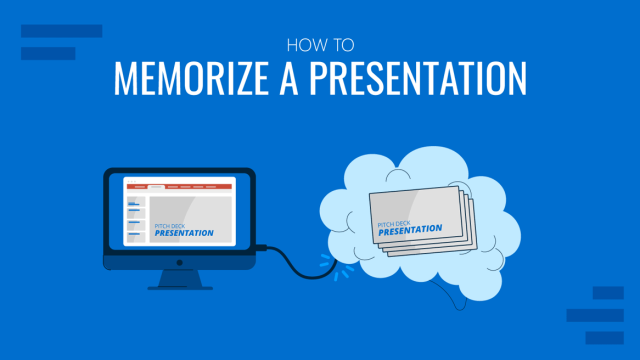
Filed under Education • July 10th, 2024
How to Memorize a Presentation: Guide + Templates
Become a proficient presenter by mastering the art of how to memorize a presentation. Nine different techniques + PPT templates here.

Filed under PowerPoint Tutorials • June 28th, 2024
How To Add Drop Shadows in PowerPoint Presentations
Improve your presentation’s design by mastering drop shadows in PowerPoint. In this article, we introduce you to the step-by-step process with cliparts for impressive shadow effects.
Leave a Reply
Reference management. Clean and simple.
How to write an excellent thesis conclusion [with examples]

Restate the thesis
Review or reiterate key points of your work, explain why your work is relevant, a take-away for the reader, more resources on writing thesis conclusions, frequently asked questions about writing an excellent thesis conclusion, related articles.
At this point in your writing, you have most likely finished your introduction and the body of your thesis, dissertation, or research paper . While this is a reason to celebrate, you should not underestimate the importance of your conclusion. The conclusion is the last thing that your reader will see, so it should be memorable.
A good conclusion will review the key points of the thesis and explain to the reader why the information is relevant, applicable, or related to the world as a whole. Make sure to dedicate enough of your writing time to the conclusion and do not put it off until the very last minute.
This article provides an effective technique for writing a conclusion adapted from Erika Eby’s The College Student's Guide to Writing a Good Research Paper: 101 Easy Tips & Tricks to Make Your Work Stand Out .
While the thesis introduction starts out with broad statements about the topic, and then narrows it down to the thesis statement , a thesis conclusion does the same in the opposite order.
- Restate the thesis.
- Review or reiterate key points of your work.
- Explain why your work is relevant.
- Include a core take-away message for the reader.
Tip: Don’t just copy and paste your thesis into your conclusion. Restate it in different words.
The best way to start a conclusion is simply by restating the thesis statement. That does not mean just copying and pasting it from the introduction, but putting it into different words.
You will need to change the structure and wording of it to avoid sounding repetitive. Also, be firm in your conclusion just as you were in the introduction. Try to avoid sounding apologetic by using phrases like "This paper has tried to show..."
The conclusion should address all the same parts as the thesis while making it clear that the reader has reached the end. You are telling the reader that your research is finished and what your findings are.
I have argued throughout this work that the point of critical mass for biopolitical immunity occurred during the Romantic period because of that era's unique combination of post-revolutionary politics and innovations in smallpox prevention. In particular, I demonstrated that the French Revolution and the discovery of vaccination in the 1790s triggered a reconsideration of the relationship between bodies and the state.
Tip: Try to reiterate points from your introduction in your thesis conclusion.
The next step is to review the main points of the thesis as a whole. Look back at the body of of your project and make a note of the key ideas. You can reword these ideas the same way you reworded your thesis statement and then incorporate that into the conclusion.
You can also repeat striking quotations or statistics, but do not use more than two. As the conclusion represents your own closing thoughts on the topic , it should mainly consist of your own words.
In addition, conclusions can contain recommendations to the reader or relevant questions that further the thesis. You should ask yourself:
- What you would ideally like to see your readers do in reaction to your paper?
- Do you want them to take a certain action or investigate further?
- Is there a bigger issue that your paper wants to draw attention to?
Also, try to reference your introduction in your conclusion. You have already taken a first step by restating your thesis. Now, check whether there are other key words, phrases or ideas that are mentioned in your introduction that fit into your conclusion. Connecting the introduction to the conclusion in this way will help readers feel satisfied.
I explored how Mary Wollstonecraft, in both her fiction and political writings, envisions an ideal medico-political state, and how other writers like William Wordsworth and Mary Shelley increasingly imagined the body politic literally, as an incorporated political collective made up of bodies whose immunity to political and medical ills was essential to a healthy state.
Tip: Make sure to explain why your thesis is relevant to your field of research.
Although you can encourage readers to question their opinions and reflect on your topic, do not leave loose ends. You should provide a sense of resolution and make sure your conclusion wraps up your argument. Make sure you explain why your thesis is relevant to your field of research and how your research intervenes within, or substantially revises, existing scholarly debates.
This project challenged conventional ideas about the relationship among Romanticism, medicine, and politics by reading the unfolding of Romantic literature and biopolitical immunity as mutual, co-productive processes. In doing so, this thesis revises the ways in which biopolitics has been theorized by insisting on the inherent connections between Romantic literature and the forms of biopower that characterize early modernity.
Tip: If you began your thesis with an anecdote or historical example, you may want to return to that in your conclusion.
End your conclusion with something memorable, such as:
- a call to action
- a recommendation
- a gesture towards future research
- a brief explanation of how the problem or idea you covered remains relevant
Ultimately, you want readers to feel more informed, or ready to act, as they read your conclusion.
Yet, the Romantic period is only the beginning of modern thought on immunity and biopolitics. Victorian writers, doctors, and politicians upheld the Romantic idea that a "healthy state" was a literal condition that could be achieved by combining politics and medicine, but augmented that idea through legislation and widespread public health measures. While many nineteenth-century efforts to improve citizens' health were successful, the fight against disease ultimately changed course in the twentieth century as global immunological threats such as SARS occupied public consciousness. Indeed, as subsequent public health events make apparent, biopolitical immunity persists as a viable concept for thinking about the relationship between medicine and politics in modernity.
Need more advice? Read our 5 additional tips on how to write a good thesis conclusion.
The conclusion is the last thing that your reader will see, so it should be memorable. To write a great thesis conclusion you should:
The basic content of a conclusion is to review the main points from the paper. This part represents your own closing thoughts on the topic. It should mainly consist of the outcome of the research in your own words.
The length of the conclusion will depend on the length of the whole thesis. Usually, a conclusion should be around 5-7% of the overall word count.
End your conclusion with something memorable, such as a question, warning, or call to action. Depending on the topic, you can also end with a recommendation.
In Open Access: Theses and Dissertations you can find thousands of completed works. Take a look at any of the theses or dissertations for real-life examples of conclusions that were already approved.

Have a language expert improve your writing
Run a free plagiarism check in 10 minutes, generate accurate citations for free.
- Knowledge Base
- Dissertation
How to Write a Thesis or Dissertation Conclusion
Published on September 6, 2022 by Tegan George and Shona McCombes. Revised on November 20, 2023.
The conclusion is the very last part of your thesis or dissertation . It should be concise and engaging, leaving your reader with a clear understanding of your main findings, as well as the answer to your research question .
In it, you should:
- Clearly state the answer to your main research question
- Summarize and reflect on your research process
- Make recommendations for future work on your thesis or dissertation topic
- Show what new knowledge you have contributed to your field
- Wrap up your thesis or dissertation
Instantly correct all language mistakes in your text
Upload your document to correct all your mistakes in minutes

Table of contents
Discussion vs. conclusion, how long should your conclusion be, step 1: answer your research question, step 2: summarize and reflect on your research, step 3: make future recommendations, step 4: emphasize your contributions to your field, step 5: wrap up your thesis or dissertation, full conclusion example, conclusion checklist, other interesting articles, frequently asked questions about conclusion sections.
While your conclusion contains similar elements to your discussion section , they are not the same thing.
Your conclusion should be shorter and more general than your discussion. Instead of repeating literature from your literature review , discussing specific research results , or interpreting your data in detail, concentrate on making broad statements that sum up the most important insights of your research.
As a rule of thumb, your conclusion should not introduce new data, interpretations, or arguments.
Receive feedback on language, structure, and formatting
Professional editors proofread and edit your paper by focusing on:
- Academic style
- Vague sentences
- Style consistency
See an example

Depending on whether you are writing a thesis or dissertation, your length will vary. Generally, a conclusion should make up around 5–7% of your overall word count.
An empirical scientific study will often have a short conclusion, concisely stating the main findings and recommendations for future research. A humanities dissertation topic or systematic review , on the other hand, might require more space to conclude its analysis, tying all the previous sections together in an overall argument.
Your conclusion should begin with the main question that your thesis or dissertation aimed to address. This is your final chance to show that you’ve done what you set out to do, so make sure to formulate a clear, concise answer.
- Don’t repeat a list of all the results that you already discussed
- Do synthesize them into a final takeaway that the reader will remember.
An empirical thesis or dissertation conclusion may begin like this:
A case study –based thesis or dissertation conclusion may begin like this:
In the second example, the research aim is not directly restated, but rather added implicitly to the statement. To avoid repeating yourself, it is helpful to reformulate your aims and questions into an overall statement of what you did and how you did it.
Your conclusion is an opportunity to remind your reader why you took the approach you did, what you expected to find, and how well the results matched your expectations.
To avoid repetition , consider writing more reflectively here, rather than just writing a summary of each preceding section. Consider mentioning the effectiveness of your methodology , or perhaps any new questions or unexpected insights that arose in the process.
You can also mention any limitations of your research, but only if you haven’t already included these in the discussion. Don’t dwell on them at length, though—focus on the positives of your work.
- While x limits the generalizability of the results, this approach provides new insight into y .
- This research clearly illustrates x , but it also raises the question of y .
Prevent plagiarism. Run a free check.
You may already have made a few recommendations for future research in your discussion section, but the conclusion is a good place to elaborate and look ahead, considering the implications of your findings in both theoretical and practical terms.
- Based on these conclusions, practitioners should consider …
- To better understand the implications of these results, future studies could address …
- Further research is needed to determine the causes of/effects of/relationship between …
When making recommendations for further research, be sure not to undermine your own work. Relatedly, while future studies might confirm, build on, or enrich your conclusions, they shouldn’t be required for your argument to feel complete. Your work should stand alone on its own merits.
Just as you should avoid too much self-criticism, you should also avoid exaggerating the applicability of your research. If you’re making recommendations for policy, business, or other practical implementations, it’s generally best to frame them as “shoulds” rather than “musts.” All in all, the purpose of academic research is to inform, explain, and explore—not to demand.
Make sure your reader is left with a strong impression of what your research has contributed to the state of your field.
Some strategies to achieve this include:
- Returning to your problem statement to explain how your research helps solve the problem
- Referring back to the literature review and showing how you have addressed a gap in knowledge
- Discussing how your findings confirm or challenge an existing theory or assumption
Again, avoid simply repeating what you’ve already covered in the discussion in your conclusion. Instead, pick out the most important points and sum them up succinctly, situating your project in a broader context.
The end is near! Once you’ve finished writing your conclusion, it’s time to wrap up your thesis or dissertation with a few final steps:
- It’s a good idea to write your abstract next, while the research is still fresh in your mind.
- Next, make sure your reference list is complete and correctly formatted. To speed up the process, you can use our free APA citation generator .
- Once you’ve added any appendices , you can create a table of contents and title page .
- Finally, read through the whole document again to make sure your thesis is clearly written and free from language errors. You can proofread it yourself , ask a friend, or consider Scribbr’s proofreading and editing service .
Here is an example of how you can write your conclusion section. Notice how it includes everything mentioned above:
V. Conclusion
The current research aimed to identify acoustic speech characteristics which mark the beginning of an exacerbation in COPD patients.
The central questions for this research were as follows: 1. Which acoustic measures extracted from read speech differ between COPD speakers in stable condition and healthy speakers? 2. In what ways does the speech of COPD patients during an exacerbation differ from speech of COPD patients during stable periods?
All recordings were aligned using a script. Subsequently, they were manually annotated to indicate respiratory actions such as inhaling and exhaling. The recordings of 9 stable COPD patients reading aloud were then compared with the recordings of 5 healthy control subjects reading aloud. The results showed a significant effect of condition on the number of in- and exhalations per syllable, the number of non-linguistic in- and exhalations per syllable, and the ratio of voiced and silence intervals. The number of in- and exhalations per syllable and the number of non-linguistic in- and exhalations per syllable were higher for COPD patients than for healthy controls, which confirmed both hypotheses.
However, the higher ratio of voiced and silence intervals for COPD patients compared to healthy controls was not in line with the hypotheses. This unpredicted result might have been caused by the different reading materials or recording procedures for both groups, or by a difference in reading skills. Moreover, there was a trend regarding the effect of condition on the number of syllables per breath group. The number of syllables per breath group was higher for healthy controls than for COPD patients, which was in line with the hypothesis. There was no effect of condition on pitch, intensity, center of gravity, pitch variability, speaking rate, or articulation rate.
This research has shown that the speech of COPD patients in exacerbation differs from the speech of COPD patients in stable condition. This might have potential for the detection of exacerbations. However, sustained vowels rarely occur in spontaneous speech. Therefore, the last two outcome measures might have greater potential for the detection of beginning exacerbations, but further research on the different outcome measures and their potential for the detection of exacerbations is needed due to the limitations of the current study.
Checklist: Conclusion
I have clearly and concisely answered the main research question .
I have summarized my overall argument or key takeaways.
I have mentioned any important limitations of the research.
I have given relevant recommendations .
I have clearly explained what my research has contributed to my field.
I have not introduced any new data or arguments.
You've written a great conclusion! Use the other checklists to further improve your dissertation.
If you want to know more about AI for academic writing, AI tools, or research bias, make sure to check out some of our other articles with explanations and examples or go directly to our tools!
Research bias
- Survivorship bias
- Self-serving bias
- Availability heuristic
- Halo effect
- Hindsight bias
- Deep learning
- Generative AI
- Machine learning
- Reinforcement learning
- Supervised vs. unsupervised learning
(AI) Tools
- Grammar Checker
- Paraphrasing Tool
- Text Summarizer
- AI Detector
- Plagiarism Checker
- Citation Generator
In a thesis or dissertation, the discussion is an in-depth exploration of the results, going into detail about the meaning of your findings and citing relevant sources to put them in context.
The conclusion is more shorter and more general: it concisely answers your main research question and makes recommendations based on your overall findings.
While it may be tempting to present new arguments or evidence in your thesis or disseration conclusion , especially if you have a particularly striking argument you’d like to finish your analysis with, you shouldn’t. Theses and dissertations follow a more formal structure than this.
All your findings and arguments should be presented in the body of the text (more specifically in the discussion section and results section .) The conclusion is meant to summarize and reflect on the evidence and arguments you have already presented, not introduce new ones.
For a stronger dissertation conclusion , avoid including:
- Important evidence or analysis that wasn’t mentioned in the discussion section and results section
- Generic concluding phrases (e.g. “In conclusion …”)
- Weak statements that undermine your argument (e.g., “There are good points on both sides of this issue.”)
Your conclusion should leave the reader with a strong, decisive impression of your work.
The conclusion of your thesis or dissertation shouldn’t take up more than 5–7% of your overall word count.
The conclusion of your thesis or dissertation should include the following:
- A restatement of your research question
- A summary of your key arguments and/or results
- A short discussion of the implications of your research
Cite this Scribbr article
If you want to cite this source, you can copy and paste the citation or click the “Cite this Scribbr article” button to automatically add the citation to our free Citation Generator.
George, T. & McCombes, S. (2023, November 20). How to Write a Thesis or Dissertation Conclusion. Scribbr. Retrieved August 21, 2024, from https://www.scribbr.com/dissertation/write-conclusion/
Is this article helpful?
Tegan George
Other students also liked, how to write a discussion section | tips & examples, how to write an abstract | steps & examples, how to write a thesis or dissertation introduction, what is your plagiarism score.
How to Write a Short Bio for a Presentation: A Step-by-Step Guide
Learn to craft a compelling short bio for presentations, enhancing credibility and audience engagement with these expert tips.
Understanding the Purpose of Your Bio
Establishing credibility, connecting with your audience, setting the tone, key elements of a short bio for presentations, 1. start with your name and current role, 2. highlight relevant qualifications and achievements, 3. mention noteworthy projects or roles, 4. add a personal touch, 5. tailor your bio to the audience and occasion, crafting your bio: writing tips, keep it concise, use third person, be professional yet approachable, edit ruthlessly, create ppt using ai.
Just Enter Topic, Youtube URL, PDF, or Text to get a beautiful PPT in seconds. Use the bulb for AI suggestions.
character count: 0 / 6000 (we can fetch data from google)
upload pdf, docx, .png
less than 2 min
Mehjabi Khan
How to Make a Good Pitch Presentation
23 August 2024
How to Write a Presentation Speech: A Step-by-Step Guide
How to Title a PowerPoint Presentation: For the Perfect First Impression
How to Generate Presentation Ideas for School: A Complete Guide
What Is a Presentation Outline? A Complete Guide
How to Memorize a Presentation in One Night?
What is a Sales Presentation? Unpacking Its Role and Impact in Business
Real Estate Listing Presentation: Essential Points to Address for Success
When Giving a Presentation, What Is a Good Tactic for Engaging the Audience?
Stunning presentations in seconds with AI
Install MagicSlides app now and start creating beautiful presentations. It's free!

Get AI-Generated Presentations Ready in Seconds
Free AI PPT Tools
- Project management Track your team’s tasks and projects in Hive
- Time tracking Automatically track time spent on Hive actions
- Goals Set and visualize your most important milestones
- Resourcing Track time and assign teammates to projects
- Forms Gather feedback, project intake, client requests and more
- Proofing & Approvals Streamline design and feedback workflows in Hive
- See all features
- Analytics Gain visibility and gather insights into your projects
- Automations Save time by automating everyday tasks
- Hive Apps Connect dozens of apps to streamline work from anywhere
- Integrations Sync Hive with your most-used external apps
- Templates Quick-start your work in Hive with pre-built templates
- Download Hive Access your workspace on desktop or mobile
- Project management Streamline initiatives of any size & customize your workflow by project
- Resource management Enable seamless resourcing and allocation across your team
- Project planning Track and plan all upcoming projects in one central location
- Time tracking Consolidate all time tracking and task management in Hive
- Cross-company collaboration Unite team goals across your organization
- Client engagement Build custom client portals and dashboards for external use
- All use cases
- Enterprise Bring your organization into one unified platform
- Agency Streamline project intake, project execution, and client comms
- University Marketing Maximize value from your marketing and admissions workflows with Hive
- Nonprofits Seamless planning, fundraising, event execution and more
- Marketing Streamline your marketing projects and timelines
- Business operations Track and optimize strategic planning and finance initiatives
- Education Bring your institutions’ planning, fundraising, and more into Hive
- Design Use Hive to map out and track all design initiatives and assets
- On-demand demo Access a guided walk through Hive
- Customers More on how Teams are using Hive now
- FAQ & support articles Find answers to your most asked questions
- Hive University Become a Hive expert with our free Hive U courses
- Webinars Learn about Hive’s latest features
- Hive Community Where members discuss and answer questions in the community
- Professional Services Get hands-on help from our Professional Services team
- Hive Partners Explore partners services or join as a partner
- FEATURED WEBINAR
Hive 101 for Managers
Designed solely for workspace leaders, the Hive Team dives into advanced features like Dashboards, Resourcing, and Approvals to can help you manage your team more effectively.
- Request Demo
- Get Started
How To Write A Great Agenda | Meeting Agenda Template
- Michaela Rollings
- August 23, 2024
Table of Contents
Meetings are an essential part of professional life , allowing teams to come together, collaborate, and make important decisions. As we migrated from in-office primarily to hybrid and remote work , meetings and proper meeting agendas have become even more important.
However, without proper planning and structure, meetings can quickly become unproductive and time-consuming. This is where meeting agendas play a crucial role in ensuring that meetings are efficient, focused, and productive.
What is a Meeting Agenda?
A meeting agenda serves as a roadmap for the discussion, outlining the topics to be covered, the objectives of the meeting, and the expected outcomes. By establishing a clear agenda before the meeting, participants can come prepared and have a better understanding of what is expected of them.
This helps to keep the meeting on track and ensures that time is used effectively – there’s nothing worse than a meeting that could’ve been an email!!!
A meeting agenda typically has a few components:
- Meeting goals
- Meeting attendees and time
- Meeting format
- Supporting documents
- Action items
- Space for follow-ups
Every team is going to have different processes for meetings and agendas, typically teams will place this agenda in the calendar invite. But better yet, you can use something like Hive Notes that can connect directly to your Zoom meeting and contain all of your necessary items.
Types of Agenda Templates
There are also several types of meeting agenda templates that can be used and leveraged by teams, a few of the most popular.
- Project Kickoff Meeting Agenda Template
- Weekly Team Meeting Agenda Template
- 1 on 1 Meeting Agenda Template
- Formal Meeting Agenda Template
Why Are Meeting Agenda Templates Important?
Meeting agenda templates are a valuable tool for organizing and conducting successful business meetings. These templates provide a structured outline of what topics will be covered during the meeting, ensuring that everyone is on the same page and that time is used efficiently.
One of the key benefits of using meeting agenda templates is that they help to create a sense of focus and direction for the meeting. By outlining the specific topics that will be discussed and the order in which they will be addressed, participants can come prepared and ready to contribute to the discussion. This can help to prevent off-topic conversations and ensure that the meeting stays on track.
Establishing Expectations
A meeting template also help to establish expectations for the meeting. By clearly outlining the objectives and goals of the meeting, participants can understand what needs to be accomplished and can work towards achieving those goals within the allotted time frame. This can help to reduce confusion and ensure that everyone is on the same page.
Valuable Reference Tool
In addition, a great agenda template can also serve as a valuable reference tool. By documenting the key points and decisions made during the meeting, the template can be used to track progress and hold participants accountable for their actions and follow-up tasks. It’s a win-win for all involved – and can be used as a format for outlining in-meeting notes and next steps.
Creating The Perfect Meeting Template
Like we mentioned before, Hive Notes are a great place to start pulling together your meeting agenda template. A great part about Hive Notes is that we also have AI integrated, so you can literally just ASK AI to make your perfect meeting agenda template.
To do that, first open up Hive Apps -> Notes. From there, use the blue “+” sign and scroll to HiveMind Assist.
From there, you can just ask Hive Mind to write the perfect meeting agenda template based on the items you drop into the prompt.
Here’s the meeting agenda template that Hive Mind gave us…
The best part?? Hive will do all of the work for you, creating a perfect meeting template that can be modified and customized. Once you’ve got that format and template set, you can continue to make changes or save it as a template. From then on, you can reference this meeting agenda template any time you have a new meeting.
In Conclusion
Overall, meeting agenda templates are an essential tool for effective meeting management, helping to ensure that meetings are productive, efficient, and successful. Whether you’re looking for a project kick-off meeting agenda template, a simple meeting agenda template, a 1 on 1 meeting template, we can get you exactly what you need.
There’s no easier way to create a meeting agenda template than by using Hive to do the work for you. Once your meeting agenda template has been set, you can share that note with teammates or external parties before or after your meeting.
During the meeting, you can also add next steps directly to the note and turn your meeting agenda template into a living, breathing document. You can also add comments, images, and more.
Have feedback for us? Let us know by emailing [email protected]
Want to spread the word share on social, get started with hive.
Test Hive out with a 2 week free trial.
Terms of Service
Privacy Policy
© 2015 – 2024 HIVE® GLOBAL INC.
How to Connect MySQL Workbench to MySQL Server on Linux
Last updated: August 23, 2024
- Administration
We’ve started a new DevOps area on the site. If you’re interested in writing about DevOps, check out the Contribution Guidelines .
1. Overview
MySQL Workbench is a powerful visual application that’s popular for its usability in MySQL development, database administration, and data modeling. If we want to use it with a MySQL server on a Linux system, the primary step that we have to carry out is to establish a connection between this utility and the server. However, the method for establishing a connection between the two can be tricky.
In this tutorial, we’ll navigate through the step-by-step process of connecting MySQL Workbench to MySQL server on Linux . Notably, we’ll perform this operation on Ubuntu. However, the same process can apply to other distributions as well.
2. Prerequisites
Before we begin, let’s make sure that we have access to a MySQL server.
Moreover, we make use of two main pieces of information :
- hostname or IP address of the MySQL server
- MySQL account username and password
Once ready with the above, we start the process.
3. Downloading and Installing MySQL Workbench
To begin with, we download and install the MySQL Workbench application on the machine . For that, we go to the official MySQL Community Downloads page and download the utility from there as a .deb file.
Next, let’s navigate to the location where the downloaded .deb file is stored:
Then, let’s use the dpkg command with the -i option, short for –install , to install MySQL Workbench on the device via the .deb file:
Once we hit Return , the installation process commences.
However, we usually encounter an error during the process stemming from the fact that we don’t have the required dependencies on the system .
To fix this error, we run another command:
The apt command with the -f option, short for –fix-broken , installs all the missing dependencies and finishes the installation of MySQL Workbench on the machine.
4. Connecting MySQL Workbench to a Server
In this section, we connect the MySQL Workbench application to the MySQL server that we have access to.
To start, we open the newly installed MySQL Workbench on the machine. On the home screen that appears, we click on the plus (+) icon to start setting up a new connection:

Upon clicking the icon, a new window appears. Here, we can fill in all the necessary details to connect this application to the MySQL server:
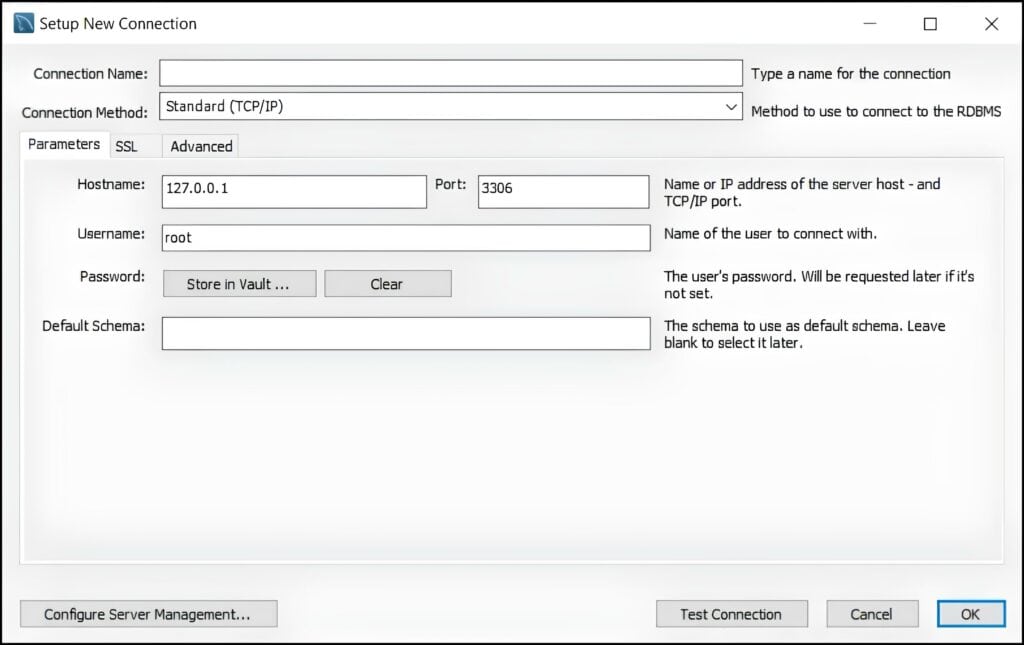
Visibly, there are quite a number of fields that we can fill up:
- Connection Name : the connection name that we want to use, i.e., MySQL in this case
- Connection Method : the connection method that we want to use, i.e., Standard (TCP/IP) (default) in this case
- Hostname : the hostname or IP address of the server, i.e., 127.0.0.1 (default) in this case
- Port : the TCP/IP port of the server, i.e., 3306 (default) in this case
- Username : the username of the MySQL account that we want to use, i.e., baeldung in this case
- Password : the password of the MySQL account that we want to use
On top of the above, we leave the remaining field, i.e., Default Schema blank.
After making the changes, let’s click on the Test Connection button to test if the connection is established. Once the testing is complete, we get a message indicating the status of the connection:

As we can see above, the connection has been made successfully.
Next, let’s click on OK to finish setting up the connection between MySQL Workbench and the MySQL server.
5. Running a Query in MySQL Workbench
Since the setup is now complete, the newly created connection is listed on the home screen . We just click on it to launch the MySQL editor for the connection.
Finally, let’s run a simple query in the editor that returns all the columns from the city table in the world database:

Evidently, the output lists all the columns from the specified table, indicating that everything is working correctly.
6. Conclusion
In this article, we had a detailed discussion on how to connect MySQL Workbench to MySQL server on Linux. The process can be a bit challenging, but following this guide should help create a connection between the two.

IMAGES
COMMENTS
30 Example Phrases: How to Conclude a Presentation. 1. "In summary, let's revisit the key takeaways from today's presentation.". 2. "Thank you for your attention. Let's move forward together.". 3. "That brings us to the end. I'm open to any questions you may have.".
Give your audience actions to help share your message. 7. Promote your upcoming events or workshops. 8. Asking your audience to become a volunteer. 9. Direct your audience to learn more about your website. 10. If you are a book author, encourage your audience to engage with your book.
Here are some tips for using a story to conclude a presentation: Make sure the story is brief. Choose a story that relates to the main points of the presentation. Stories about a customer experience or successful case study are effective. Make sure the story is relatable and encourages empathy from your audience. 7.
3. Call-to-action. Don't forget to include a compelling call to action in your final message that motivates the audience to take specific steps after the presentation. Whether it's signing up for a newsletter, trying a product or conducting further research, a clear call to action can encourage engagement.
But how you end it can make all the difference in your presentation's overall impact. Here are some ways to ensure you end powerfully: Way #1: Include a Strong Call-to-Action (CTA) Way #2: Don't End With a Q&A. Way #3: End With a Memorable Quote. Way #4: Close With a Story. Way #5: Drive Your Main Points Home.
Though there are many ways to end a presentation, the most effective strategies focus on making a lasting impression on your audience and reinforcing your goals. So, let's take a look at three effective ways to end a presentation: 1. Summarize the Key Takeaways. Most presenters either make an argument (i.e. they want to convince their ...
At the end of a presentation, you typically say a few key things: Summarize your main points or key takeaways to reinforce the message. Provide a clear call to action, motivating your audience to take specific steps. Express gratitude and thank your audience for their time and attention.
Importance of ending presentation on a positive note. 01Leaving a Lasting Impression: Ending your presentation on a high note ensures that your audience remembers your key points, contributing to a lasting impression that lingers beyond the session. A strong conclusion cements your message in their minds.
This helps create a good long-lasting impression of your presentation. 4. End with a Call to action: One of the best ways to end your presentation is by concluding with a call to action slide. Incorporating a call to action into your presentation can be a powerful way to encourage your audience to take the next step.
So, in conclusion, brevity in public speaking is pretty important. In fact, George Orwell once said, "If it is possible to cut a word out of your speech, always cut it out.". So, when you create a presentation, cut the fluff. Cut the repetitive bullets. Cut the platitudes.
Presentation end: 7 examples to leave a lasting impression. Summarize the main points: Repeat the main points of your presentation to reinforce them. Call-to-action: Ask your audience to perform a specific action or take a next step. Quote: A relevant and powerful quote can leave a lasting impression. Story or anecdote: A short, relevant story ...
Decide on Your Close. The first step is to decide what type of close and call to action you'll use for your presentation. For the purposes of this tutorial, I'll use a persuasive close with numbers that back up the ideas presented in the presentation. Slide #13 from the Yukee template fits perfectly for this occasion.
3 Strategies to Close Your Presentation Powerfully. Use these 3 strategies in your conclusion to: recapture your audience's attention. get your audience to focus and remember your key points. help your audience connect with you and your topic. end your presentation powerfully. One: Include a Call to Action (CTA)
5. End Your Speech Using the Rule of Three. A communication technique called the Rule of Three is a powerful way to end your speech. Using this technique to end your presentation will make your key message stick. An example of the Rule of Three is this Winston Churchill quote, "This is not the end. It is not even the beginning of the end.
The Role of Presentation Conclusions . When a presentation draws to a close, the audience is most vulnerable to lasting impressions. The conclusion of a discussion is the critical juncture where the narrative converges, and the concepts and ideas crystallize into a final robust takeaway. A well-crafted conclusion can help a professional to etch ...
An effective conclusion will do three things. Offer a clear ACTION STEP. Sum up the presentation with one BIG IDEA. CEMENT the idea with a compelling story or data point. It's as simple as ABC: Action step, Big Idea, Cement with a story. How you end will determine if your audience leaves feeling inspired or indignant.
A strong conclusion is the pinnacle of a presentation, leaving a lasting impression on the audience. It summarizes key points, reinforces the main message, and prompts action. A strong end not only solidifies understanding but also fosters engagement, ensuring that the audience retains and acts upon the presented information. Today we'll explore tips for ending a presentation with a strong ...
Some things you can say include: [1] "In conclusion…". "In summary…". "As I conclude my presentation, let me ask you a question.". "This brings me to the end of my presentation today.". "In respect of time, allow me to wrap up my last comments.". Provide a quick and concise summary of the presentation's key points.
Include a final question for discussion on your "conclusion" slide if you plan to end your presentation with audience involvement, such as a question-and-answer session. Otherwise, you might conclude with a lighthearted joke. Choose a joke, memorable analogy or experience that's appropriate for your audience and fits the tone and mood of your ...
Click on captions to see subtitles in English.This video is found in the following subject: University English Self Study (UESS). Watch the video to see an e...
Table of contents. Step 1: Restate the problem. Step 2: Sum up the paper. Step 3: Discuss the implications. Research paper conclusion examples. Frequently asked questions about research paper conclusions.
Step 1: Return to your thesis. To begin your conclusion, signal that the essay is coming to an end by returning to your overall argument. Don't just repeat your thesis statement —instead, try to rephrase your argument in a way that shows how it has been developed since the introduction. Example: Returning to the thesis.
Developing a Memorable Conclusion. The conclusion is your final opportunity to reinforce your core message and leave a lasting impression on your audience. A strong conclusion should: ... Recommended PPT Templates to Write a Presentation Script. Before we conclude this article, ...
A good conclusion will review the key points of the thesis and explain to the reader why the information is relevant, applicable, or related to the world as a whole. Make sure to dedicate enough of your writing time to the conclusion and do not put it off until the very last minute. Organize your papers in one place. Try Paperpile.
Step 1: Answer your research question. Step 2: Summarize and reflect on your research. Step 3: Make future recommendations. Step 4: Emphasize your contributions to your field. Step 5: Wrap up your thesis or dissertation. Full conclusion example. Conclusion checklist. Other interesting articles.
How to Write a Short Bio for a Presentation: A Step-by-Step Guide. Learn to craft a compelling short bio for presentations, enhancing credibility and audience engagement with these expert tips. ... Conclusion. Your bio is not just a summary of your professional life; it is a crucial element of your presentation that helps to set the tone and ...
Conclusion. In this article, we explored the ins and outs of writing OR logic in Elasticsearch's filter context. We started by understanding the fundamental difference between query and filter contexts. Then, we dove into the concept of OR operations in Elasticsearch, exploring various ways to implement OR logic in Elasticsearch queries. ...
In Conclusion. Overall, meeting agenda templates are an essential tool for effective meeting management, helping to ensure that meetings are productive, efficient, and successful. Whether you're looking for a project kick-off meeting agenda template, a simple meeting agenda template, a 1 on 1 meeting template, we can get you exactly what you ...
Write a Good Hook—and Get to It Promptly. Returning to the comparison between opening statements and movie trailers, both need a good hook. For trailers, that might be a tagline or a memorable image. But for opening statements, the hook is the presentation of your theme.
In this section, we connect the MySQL Workbench application to the MySQL server that we have access to. To start, we open the newly installed MySQL Workbench on the machine. On the home screen that appears, we click on the plus (+) icon to start setting up a new connection:. Upon clicking the icon, a new window appears.